21. THE TROUBLED 21st CENTURY

OBAMA AND THE WORLD
CONTENTS
 Obama and the Arab world Obama and the Arab world
 The takedown of bin Laden (2011) The takedown of bin Laden (2011)
 The "Arab Spring" (2011) The "Arab Spring" (2011)
 Action in Libya against Gaddafi Action in Libya against Gaddafi
 Action in Syria against Assad Action in Syria against Assad
 Russia and Ukraine Russia and Ukraine
 Xi's China Xi's China
 Iran Iran
The textual material on page below is drawn directly from my work
A Moral History of Western Society © 2024, Volume Two, pages 403-413.
|
Obama's "New Beginning" challenge to the Arab world (2009)
Actually, Obama tried to appear more centrist … and seemingly more
interested in America's position internationally than in playing a role
in the midst of America's ongoing cultural wars. He focused
particularly on the Middle East – trying to "change" Arab perceptions
of America. In June of 2009 he went to Cairo to deliver an address
inviting a more respectful dialogue between Christians and Muslims.
Obama was strongly Christian, but had also lived at length in his youth
in Muslim Indonesia … and cited that fact as part of his desire to win
Muslim hearts back to America.
|
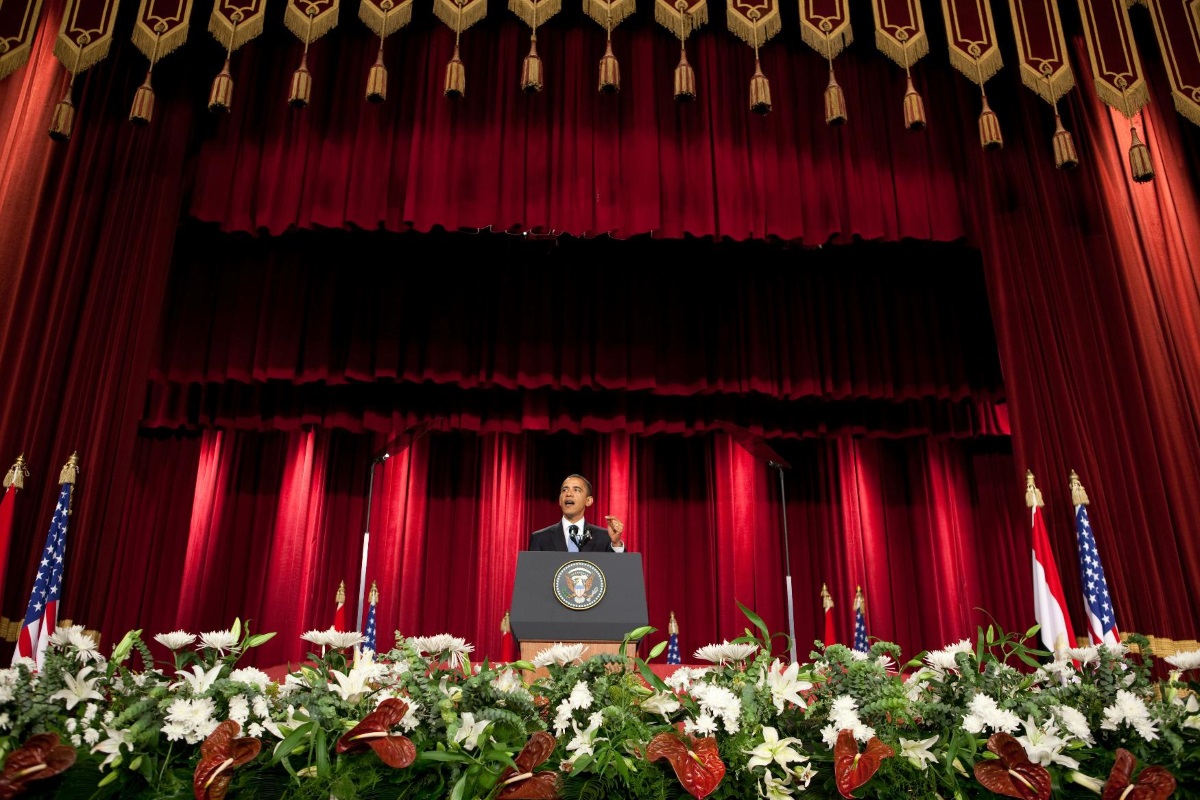
Obama's Cairo speech to the
Muslim world (June 2009)
inviting the Muslims to seek a "new beginning" ... citing his own Indonesian experience
and personal family background in Islam and noting the distinction between peaceful Muslims
and violent extremists, declaring that "this cycle of suspicion and discord must
end"

|
Iraq
He also announced early on that America would be drawing down even more
troops from Iraq than had Bush during his last days in office. All
American troops were now scheduled to be out of Iraq by 2011. He would
do so … but then – at Iraq's request – have to return troops to Iraq in
2014 due to new problems arising in the region.
With (or even because of) the American troop drawdown, things in Iraq
stalled politically – as the various groups and their representatives
in the Iraqi Assembly went for months after an election in March of
2010, unable to design a ruling coalition for the country. Ayad
Allawi's Iraqiya Party had the largest representation in the Assembly
(90 seats) … though far from a majority. Allawi was a Shi'ite
"moderate" – willing to bring Sunnis into a ruling coalition.
Undoubtedly, he was the candidate the West was hoping would be able to
get things under control and moving forward in Iraq. But the incumbent
Shi'ite hardliner Nouri al-Maliki and his Islamic Dawa Party (with 89
seats) was insistent that any coalition had to have al-Maliki remain in
place as prime minister. Finally in December, 9 months since the
election, Allawi's party took the pressure to join in coalition with
al-Malaki, with al-Malaki remaining prime minister.
Indeed, with the American pullout, things quickly got "back to normal"
… when in October of 2012, Iraqi Vice President al-Hashemi, escaped to
Turkey in anticipation of his being sentenced to death for the crime
(quite false) of inciting most of the violence that still shook Iraq.
Actually, his real crime was that he was Sunni … and the al-Maliki
government was dead-set against the Sunni's having any significant
voice in the governance of Iraq. The only real outcome of all this was
that the sentence stirred the deep anger (and accompanying violence) of
Iraq's Sunni community, both Arab and Kurd. But it also served to
worsen Iraq's relations with its Sunni neighbors, Saudi Arabia, Qatar
and Turkey. But, of course, it all played to the delight of Shi'ite
Iran. And so things "progressed" in that part of the Middle East.
|
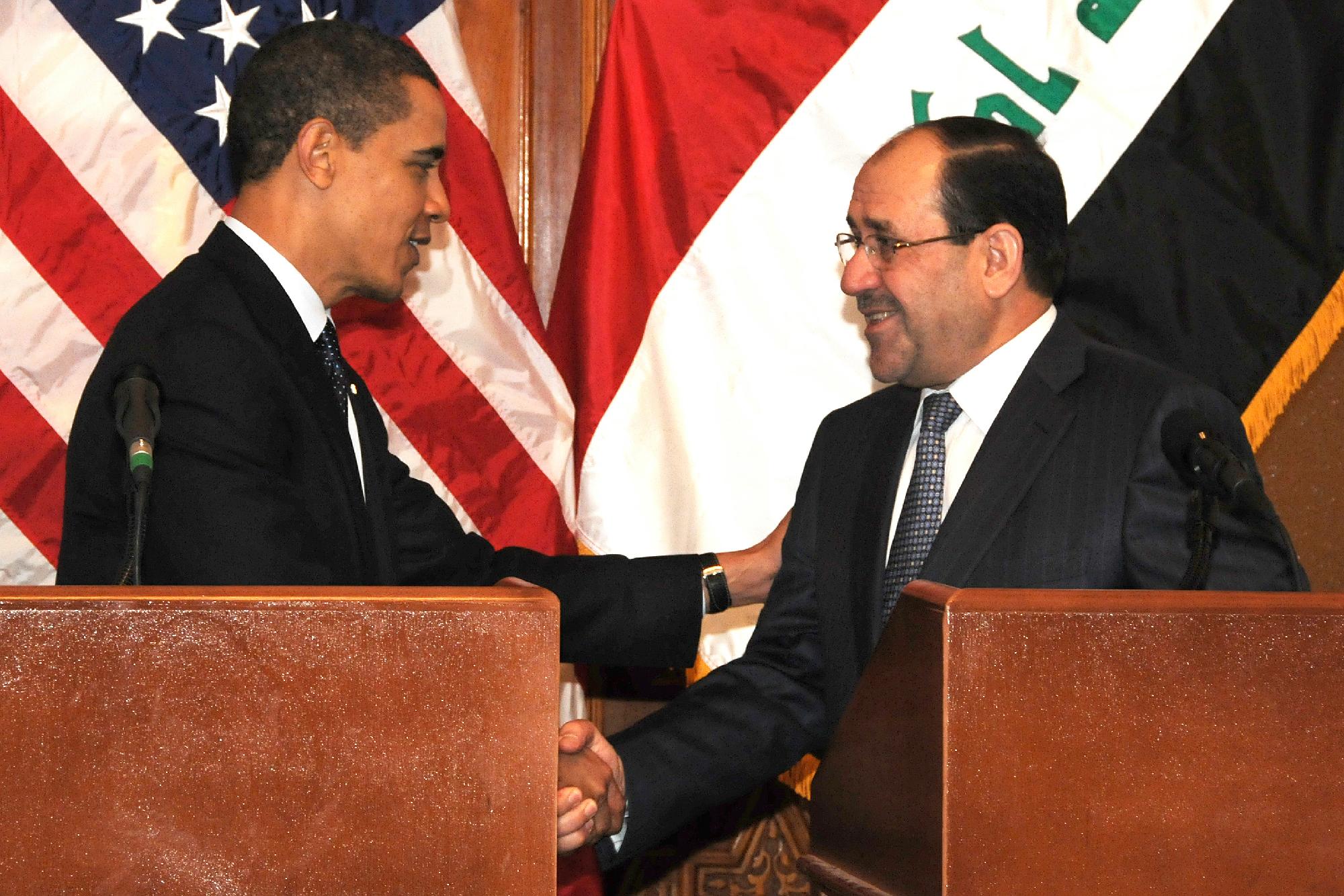
President Barack Obama shakes
hands with Iraqi Prime Minister Nouri al-Maliki after a joint press event
on Camp Victory, Iraq, April 7, 2009.
Obama spoke to hundreds
of
U.S. troops during his surprise visit to Iraq to thank them for their
service.

The Iraqi vice president
Tariq al-Hashemi and his son are sentenced to death in absentia
(September
9, 2012)
|
Afghanistan
But seeing the situation in Afghanistan worsen, soon after taking
office as president, Obama announced that America would not be pulling
its troops of out Afghanistan, but instead, would follow the successful
program in Iraq – of conducting a "surge" of American troops (17,000
more) in Afghanistan.
But the Taliban simply pulled back (mostly back into Pakistan) to wait
to see how long this "surge" was going to last. Thus there was no
immediate serious "progress" that the American troops surge was able to
accomplish. There was no way – with Pakistan (which America would not
or even could not touch) willing to offer sanctuary to the Taliban –
that America was going to be able to destroy or even cripple the
Taliban. And indeed, America-backed Afghan president Karzai began to
negotiate with the Taliban … even suggesting that America do the same.
Any kind of peace and stability in Afghanistan was going to have to
respect Taliban power in some form or other.
But Obama's response that December was to announce the deployment of
yet another 30,000 soldiers to Afghanistan. But most strangely, he also
announced that he would then, the following July (2010), begin troop
withdrawals from Afghanistan. This of course confused deeply the Karzai
government. It also gave the Taliban even more reason to simply wait
out Obama – until the Americans drew their numbers back down … once
again allowing the Taliban to regain lost territory – and then some.
None of this American "strategy" therefore made any sense.
|
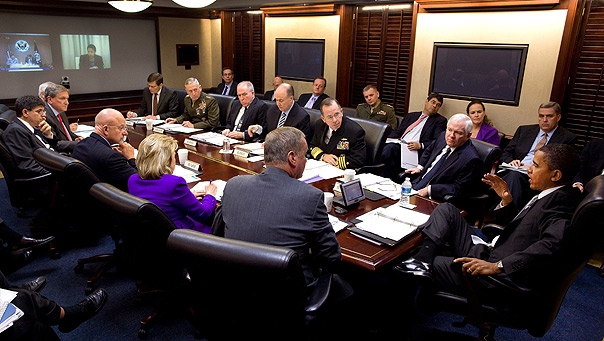
Oct. 20, 2010: President
Obama meets with his national security team on Afghanistan and
Pakistan in the Situation Room.
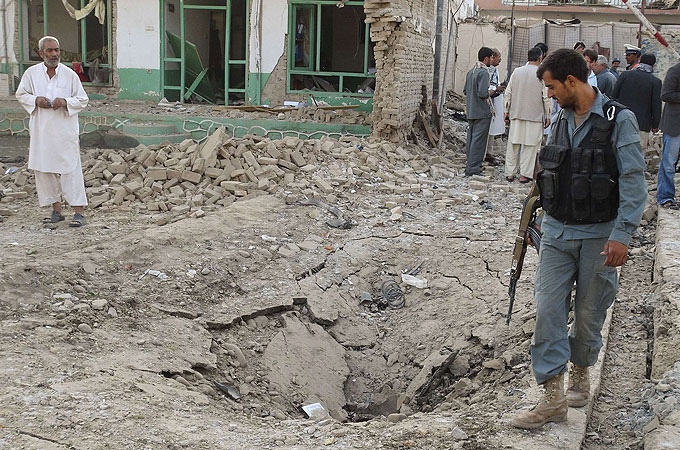
At least four die from a
Taliban attack on guest house frequented by foreigners
in the formerly
quiet Kunduz province – August 2,
2011
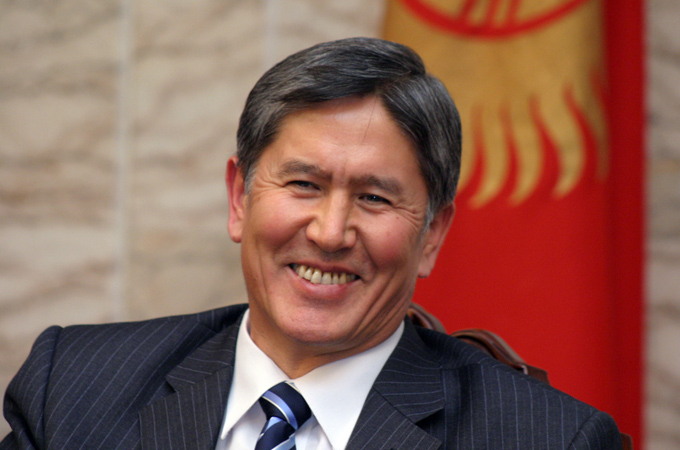
President Atambayev of
Afghanistan's
neighbor Kyrgyzstan (took office on December 1, 2011) is demanding the closing
of the American Manas air base in
his country by 2014. It was
opened in 2001 to support US military operations
in Afghanistan. Obama had the American
troops vacate the airbase in June of
2014.
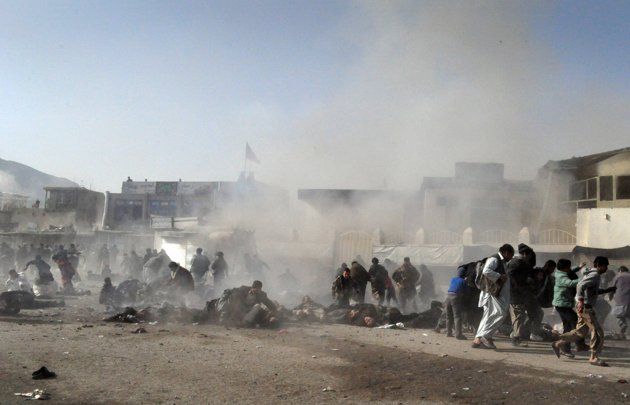
A bomb is exploded among
Shi'ite worshipers – December 6, 2011. 60 people killed (20 more would
eventually die)
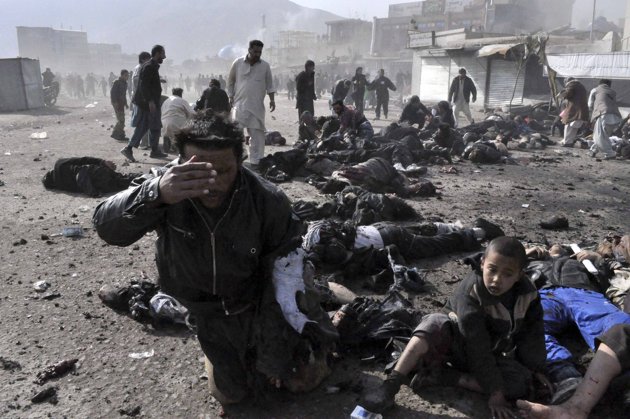
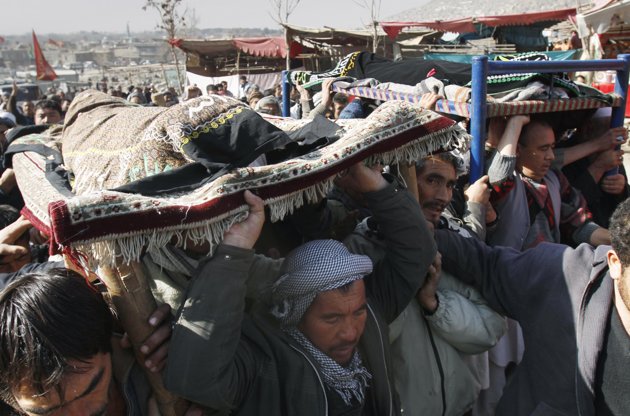
THE TAKEDOWN OF BIN LADEN (2011) |
|
Osama bin Laden is finally killed (May 2011)
On the night of May 7th, a Navy SEAL team was dropped by two Black Hawk
helicopters into a compound in Pakistan at Abbottabad (near the
Pakistani Military Academy) where Osama bin Laden was living … and
carried out his execution – and then took his body to be buried in the
Arabian Sea.
While the West cheered the outcome, the Arab world largely did not.
And the Pakistanis were most upset … especially over this matter of who
was – and who was not – even aware of bin Laden's presence in
Abbottabad … and why the Pakistani authorities were so blindsided by
this American action undertaken in their country.
But in any case, something that should have been done ten years earlier
– rather than making Afghanistan and then Iraq the very unrewarding
object of American democracy crusades – was finally carried out. The
action unnerved the Arab world. But it would get past that event faster
than it would dealing with the "democratic" legacies that Bush II (and
to some extent Obama) tried most foolishly to impose on the Muslim
world.
|
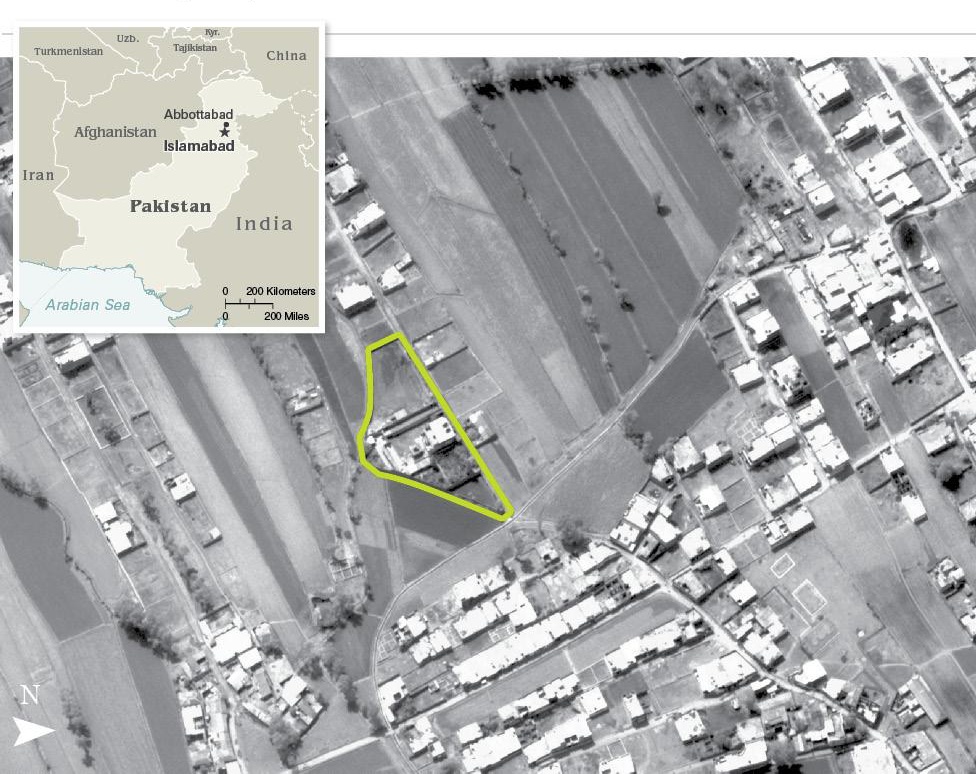
Aerial view of Osama bin
Laden's compound in the Pakistani city of Abbottabad made by the CIA
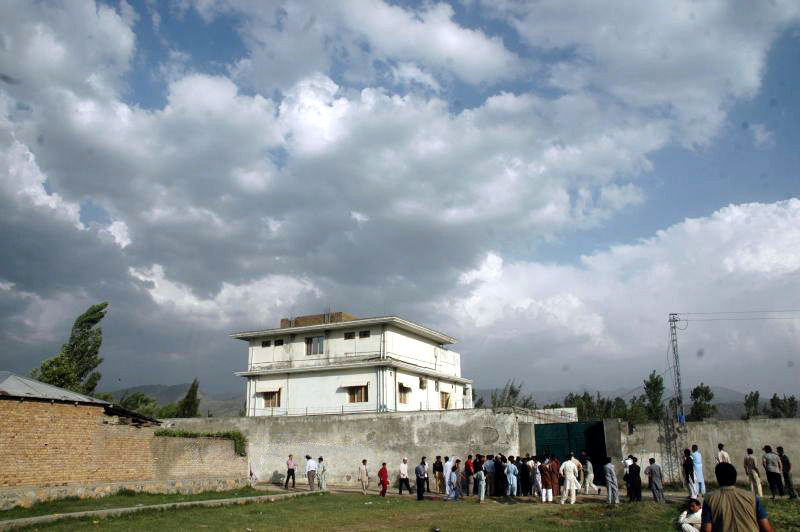 Osama bin Laden's compound
at Abbottabad
Osama bin Laden's compound
at Abbottabad

Obama and the national security team
await updates
on bin Laden
 President Obama announces the death
of Osama bin Laden
– 11:00 p.m. that same night
President Obama announces the death
of Osama bin Laden
– 11:00 p.m. that same night
Meanwhile
there were other events shaking deeply the Arab world. Revolts of Arab
youth were shaking the foundations of several of the major Arab nations.
Tunisia
It all started in Tunisia in mid-December of 2010, when a street vendor
set himself ablaze … in protest against the rising inflation,
unemployment and general disillusionment of the Tunisians with respect
to the Ben Ali government. The action quickly sparked more street
protests – spread quickly through the means of the internet – by the
Tunisian youth.
Sensing that he had lost all political standing, Ben Ali fled to Saudi
Arabia in February (2011). And his government stepped down … to make
way for an interim government.
But all the Tunisian storm and fury soon spread to other Arab countries.
|
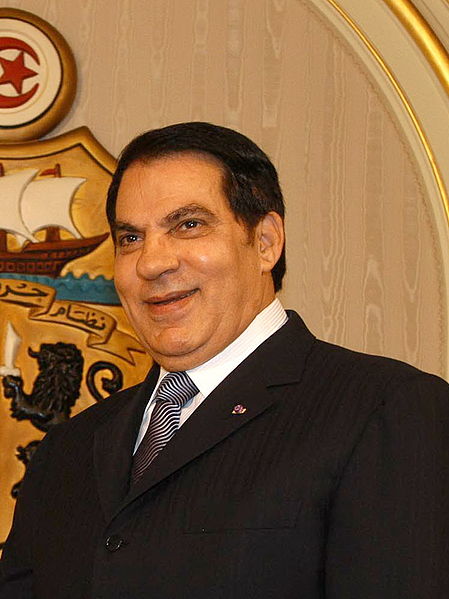 Zine El Abidine Ben Ali –
2008
Zine El Abidine Ben Ali –
2008
President of Tunisia
(1987-2011)
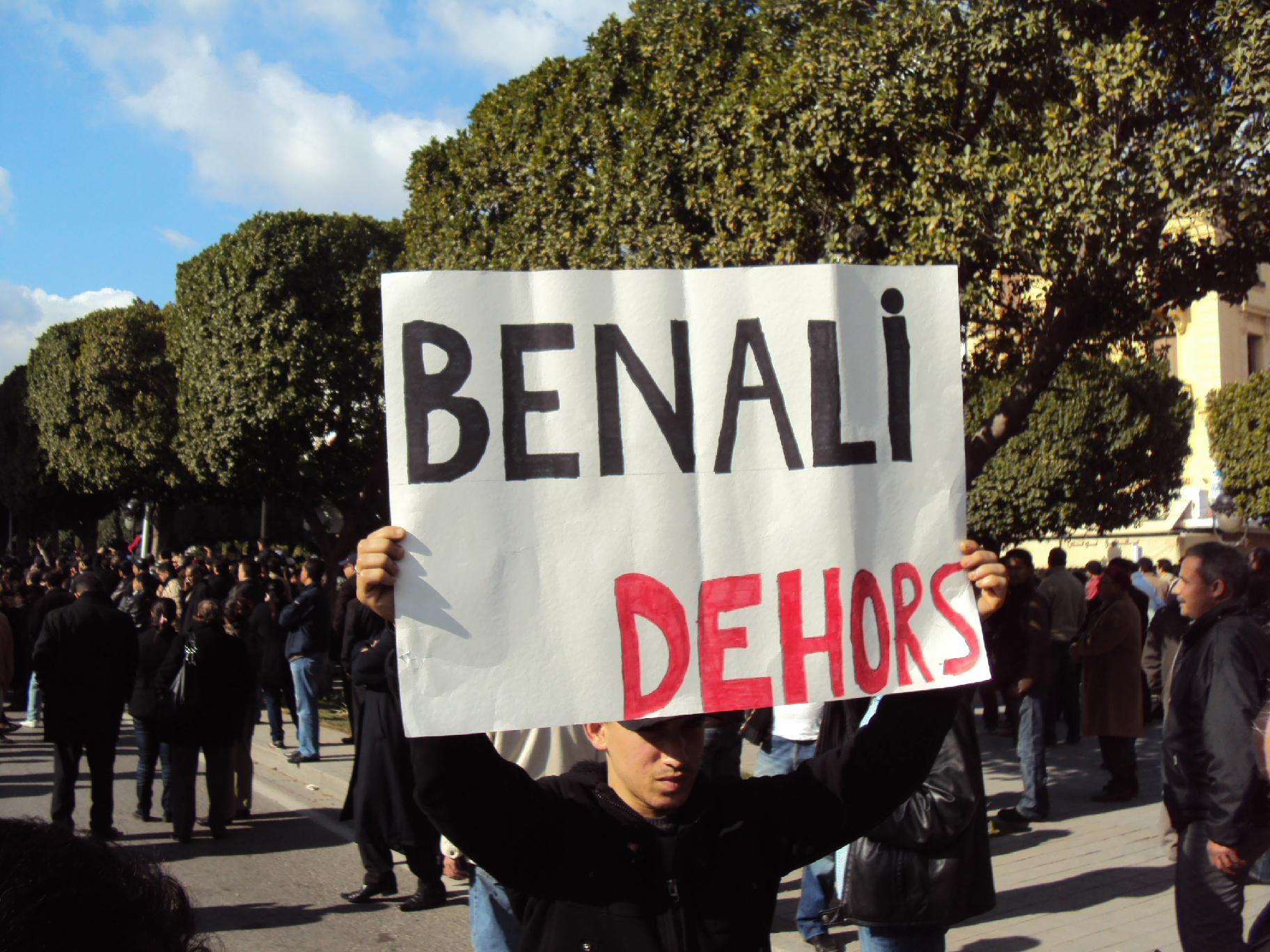
"Out with Ben Ali" – 14 January
2011
Protesting unemployment
high food prices, corruption
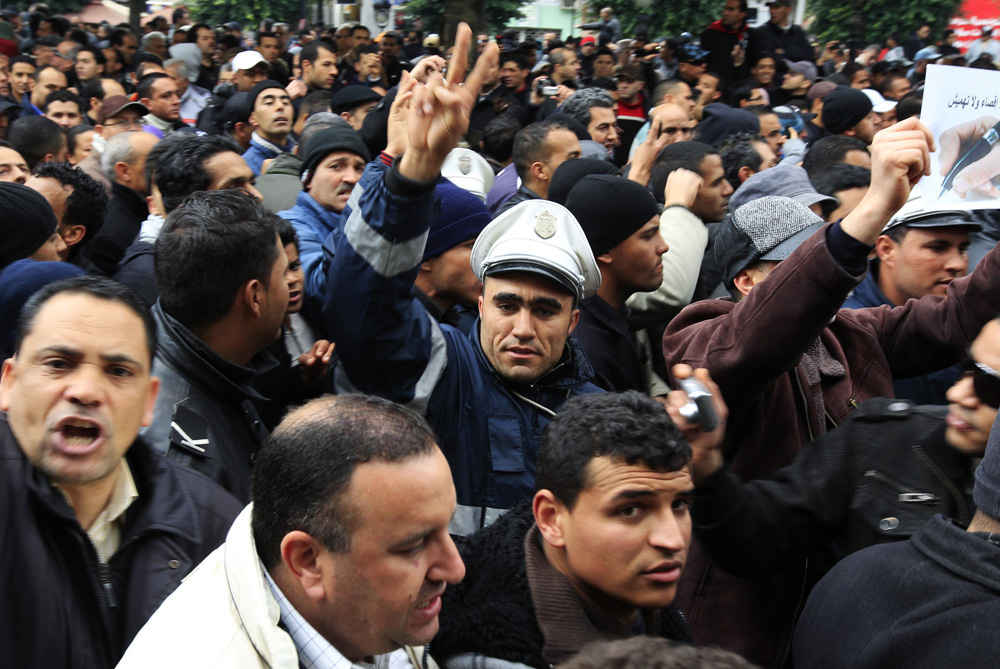
Tunisian
Protesters
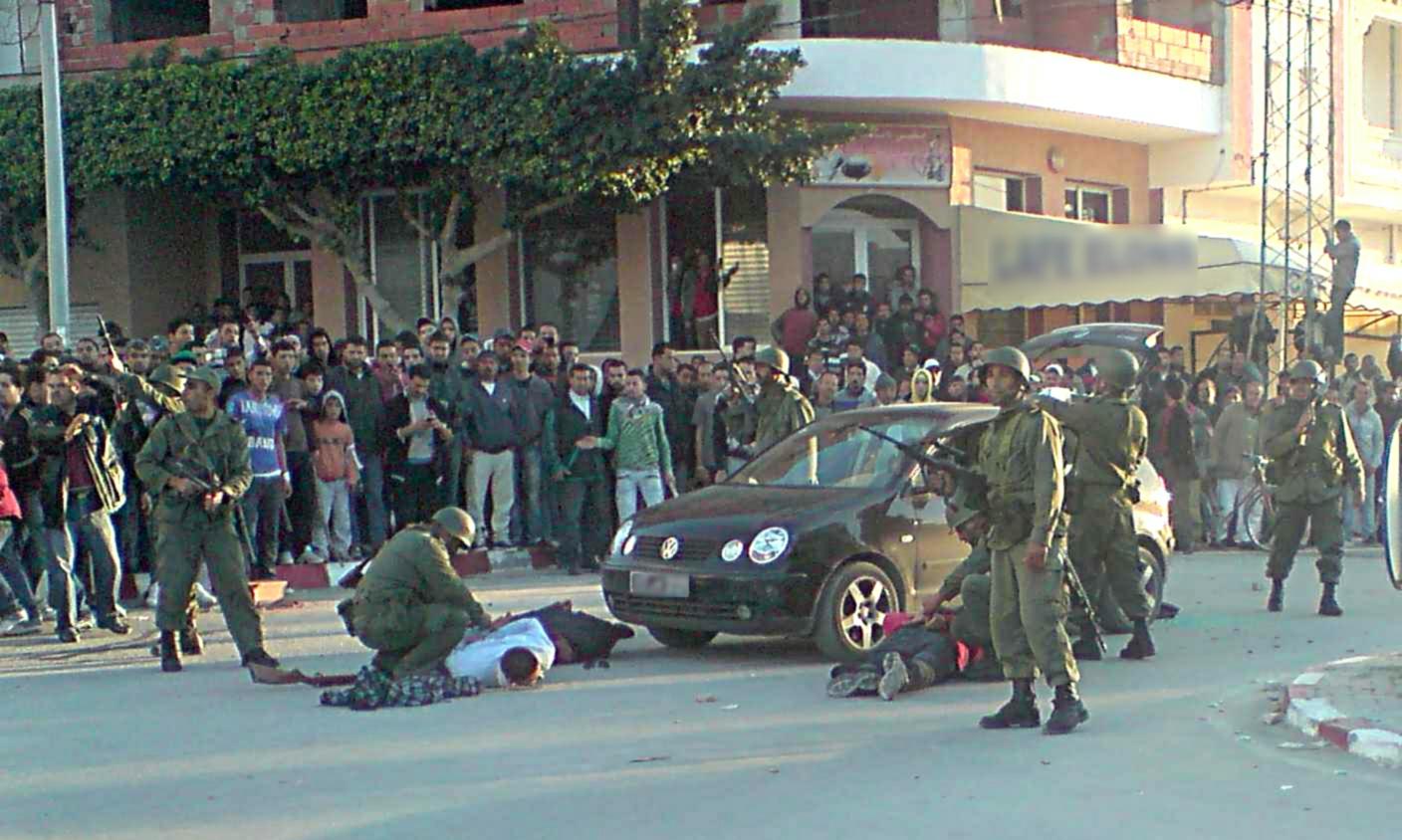
The Tunisian National Army
restored order in absence of police services. The picture shows a civilian
who was stopped because of a weapon in his car. 15 January 2011
|
Egypt
In Egypt, thousands of youth gathered in Cairo's Tahrir Square in late
January to begin their own protests against the Mubarak government …
for a variety of political and economic reasons. Here too, the Egyptian
leadership folded – when Mubarak simply stepped down in mid-February …
placing a military junta in charge of the country. But this hardly
satisfied the Tahrir Square assembly, which now was camped out there in
rather permanent demonstration on behalf of the demand for food, jobs –
and of course more personal freedom, as well as punishment for Egypt's
former leaders.
Into the early summer the protests continued … with conflicts between
the protesters and Egyptian police growing more violent. Meanwhile the
demands for the death penalty for Mubarak became a central theme … at a
time that Mubarak found himself actually quite ill. In August Mubarak
was brought to trial … and finally in June of the following year (2012)
he and his sons were found guilty of corruption … though they were soon
acquitted on technical matters.
At the same time, presidential elections were held (two rounds, one in
May and one in June of 2012), with the recently appointed Prime
Minister Ahmed Shafik – representing the modernist or secular viewpoint
(and the Egyptian military) – gaining 48.3 percent of the vote and
Mohammed Morsi - representing a strongly traditionalist Muslim
viewpoint (and the Muslim Brotherhood) – gaining 51.7 percent of the
vote. Thus Morsi became Egypt's new president at the end of June.
Realizing what was then likely to follow, Shafik flew to the United
Arab Emirates – in order to avoid arrest. Indeed, in August, Morsi put
out an order for Shafik's detention for questioning on "corruption"
charges should he attempt to return to Egypt. So things went for "now
democratic" Egypt.
But with Morsi's Muslim Brotherhood now trying to "change" Egypt, Morsi
was finding himself facing a lot of pushback … especially after he took
on whatever powers necessary to "protect the revolution." By June of
2013 tens of millions of Egyptians had taken to the streets across
Egypt to protest the policies of Morsi … and the chaos that was tearing
Egypt apart.
This was the cue for the Egyptian military to step in (also June of
2013), place Egypt's Defense Minister General Abdel Fattah el-Sisi in
charge, and arrest Morsi. Now it was the turn of the Muslim Brotherhood
to stage protests around the country. But so did the pro-Sisi
supporters. Little by little, the military gained the upper hand … and
the Muslim Brotherhood was forced to back down at the same rate.
Something resembling peace and order finally descended on Egypt.
Most interesting, American President Obama was initially very upset
about this overthrow of Egyptian "democracy" … although he then
softened up a bit on the matter when he came to understand Morsi's
massive unpopularity in an Egypt that did not want to be turned back
into a rigorously Muslim society. Nonetheless, he still registered his
ire about the military taking over in Egypt by ending all further sales
of military equipment (such as the F-16 fighter jet) to Egypt. What he
exactly hoped to achieve by such "punishment" was not clear. But it all
certainly worked to the benefit of France … and Putin's Russia – glad
to step in to service the Egyptian military's strategic needs.
In 2014, a new round of Egyptian elections was held – boycotted by the
Muslim Brotherhood – resulting in Sisi's election to the presidency by
a 96 percent vote – for a four-year term (until 2018; but reelected
that same year) … a period in which Egypt made fair economic and social
progress … unlike other parts of the Middle East.
|
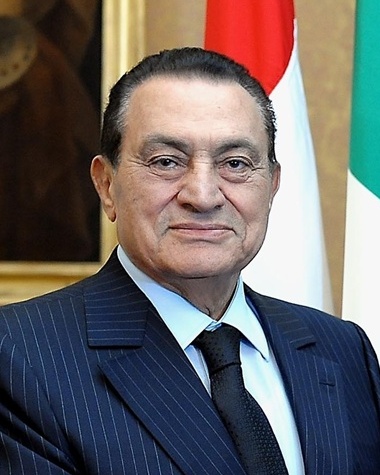 Egyptian President Hosni
Mubarak in 2009
Egyptian President Hosni
Mubarak in 2009

A picture of an Egyptian
protester holding the Egyptian flag – February 1, 2011
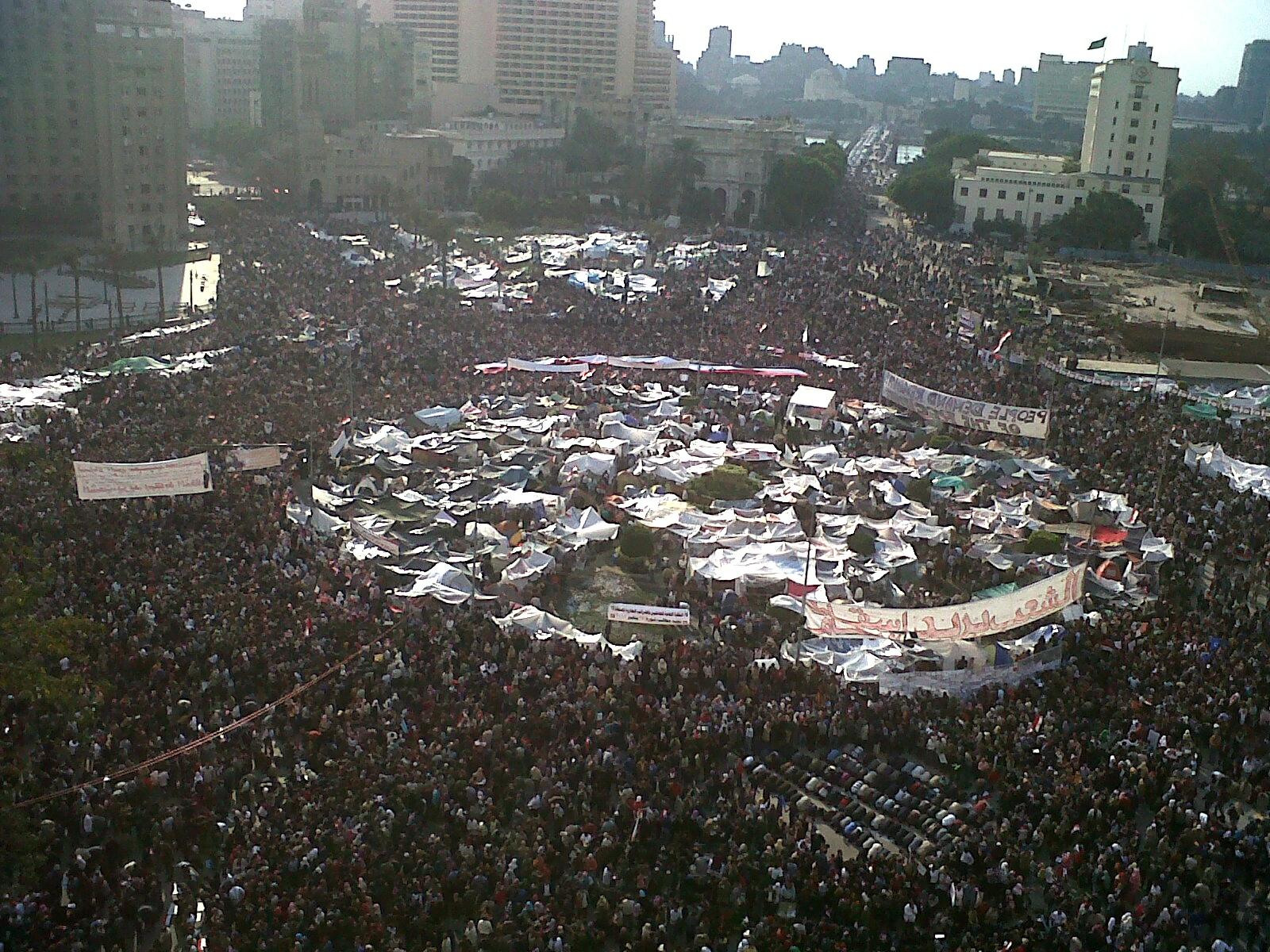
Demonstrators in Cairo's
Tahrir Square on 8 February 2011
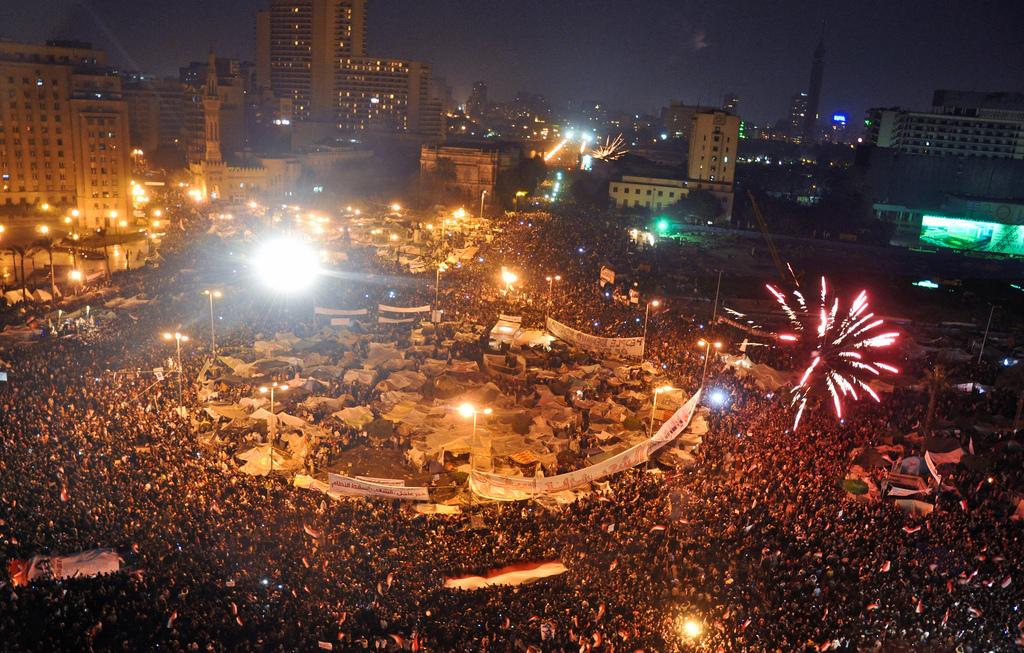
Celebrations in Tahrir Square
after Omar Soliman's statement that concerns Mubarak's
resignation. February 11, 2011 – 10:15 PM

The "Second Revolution of
Anger" – people protesting in Tahrir Square on 27 May 2011 demanding food, jobs, and
punishment of the former government officials
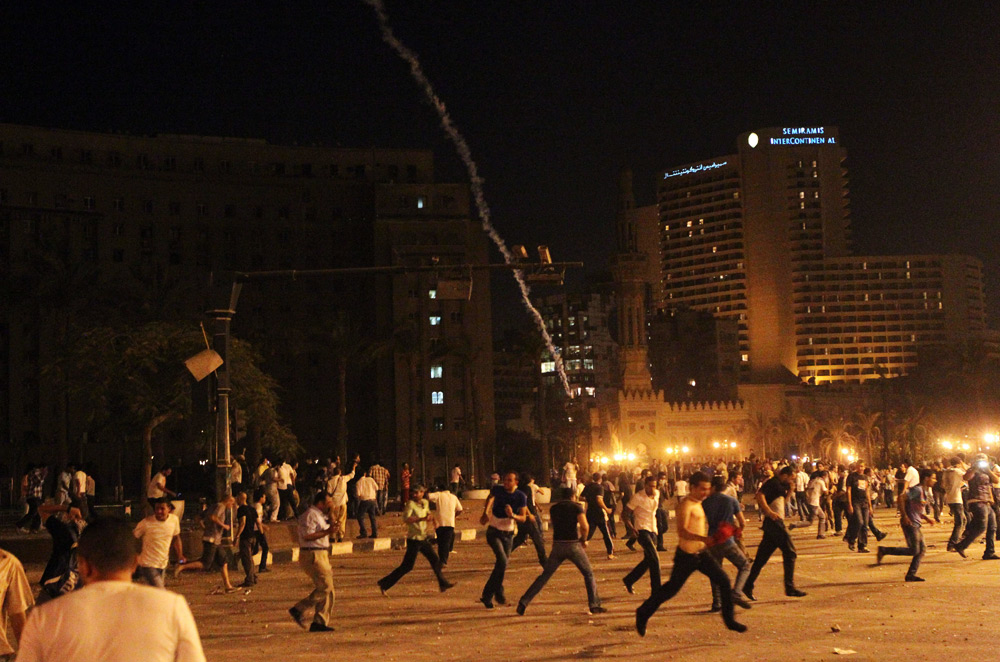
Another round of protests
at Tahrir Square beginning the evening of 28 June, 2011
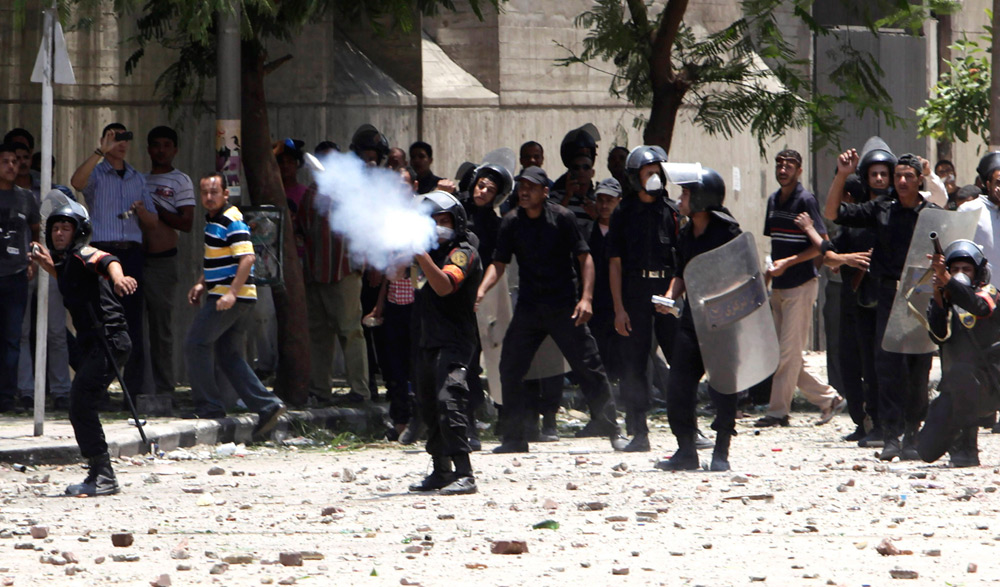
The protests continue the
next day – June 29 2011
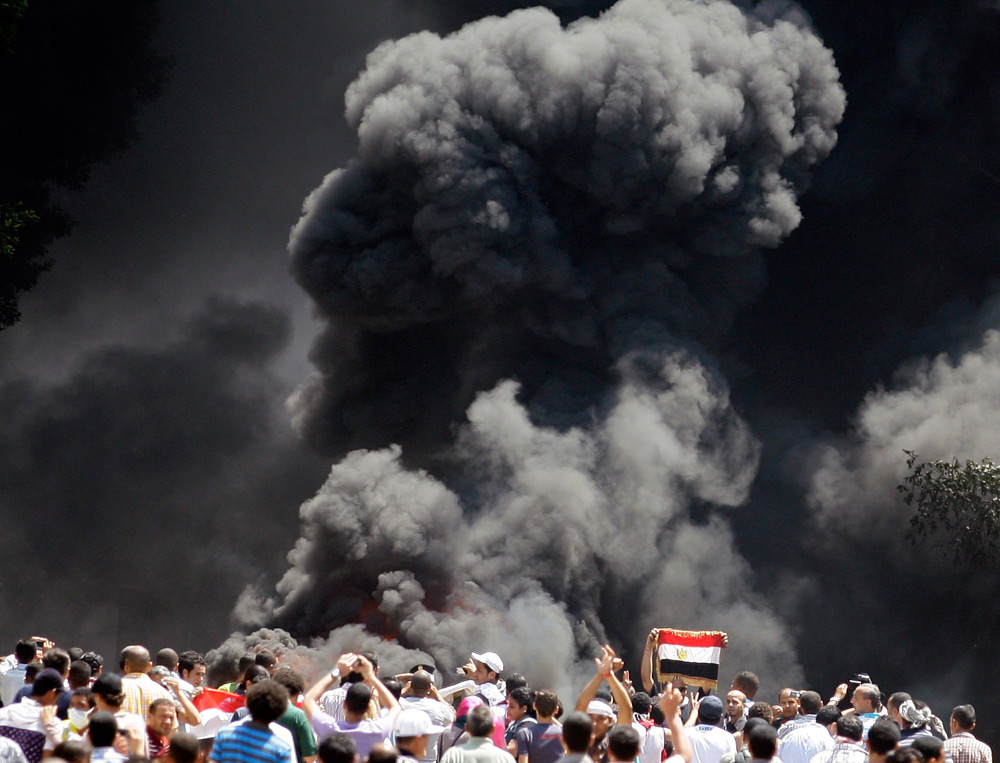
Protesters are seen in front
of smoke burning from a destroyed police booth – June 29 2011
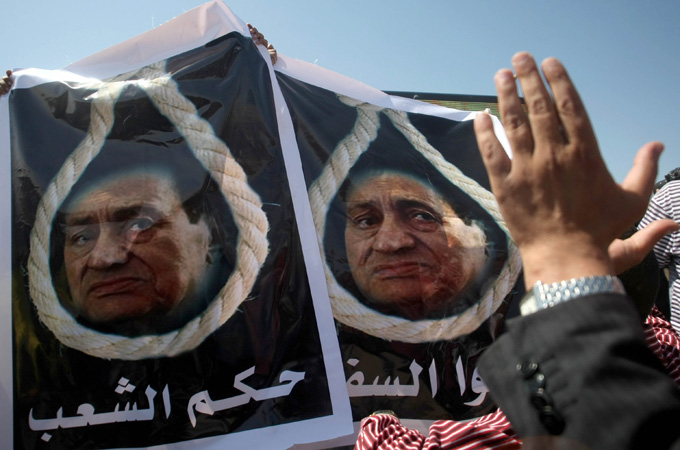
Some demonstrators that
gathered
outside the court demanded
the death penalty for the ousted president
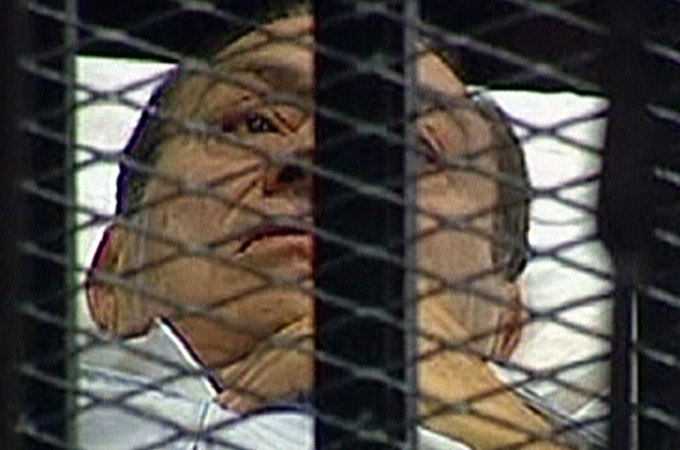 A caged Mubarak on trial
in Egypt – August 6, 2011
A caged Mubarak on trial
in Egypt – August 6, 2011
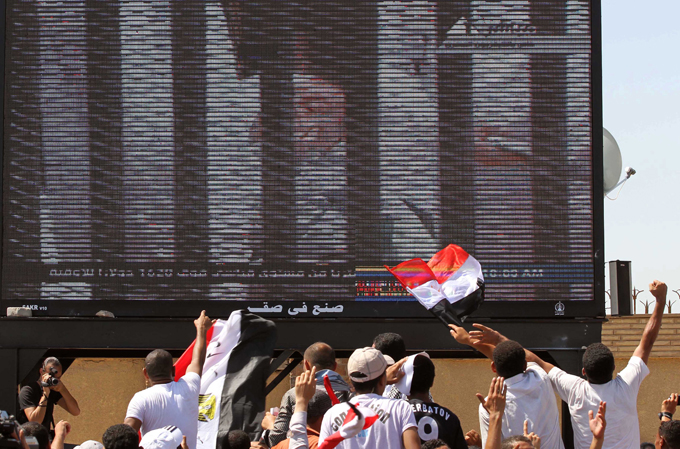
Human rights standards may
not be met in this trial,
but the more essential purpose
is to prove there's no going back.
Finally, Obama gets the good news that Egypt has scheduled elections for Egyptian President (May-June 2012). Hooray! Egypt can now join the ranks of the world’s democracies.

The New Egyptian President,
Mohamed Morsi. He was elected with 51.73% of the vote – on the basis of Muslim Brotherhood support, and took office at the end of
June 2012.
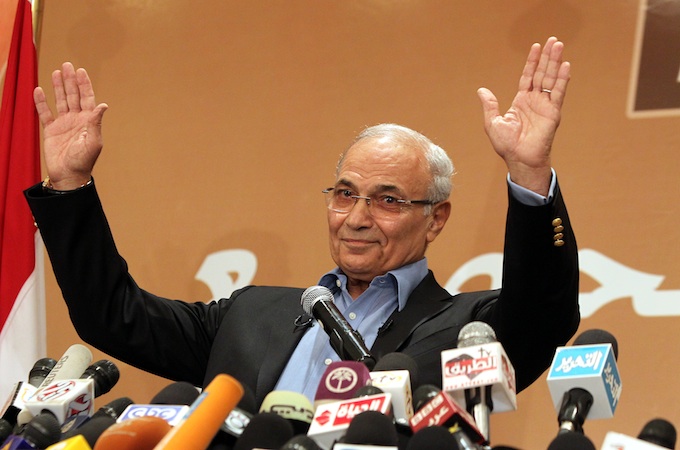
His opponent Ahmed
Shafik. Shafiq flees the country … and chaos mounts in Egypt as Islamists battle Secularists and Christian Copts.
By
June of 2013 tens of millions of Egyptians had taken to the streets to
protest
the policies of Morsi ... and the chaos that was tearing Egypt
apart.
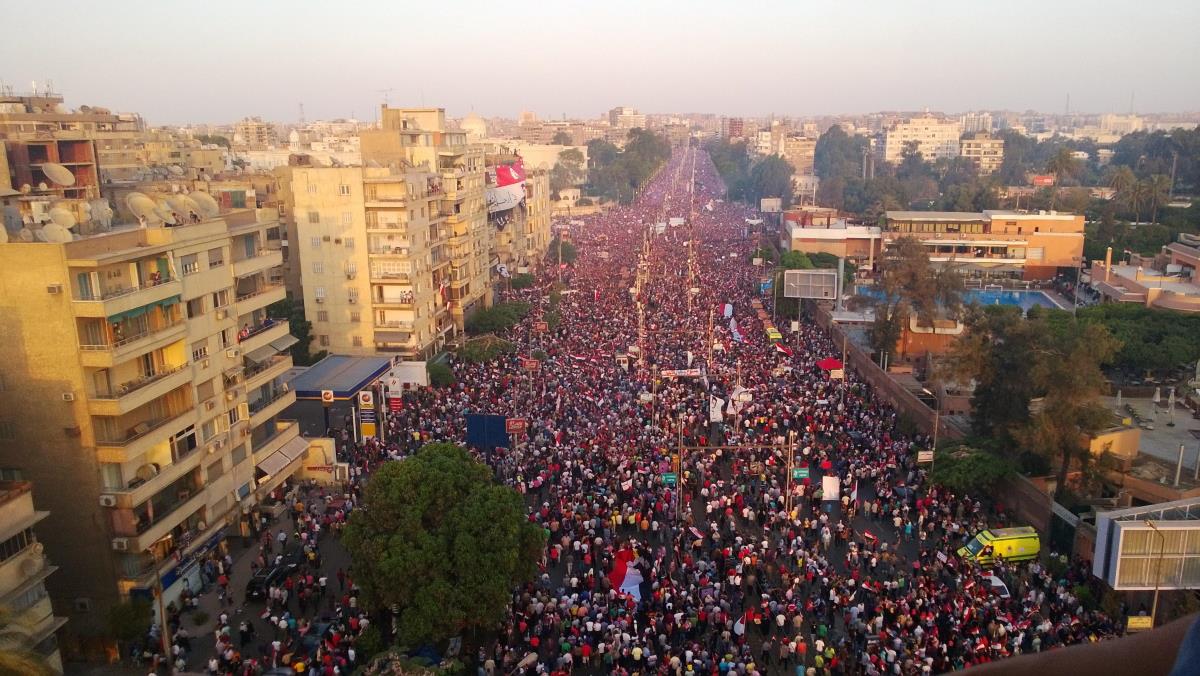
The
military put out a warning that if the contending political parties did
not come to some kind of agreement within 48 hours, the military would
be forced to intervene to restore order in Egypt.
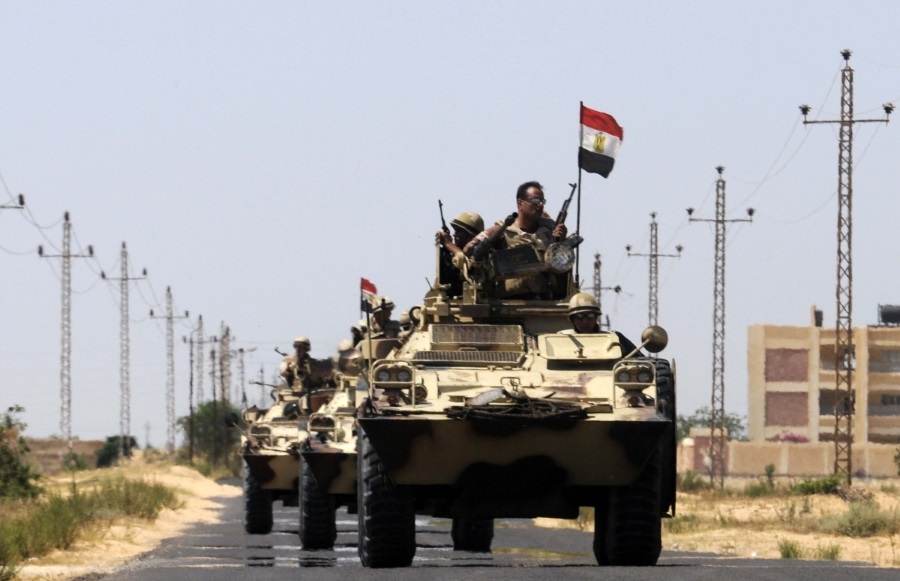
Ultimately the military, under Egypt’s Defense Minister General Abdel Fattah el-Sisi took over … and arrested Morsi.
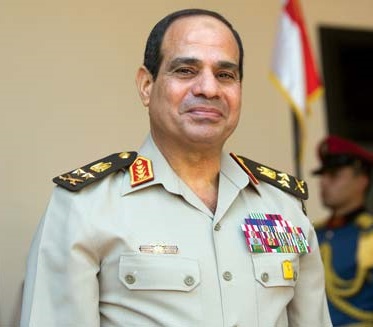
The
Muslim Brotherhood staged protests around the country … but the
pro-Sisi supporters did the same. Little by little the military
gained the upper hand … and the Muslim Brotherhood was forced to back
down at the same rate. Something resembling peace and order
finally descended on Egypt.
The
following year (2014) Egypt held another round of Presidential
elections … which the Muslim Brotherhood boycotted … helping deliver a
96% win to Sisi for a four-year presidential term (until new elections scheduled for 2018)
|
ACTION IN LIBYA AGAINST GADDAFI |
Muammar
Gaddafi's Libya was also hit very hard by the spirit of revolt sweeping
the Middle East. Gaddafi had led the military overthrow of the Idris
monarchy in 1969 … and had been taking Libya on a very strange, and
quite wandering journey ever since. Thanks to the vast oil wealth that
flowed to Libya, the Libyans had been quite tolerant of Gaddafi's
erratic rule. But as oil prices rose and fell, so did Gaddafi's ability
to keep his people happy and in line with him. Besides his own peculiar
behavior (he would swing back and forth in trying to become the Arab
world's leader, then Africa's leader, and even something of a Third
World philosopher), the cultural division between the two North African
societies or cultures that had been thrown together by the Italians in
creating their unified Libyan colony in 1934 had failed to make a truly
"Libyan" society. Tripolitania in the West and Cyrenaica in the East
were quite different in their reaction to Gaddafi's secularist
tendencies … Tripolitania tending to be rather supportive and Cyrenaica
tending to be quite hostile to such modernizing tendencies. Thus
Gaddafi could be quite heavy-handed in dealing with the dedicated
opposition of Muslim Fundamentalists … numerous in the Cyrenaica East.
Obama disliked Gaddafi because of his heavy-handed ways … not realizing
that should the Muslim Fundamentalist take control (there really was no
group standing at the center between the strongly modernists and the
strongly traditionalists) they would turn out to be just as
heavy-handed. Obama's dream of somehow helping to set up the conditions
for democracy to come to Libya would most certainly turn out
disastrously.
And Obama (and the Liberal West) would have just such an opportunity to
bring Libya to bloody chaos when the Arab Spring hit Libya … due
greatly to the drop in global oil prices – and therefore Gaddafi's
ability to finance his governmental system.
Here the spreading world of Arab protest had little to do with anyone
demanding "democracy" … but instead a deep clash between Libyan
modernism – heavily dependent on military support – and widely popular
in the West … and Libyan traditionalism – heavily dependent on Islamic
fundamentalist or "jihadist" support – and widely popular in the East.
In any case, when violent protests broke out in Libya, in March (2011)
the U.N. Security Council decided to get in on the act by passing a
resolution 10-0 – with abstentions from Russia, China, India, Germany,
and Brazil … not a good start politically – calling for U.N.
intervention in the growing civil war in Libya in order to "protect"
the civilian population from Gaddafi's oppressive policies. And to
provide this protection, France and Britain would take actual military
action against Gaddafi (thus supporting the Muslim traditionalists in
this conflict) … with America providing supply and intelligence to
France and Britain (and also knocking out Libyan air defense
installations) … though no ground troops. However, he did not get
Congress's permission to engage in any of this, violating the 1973 War
Powers Act, which upset many members of Congress when he claimed he did
not need such Congressional authorization because American troops were
not directly involved (except of course in the bombings and missiles
sent against Gaddafi's forces!). NATO would then be called on to take
over the bombing campaign in Libya … helping the anti-Gaddafi rebels
regain territory that they had lost in the first stages of the conflict.
This covering of the Western effort with moral justification, was
furthered in June with the International Criminal Court issuing an
arrest warrant against Gaddafi for committing crimes against his people.
In September a National Transition Council was set up in anticipation
of the ultimate success of the effort to depose Gaddafi … and was
quickly recognized by the U.N. as Libya's legal representative.
Thus it was that the anti-Gaddafi forces – aided heavily by French,
British and American involvement – drove the Gaddafi forces into
retreat … until they were able to seize and murder Gaddafi on the spot
that October. Libya was now free! Fighting would continue … though
without its leader, it was destined to go nowhere. And some of the
anti-Gaddafi militias refused to disarm … keeping the situation very
strained.
|
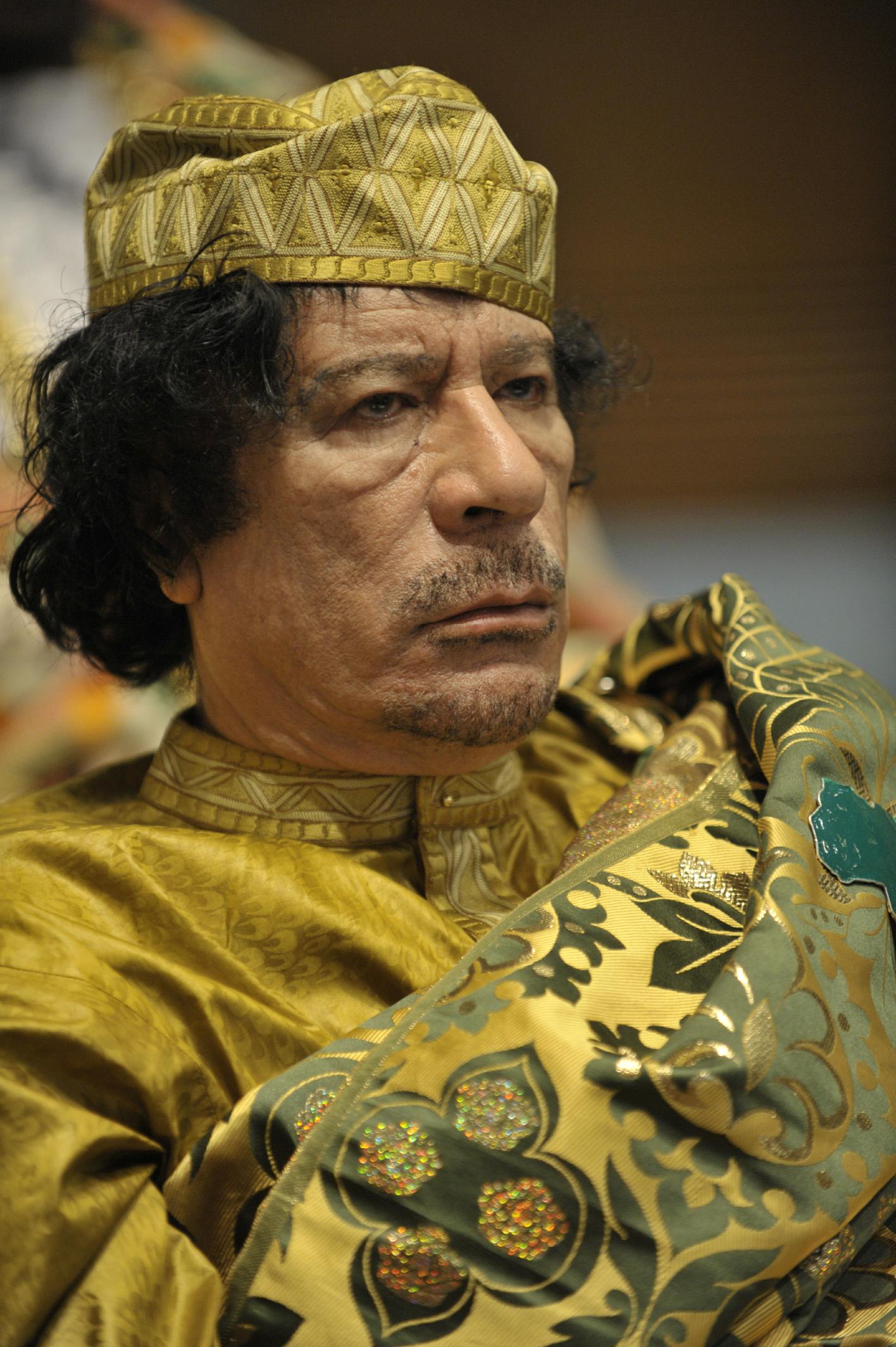
Muammar al-Gaddafi at the
12th AU summit, February 2, 2009, in Addis Ababa. President of Libya (1969
- 2011)
 (Green) Cities controlled
by pro-Gaddafi forces (as of July 1, 2011); Brown) Cities controlled
by anti-Gaddafi forces (supported by coalition forces)
(Green) Cities controlled
by pro-Gaddafi forces (as of July 1, 2011); Brown) Cities controlled
by anti-Gaddafi forces (supported by coalition forces)
Wikipedia – "2011
Libyan civil war"

The International Criminal
Court has accused Gaddafi of crimes against humanity and of ordering attacks
on civilians
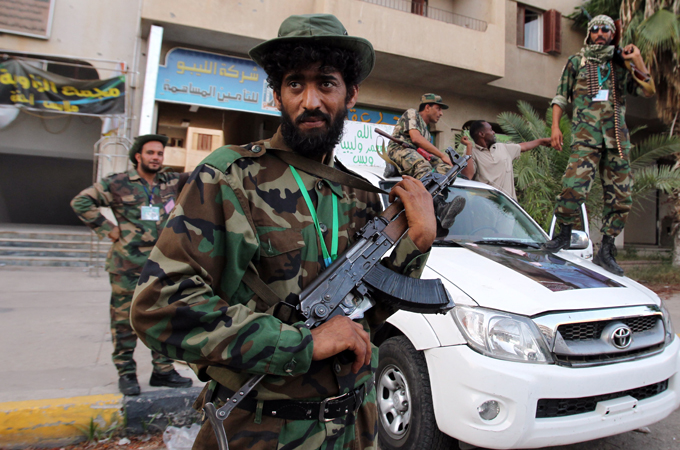
Forces loyal to Gaddafi ... located mostly in the western portions of the country
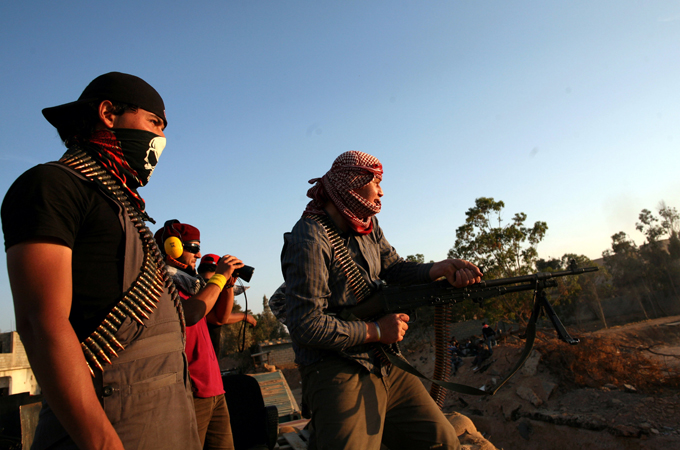
Forces opposing Gaddafi at Brega (the eastern portion of the country)
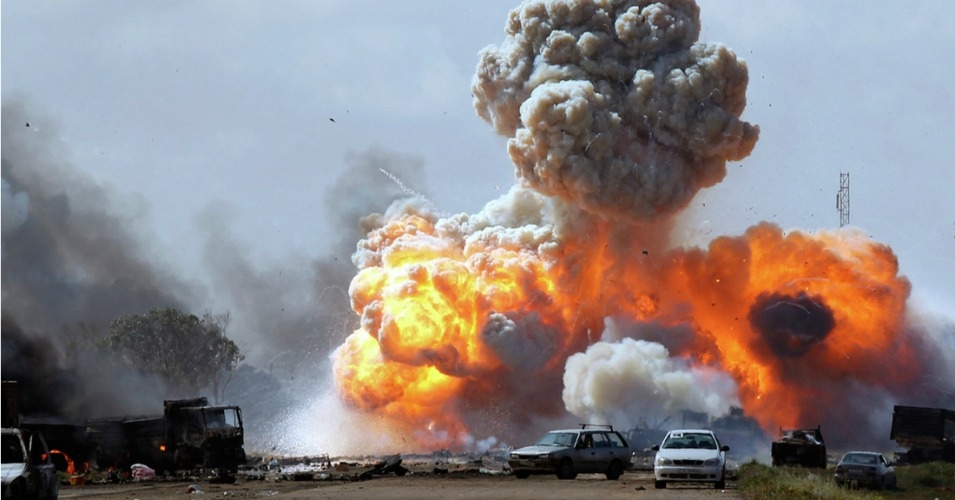
A NATO airstrike directed at the pro-Gaddafi forces

At news that Gaddafi was
losing his grip on power, celebrations erupted in cities across Libya

Libyan citizens hold a Kingdom
of Libya flag as they attend the Arab League meeting
in its headquarters
in Cairo
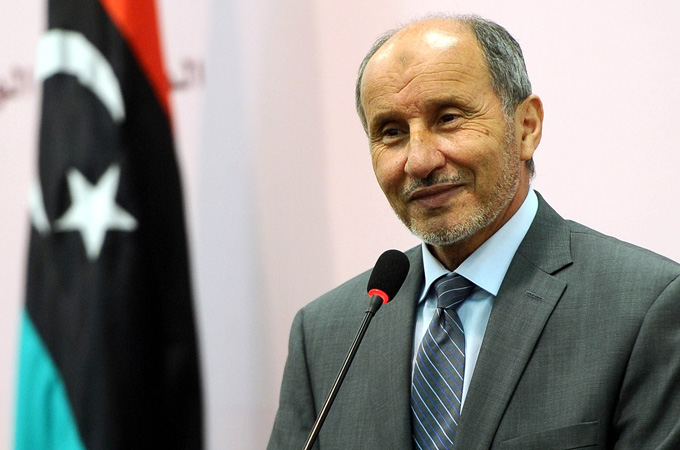
Libya's National Transitional
Council is led by Mustafa Abdel-Jalil,
Gaddafi's former justice minister (Mahmoud Jibril, Chairman
of the NTC's Executive Board, is another key NTC leader)
 An image captured by cellphone showing a battered Qaddafi just before his on-the-spot execution
An image captured by cellphone showing a battered Qaddafi just before his on-the-spot execution
October 20, 2011
|
The Muslim assault on American officials at Benghazi
(September 2012)
America would soon receive just reward for its contribution to the Libyan campaign, when – in September of the following year –
Muslim militia (Ansar al-Sharia) killed the American Ambassador
Christopher Stevens and two CIA contractors and wounded ten
others. Interestingly, these Muslim jihadists were part of the
group that America and the West had worked so hard to bring to victory
in this civil war.
At first, American Secretary of State Hillary Clinton claimed that this
tragedy resulted as a spontaneous act inspired by an anti-Muslim movie
coming out about that time … covering up the fact that this had
obviously been a long-building operation – one which Ambassador Stevens
was well aware of and had made repeated requests for enhanced security
– which had simply been ignored. When the truth finally came out
(a Congressional hearing in 2015), it would prove to be a major
embarrassment to the Obama Administration. But it would be
Hillary that would have to take the fall for the blunder. She
would resign (in part also to prepare for her own run for the
presidency in 2016) and Obama would replace her with former (but
unsuccessful) 2004 Democratic Party presidential candidate John Kerry.
|
A year later (September 11, 2012) ... the Benghazi killing of American officials
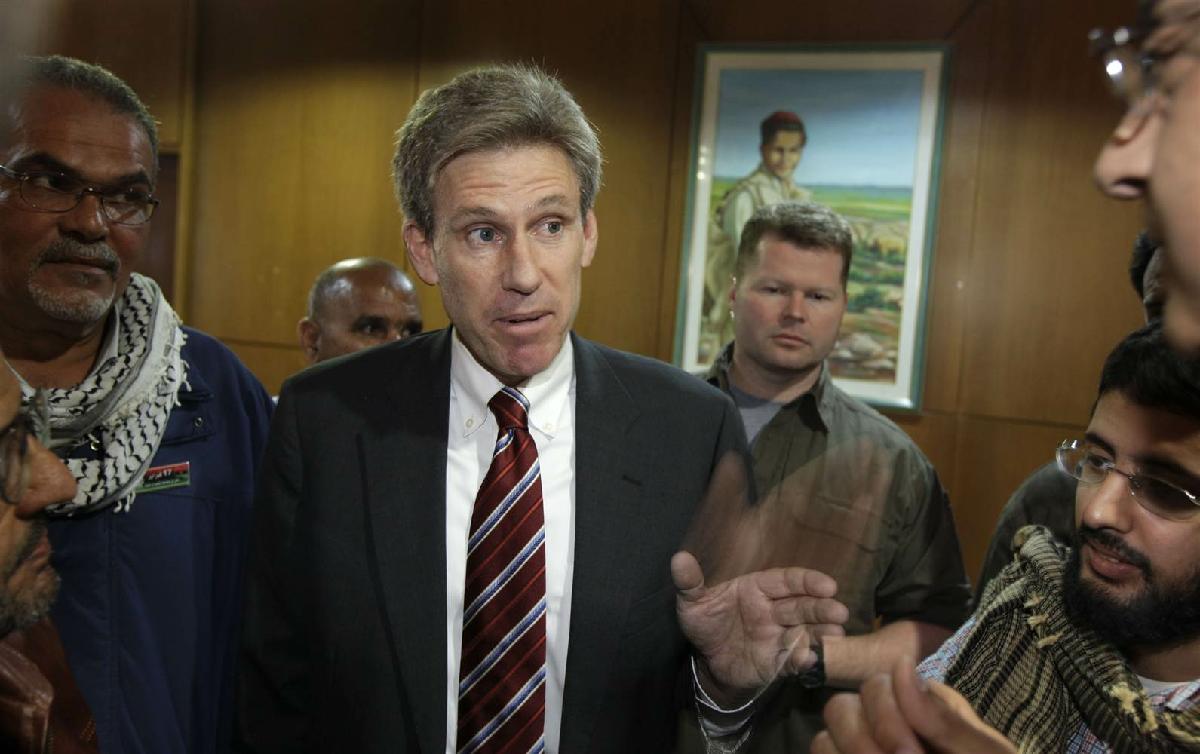
U.S.Ambassador Chris Stevens in Benghazi -
2011
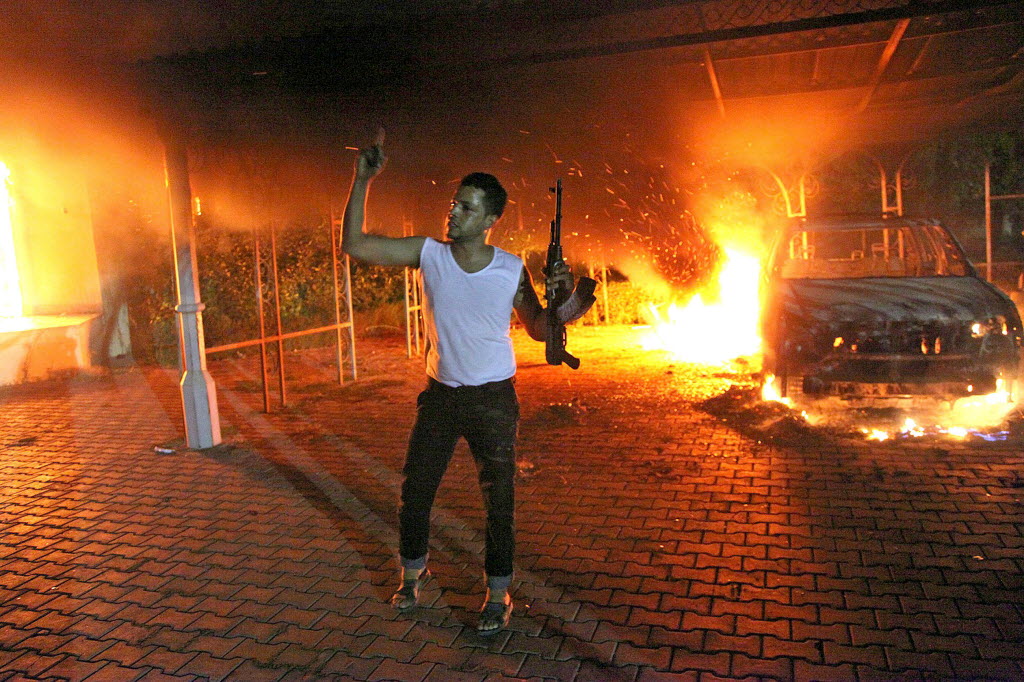
One of those who assaulted the unprotected
American compound in Benghazi
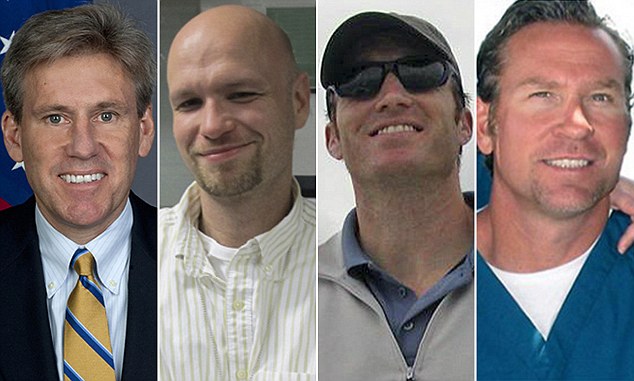
U.S.Ambassador Chris
Stevens, Sean Smith, Glen Doherty and Tyrone Woods
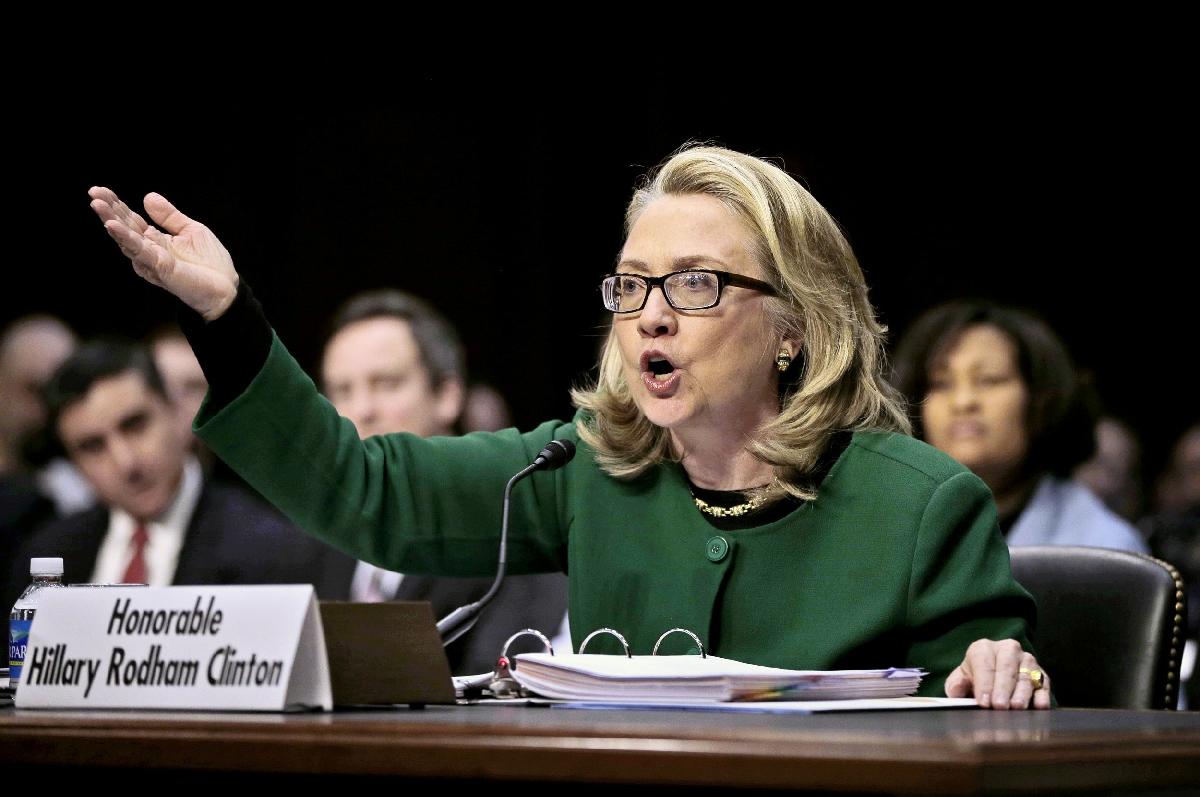
Secretary of State Hillary Clinton
at Congressional
hearings held in 2015
as to what went wrong in Benghazi
ACTION IN SYRIA AGAINST ASSAD |
The
"Arab Spring" would come to Syria as well … although it would not hit
until mid-March, when inspired young protesters filled the streets of
Damascus, demanding various political "reforms" … in line with the
general mood that was challenging Tunisian and Egyptian leadership at
that same time. The critical problem was that "reforms" meant very
different things to very different groups joining the protest, some
wanting more "modernization" along economic and secular cultural lines.
Others wanted a move to more traditionalist Muslim cultural lines …
although the issue of Sunni versus Shi'ite lines divided these Muslim
traditionalists bitterly. And another major problem was that Syrian
society itself was a messy mixture of various ethnic groups, each with
its own ethnic goals: Arab Sunni, Shiite, Alawi, Druze, Sufi, and
Salafi Muslims … plus Kurdish (non-Arab) Muslims, Arab Orthodox and
Catholic Christians, and numerous tribal groups. Also the economy had
been hit hard by a recent drought, Israel had been attacking savagely
various Palestinian refugee groups that had fled to Syria, and
thousands of Iraqis had escaped to Syria to avoid the
American-initiated civil war tearing Iraq apart. Socially, Syria was a
mess.
The only thing holding the country together (typical of fiercely
multi-ethnic societies) was the strong hand of the young Syrian
President Bashar al-Assad – a Alawi Muslim … not one of the mainstream
Muslim groups – and actually a strong Secularist of the "modernist"
camp. As was typical of the way the Arab Spring was turning
increasingly violent the longer the "reform" action continued, it soon
moved from reform to civil war … as "reformers" came to demand that
Assad step down – only to be countered in the streets by huge numbers
of Assad supporters insistent that the protesters back down.
Unsurprisingly, as the chaos worsened over the summer, the hand of
Assad grew tougher … until it had the West once again demanding that
Assad go lightly in his effort to put down the rebellion (at that point
he was even using chemical weapons). What might come to be the
political outcome in Syria should he have given in to the rising
demands of the West clearly was given no thought … or else the
Westerners were incredibly misinformed about how political dynamics
worked outside of their own "polite" societies.
In August, Obama issued a threat to Assad that America would react
strongly if he crossed a "red line" by continuing to use unacceptably
repressive weapons – particularly the chemical weapons. But Assad chose
to ignore the threat … which then forced Obama to demonstrate what he
meant by "react strongly." But it was quickly apparent that Obama had
no such intent or capability to "react strongly." It was most
embarrassing.
At this point Russian President Putin came forward by offering to
mediate in the matter. But it also became quickly apparent that his
real intentions were simply to draw Assad away from his former close
relationship with the West … and into his own Russian political orbit.
And that is indeed what happened – as a result of the West's (most
notably Obama's) diplomatic failure.
The worsening of the situation
In any case Assad managed to stay in relative command of a collapsing
Syrian society … despite the efforts at this point of Obama and the
West to bring Assad down. In fact, America – in concert with Saudi
Arabia – began secretly to ship military items (even tanks) to a group
of anti-Assad militants (the "Free Syrian Army") supporting the Syrian
National Coalition … recently formed by various groups outside of Syria
– for various reasons. For Obama, supposedly this group would bring
true "democracy" to Syria. To Saudi Arabia (and others) the purpose was
to undercut the Shi'ites (Assad's Alawi were sort of a Shi'ite faction)
and bring Syria under Sunni Islam.
In any case, it would not be this Coalition that would advance the
Sunni Muslim cause but rather individual Muslim jihadists who gathered
in war-torn Syria to put in place their jihadist dream of a restored
Islamic caliphate (Islam's traditional society headed by a "caliph" or
"successor" to Muhammad). They organized themselves around a political
organization known in the West as the Islamic State of Iraq and Syria
or ISIS1 … taking
control of a huge amount of territory in chaotic Syria and a bitterly
resentful Iraq … Sunnis angry that Americans had turned their formerly
Sunni Ba'athist government over to the Shi'ites. Indeed, in 2014, ISIS
was able to put in place that very caliphate, under Abu Bakr
al-Baghdadi.
And at this point ISIS was drawing fired-up young Sunni Muslims to the
region to join the great jihad … butchering in the most graphic ways
(recorded on camera and displayed to the world via the internet) any
one they deemed opposed to their mission and blowing up Shi'ite
mosques. They even (beginning in June of 2015) blew up the formerly
well-preserved 2000-year-old Roman town of Palmyra – that too displayed
proudly on the internet as another great Sunni achievement … along with
all the captured Syrian soldiers, medical personnel – and men, women
and children of the town – also butchered in typical jihadist style. By
the end of 2015, ISIS held within its territorial control some ten
million people, under the command of some 30,000 jihadists.
The spread of the disaster
Not to be left out of all the excitement, the youthful spirit of reform
even spread to the West itself, with young protesters taking to the
streets of Athens in June of 2011 – to take on violently the police
sent to disperse the growing mob that had gathered there to protest
against various Greek injustices. And in England, in August of that
year, minority youth took up the cause … to plunder, then torch,
various neighborhoods of London – and then other British towns as well
– their purpose being …? And by that October, Italian youth had joined
the fun, torching sections of Rome in protest against "economic
injustice."
Nor were young (and some older) Americans going to pass up this
opportunity to protest against American "economic injustice" … citing
an older attack opposing the 2008-2009 Washington bailout of failing
American corporations - that is, attacking the "too big to fail"
mentality behind the rescue of American capitalism – as they moved to
"Occupy Wall Street." For two months (mid-September to mid-November)
they settled themselves into the heart of the Wall Street neighborhood,
protesting economic inequality, greed, income inequality, and whatever
other sins they detected in the way America worked economically and
socially. Having tolerated this event long enough, finally on the night
of November 15th, New York police forced the protesters to shut down
their encampment and move on. Attempts would later be made to start the
process back up again. But these failed to take hold. Whatever Occupy
Wall Street was designed for seemed ultimately to have virtually no
impact on American society … other than to have given the news
something to keep themselves busy reporting.
The truly tragic part of all this – of the Arab Spring – however, is
what it did to Syria (and parts of Iraq). The decision of the larger
world to get involved in the Syrian social breakdown turned matters
there much worse – far, far worse. As a result of the civil war – and
of the takeover by ISIS – huge parts of Syria became totally devastated
(its cities in deep ruin) and humanly uninhabitable. As a result,
millions of Syrians found it necessary to flee the violence and
economic collapse hitting them. But where were they to go? But by early
2018, some 5½ million Syrians had escaped to very dismal refugee camps
in Lebanon, Jordan, Turkey and Iraq. But others were able to get to
Europe, where Greece, Italy, France, Germany and others took them in.
Indeed, Germany alone took in over a million refugees … including some
from Iraq and Afghanistan.
|
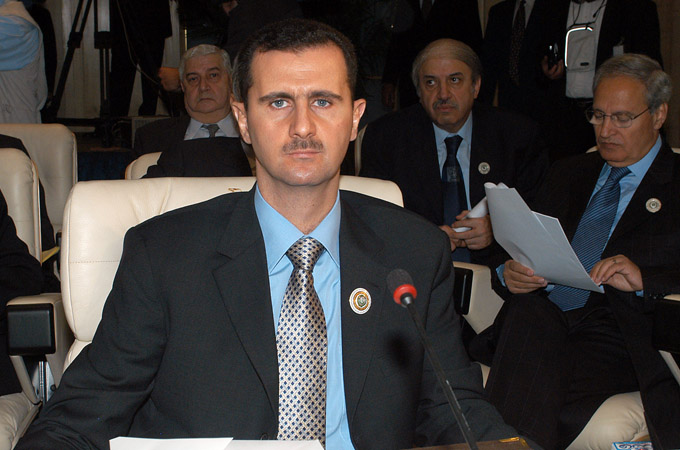
Current president of Syrian,
Bashar al-Assad, second son of Hafez al-Assad
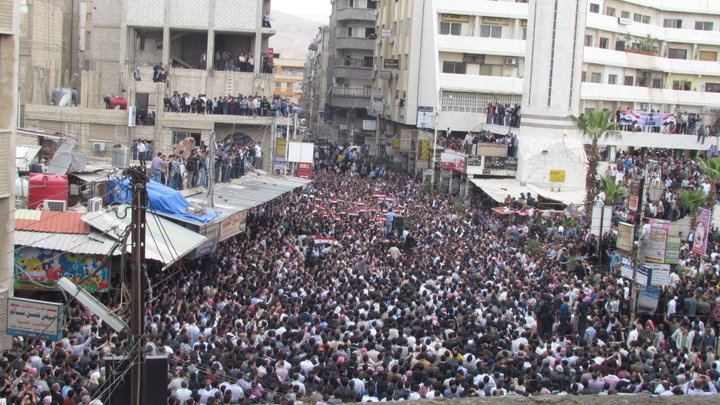
Protest in Duma, a city
near Damascus, Syria (5 April 2011)
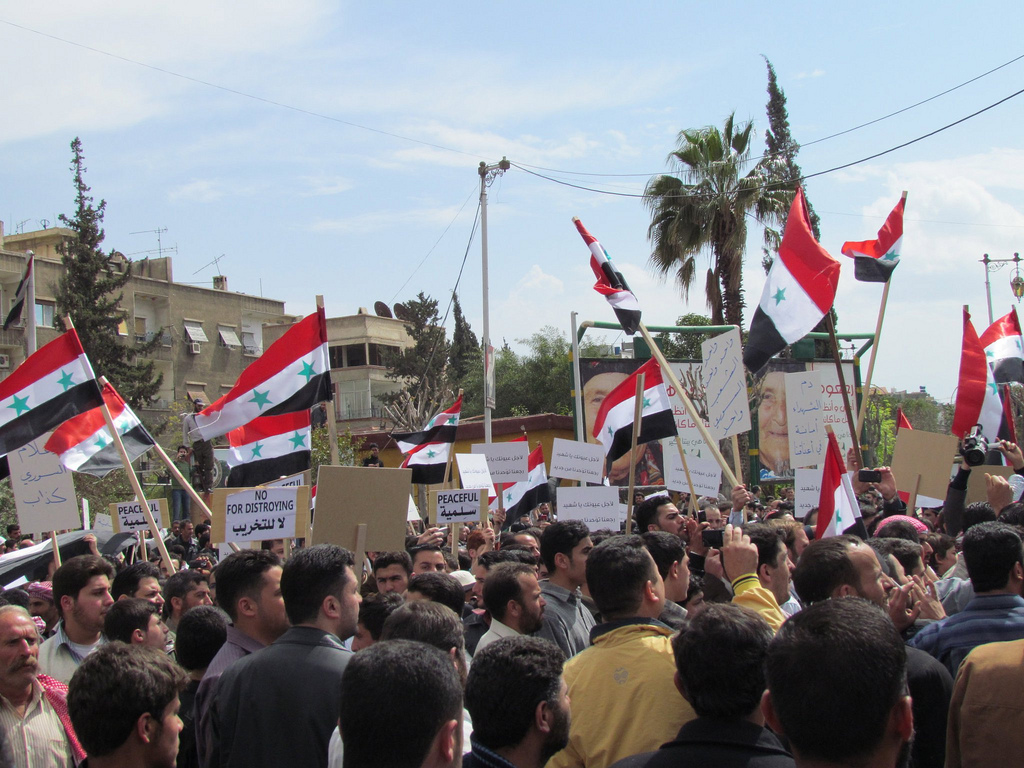
Protesters in Duma (8 April
2011)
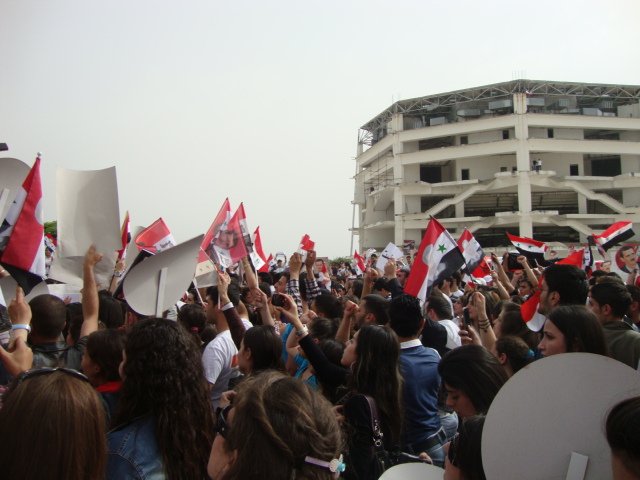
A pro-Assad student
rally at Tishreen University, Latakia, Syria
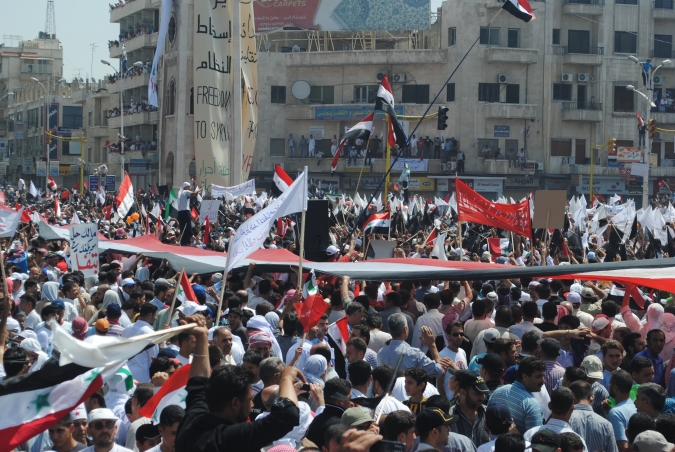
Thousands continue to take
to the streets across Syria, despite the bloody crackdown on
protests. Activists say that thousands
of civilians have been killed by security forces.
|
Obama's "Red Line"
In August, Obama issued a threat to Assad that America would react
strongly if he crossed a "red line" by continuing to use unacceptably
repressive weapons – particularly the chemical weapons. But Assad chose
to ignore the threat … which then forced Obama to demonstrate what he
meant by "react strongly." But it was quickly apparent that Obama had
no such intent or capability to "react strongly." It was most
embarrassing.
At this point Russian President Putin came forward by offering to
mediate in the matter. But it also became quickly apparent that his
real intentions were simply to draw Assad away from his former close
relationship with the West … and into his own Russian political orbit.
And that is indeed what happened – as a result of the West's (most
notably Obama's) diplomatic failure.
|
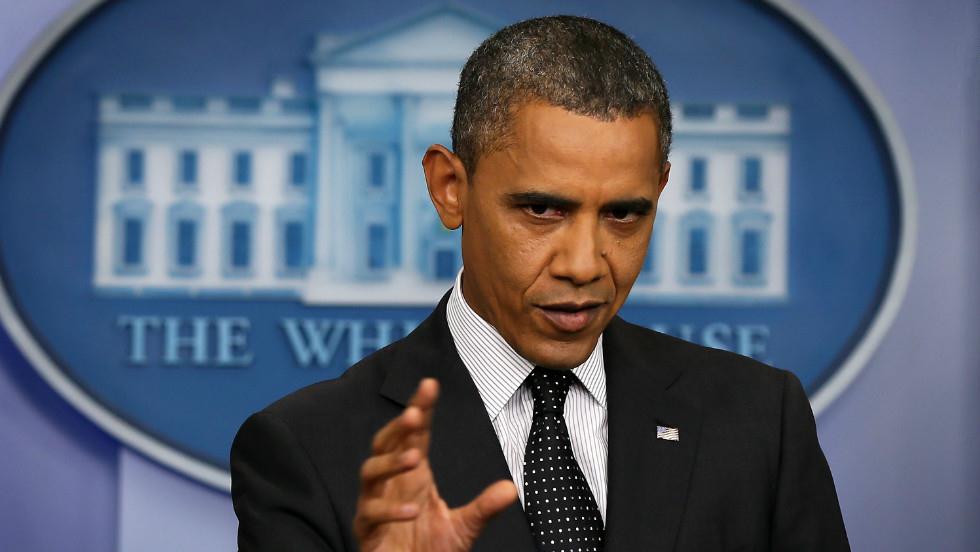
Obama warning Syria not to cross
a "Red Line" in using illegal (chemical/biological) weapons August 20,
2012) 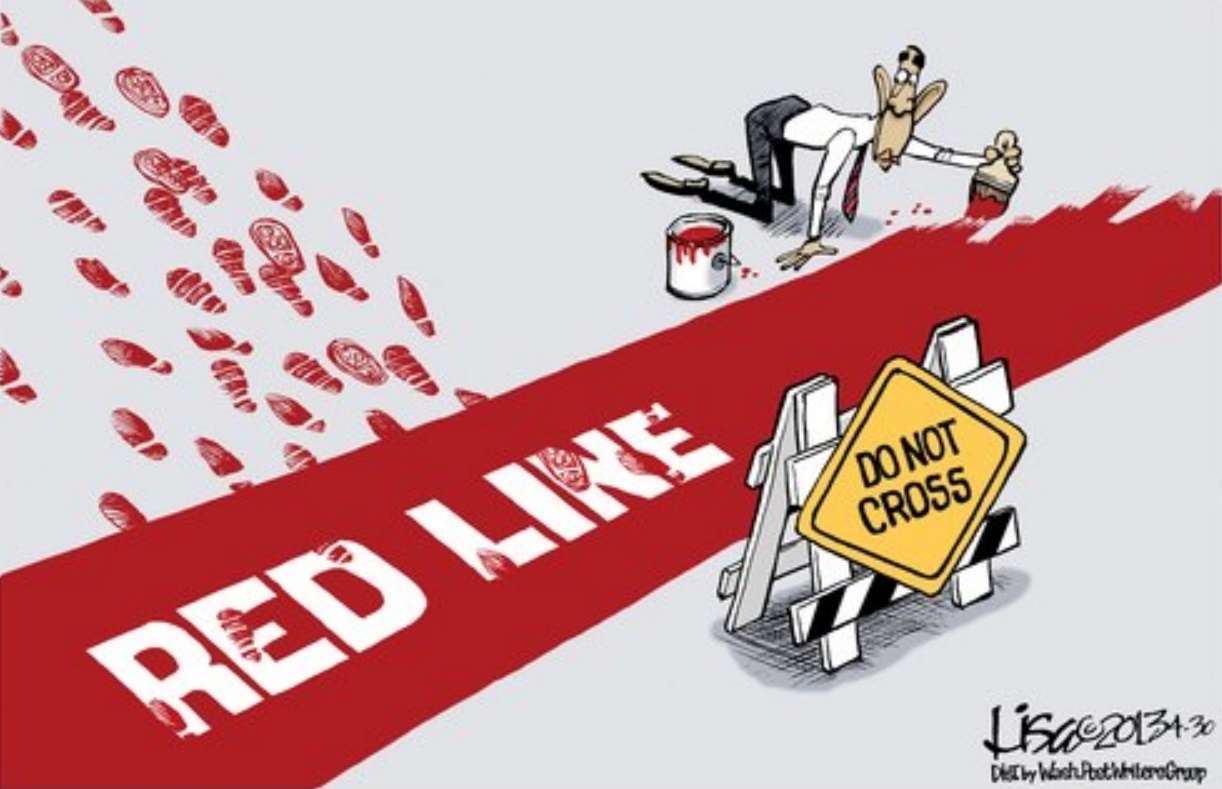 Obama took a lot of flack for his "Red Line"
threat! Obama took a lot of flack for his "Red Line"
threat!
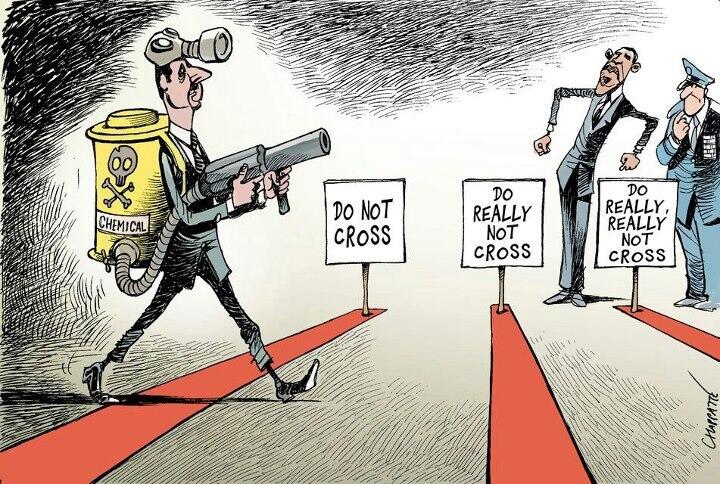
|
The worsening of the situation
In any case Assad managed to stay in relative command of a collapsing
Syrian society … despite the efforts at this point of Obama and the
West to bring Assad down. In fact, America – in concert with Saudi
Arabia – began secretly to ship military items (even tanks) to a group
of anti-Assad militants (the "Free Syrian Army") supporting the Syrian
National Coalition … recently formed by various groups outside of Syria
– for various reasons. For Obama, supposedly this group would bring
true "democracy" to Syria. To Saudi Arabia (and others) the purpose was
to undercut the Shi'ites (Assad's Alawi were sort of a Shi'ite faction)
and bring Syria under Sunni Islam.
In any case, it would not be this Coalition that would advance the
Sunni Muslim cause but rather individual Muslim jihadists who gathered
in war-torn Syria to put in place their jihadist dream of a restored
Islamic caliphate (Islam's traditional society headed by a "caliph" or
"successor" to Muhammad). They organized themselves around a political
organization known in the West as the Islamic State of Iraq and Syria
or ISIS1 … taking
control of a huge amount of territory in chaotic Syria and a bitterly
resentful Iraq … Sunnis angry that Americans had turned their formerly
Sunni Ba'athist government over to the Shi'ites. Indeed, in 2014, ISIS
was able to put in place that very caliphate, under Abu Bakr
al-Baghdadi.
And at this point ISIS was drawing fired-up young Sunni Muslims to the
region to join the great jihad … butchering in the most graphic ways
(recorded on camera and displayed to the world via the internet) any
one they deemed opposed to their mission and blowing up Shi'ite
mosques. They even (beginning in June of 2015) blew up the formerly
well-preserved 2000-year-old Roman town of Palmyra – that too displayed
proudly on the internet as another great Sunni achievement … along with
all the captured Syrian soldiers, medical personnel – and men, women
and children of the town – also butchered in typical jihadist style. By
the end of 2015, ISIS held within its territorial control some ten
million people, under the command of some 30,000 jihadists.
1ISIS's
roots reached back to 1999 when the Salafi Jihadist Abu Musab
al-Zarqawi founded a jihadist organization designed to collapse the
Western political-social-cultural order … which would go on to support
bin Laden's al-Qaeda organization … and other similar jihadist groups –
culminating in ISIS.
The Islamic Caliphate or State (ISIS)
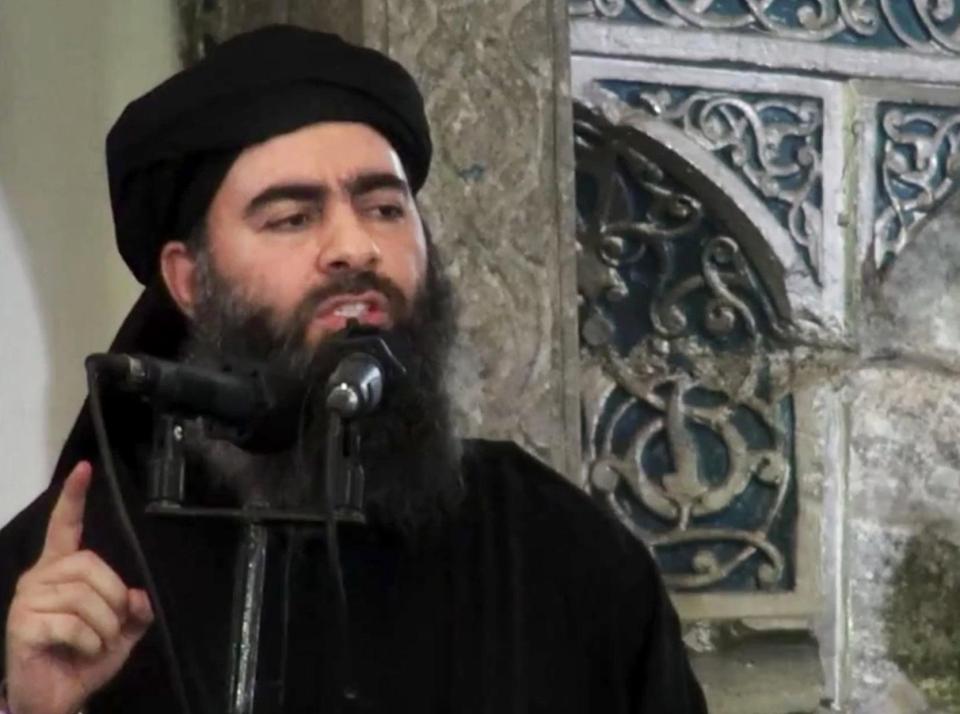
They
claimed that out
of the chaos of Syria (and a highly disenchanted Sunni Iraq in the
country’s northwest) they were going to build a new social order
founded on the strictest rules of the Islamic faith. They would
"cleanse" the society of anyone not submitting to this new regime of Shari’a (Muslim law). The beheading of men and stoning of women
became the
hallmark of the new regime, graphically presented in video
streaming … making their point … and attracting a huge number of
disenchanted Muslim youth (from even America and Europe ... as
well as the Middle East and Africa) who wanted to be part of such a
major event
as the restoration of the Caliphate.
|
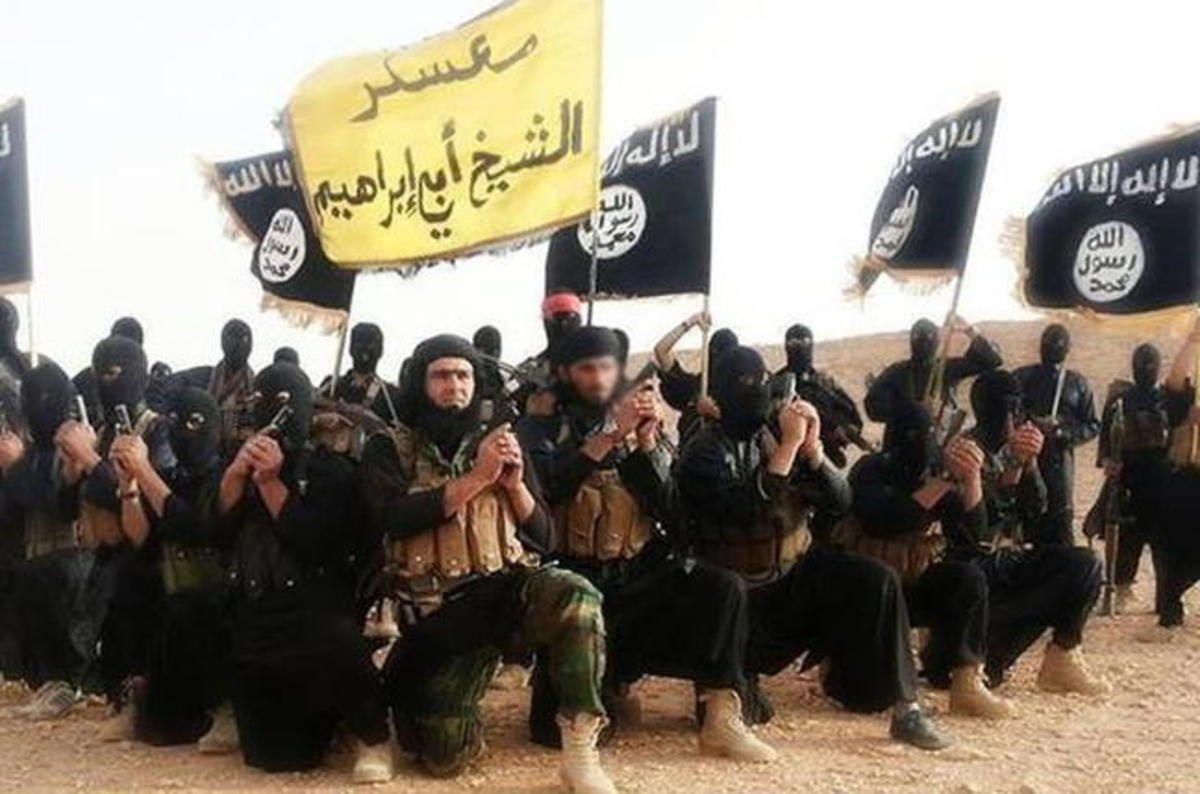
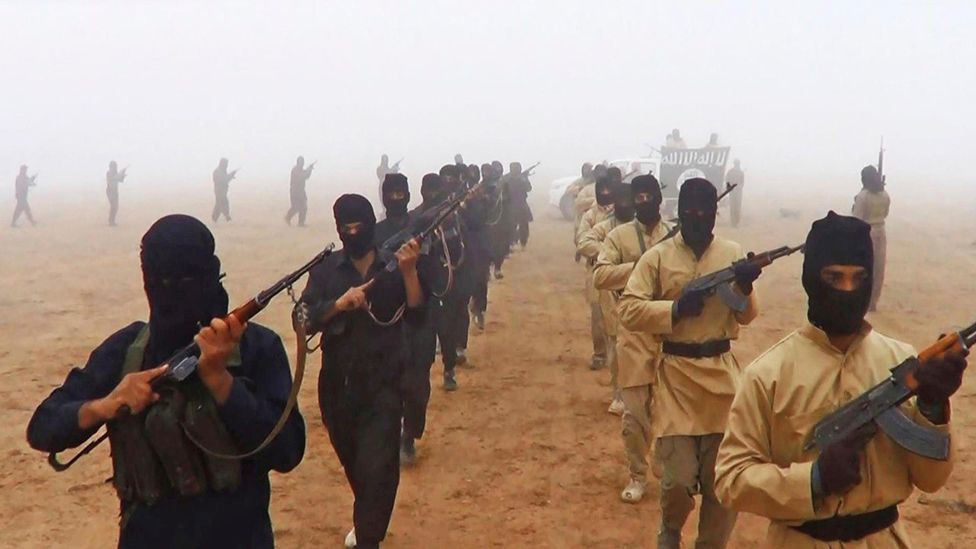
By
mid-2015, ISIS had spread its control along communication lines
connecting vital parts of
northern Iraq and Eastern Syria … and were
trying to reach into Kurdish territory in the Iraqi
northeast.


Roman ruins at Palmyra leveled by ISIS - 2015
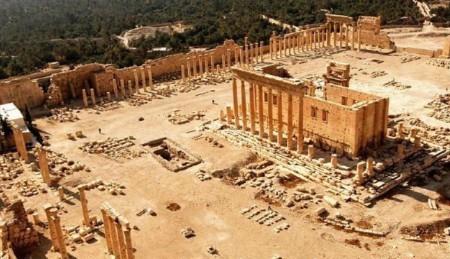
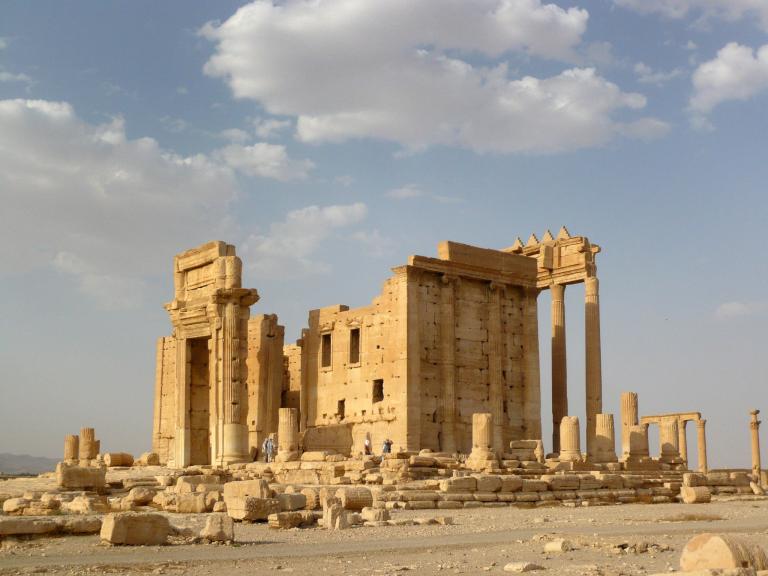
The world was shocked when ISIS displayed pictures of the
1900-year-old Roman Temple of Bel
in Syria that they had just systematically destroyed.
(August 2015)
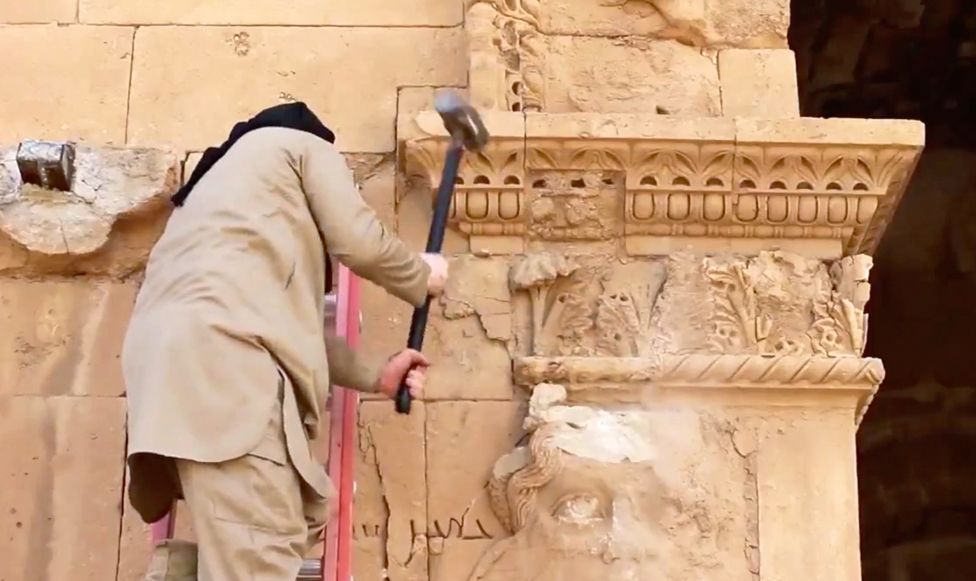
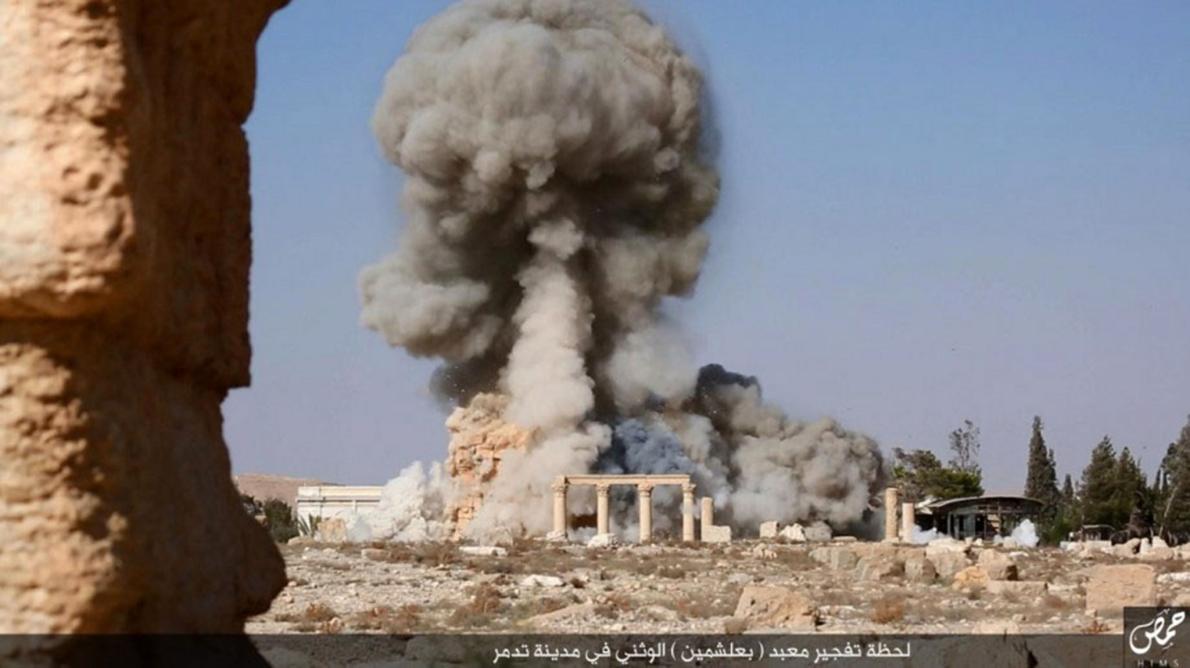
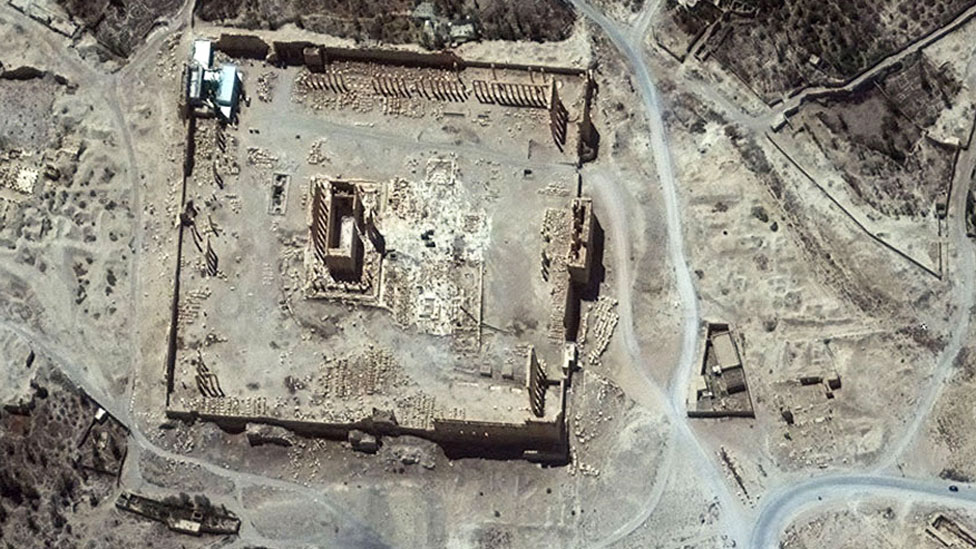
The Temple of Bel (or Baal) before /
and after ISIS had done its work
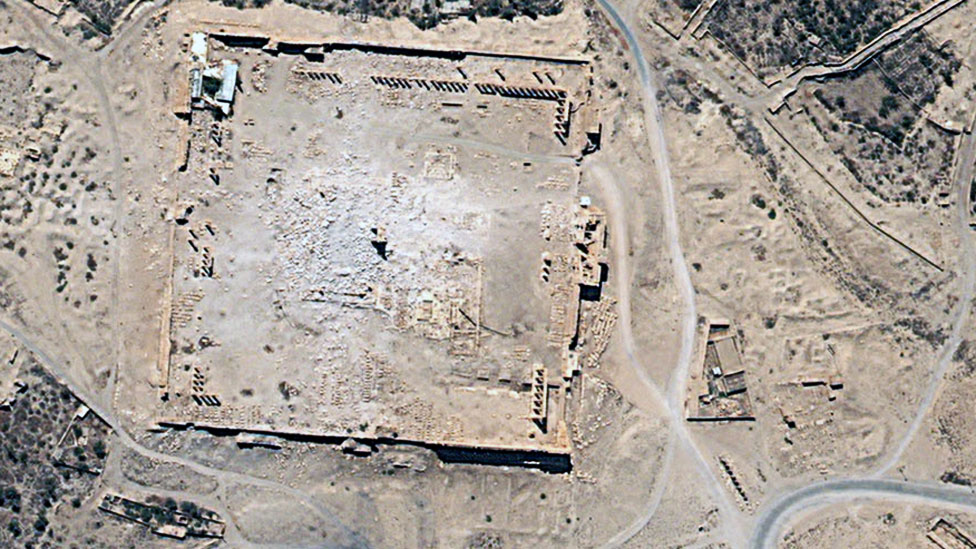
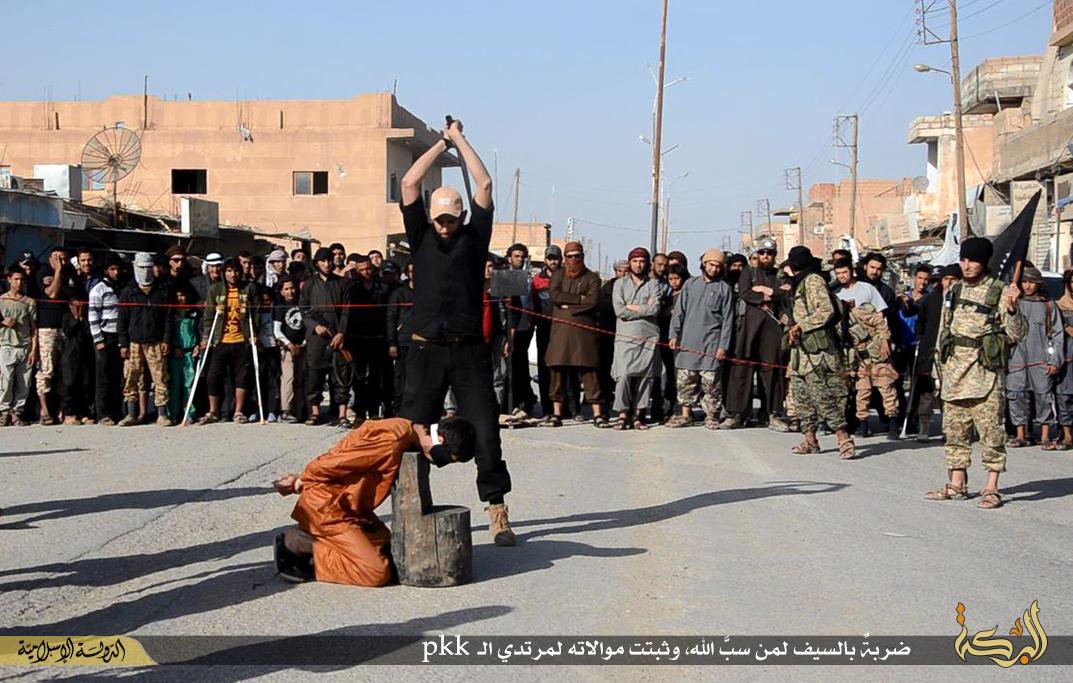
ISIS
beheadings were sent out as internet videos to frighten enemies …
and
woo budding jihadists into joining the movement (March
2015)
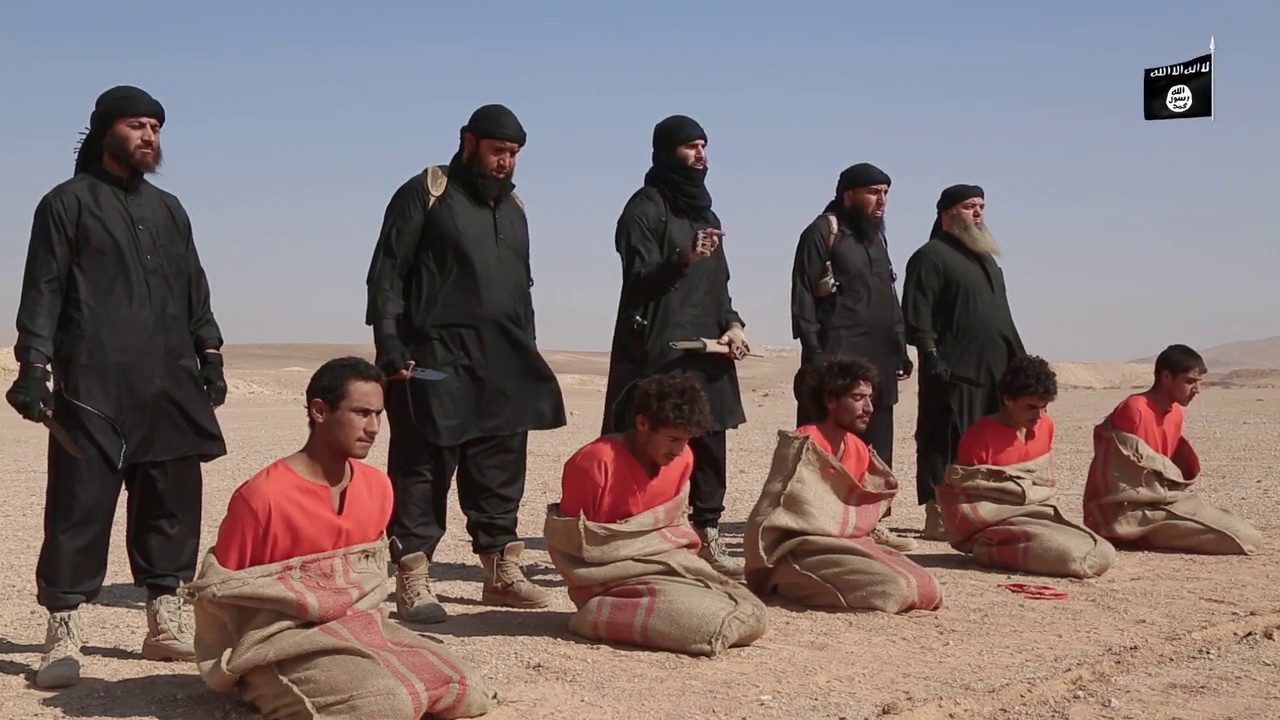
(December
2016)

An Iraqi woman stoned to death in Mosul City …
for having
refused to marry an ISIS jihadist (Oct 2016)
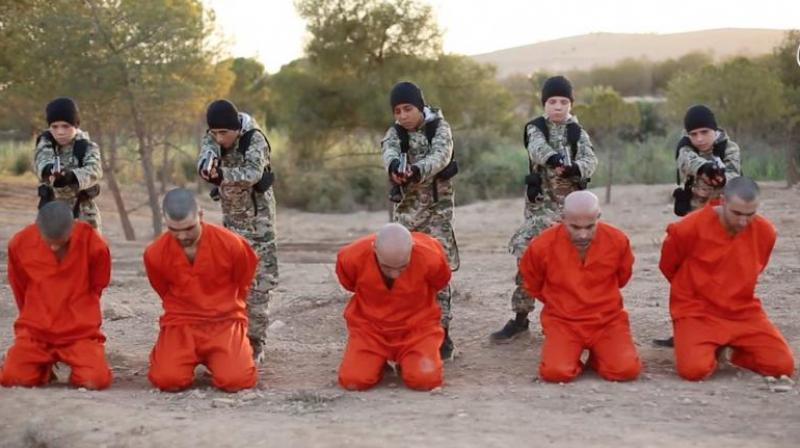
ISIS children executing Kurdish prisoners (the second from the
right is an 11-year-old English boy)
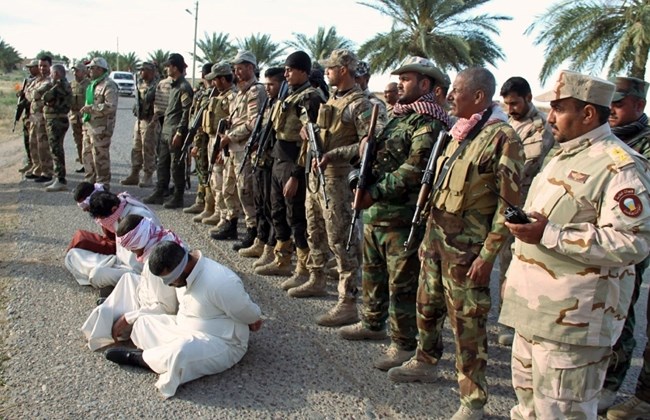
At the same time Iraqi forces (heavily Shi’ite) strike
back where they can
… in an attempt to retake territory seized by (Sunni)
ISIS.
|
The spread of the disaster
Not to be left out of all the excitement, the youthful spirit of reform
even spread to the West itself, with young protesters taking to the
streets of Athens in June of 2011 – to take on violently the police
sent to disperse the growing mob that had gathered there to protest
against various Greek injustices. And in England, in August of that
year, minority youth took up the cause … to plunder, then torch,
various neighborhoods of London – and then other British towns as well
– their purpose being …? And by that October, Italian youth had joined
the fun, torching sections of Rome in protest against "economic
injustice."
Nor were young (and some older) Americans going to pass up this
opportunity to protest against American "economic injustice" … citing
an older attack opposing the 2008-2009 Washington bailout of failing
American corporations - that is, attacking the "too big to fail"
mentality behind the rescue of American capitalism – as they moved to
"Occupy Wall Street." For two months (mid-September to mid-November)
they settled themselves into the heart of the Wall Street neighborhood,
protesting economic inequality, greed, income inequality, and whatever
other sins they detected in the way America worked economically and
socially. Having tolerated this event long enough, finally on the night
of November 15th, New York police forced the protesters to shut down
their encampment and move on. Attempts would later be made to start the
process back up again. But these failed to take hold. Whatever Occupy
Wall Street was designed for seemed ultimately to have virtually no
impact on American society … other than to have given the news
something to keep themselves busy reporting.
|
In the summer of 2011 Greek youth take to the streets to protest the economic austerity measures undertaken by the Greek Parliament in order to bring the nation's horrible finances back under control.
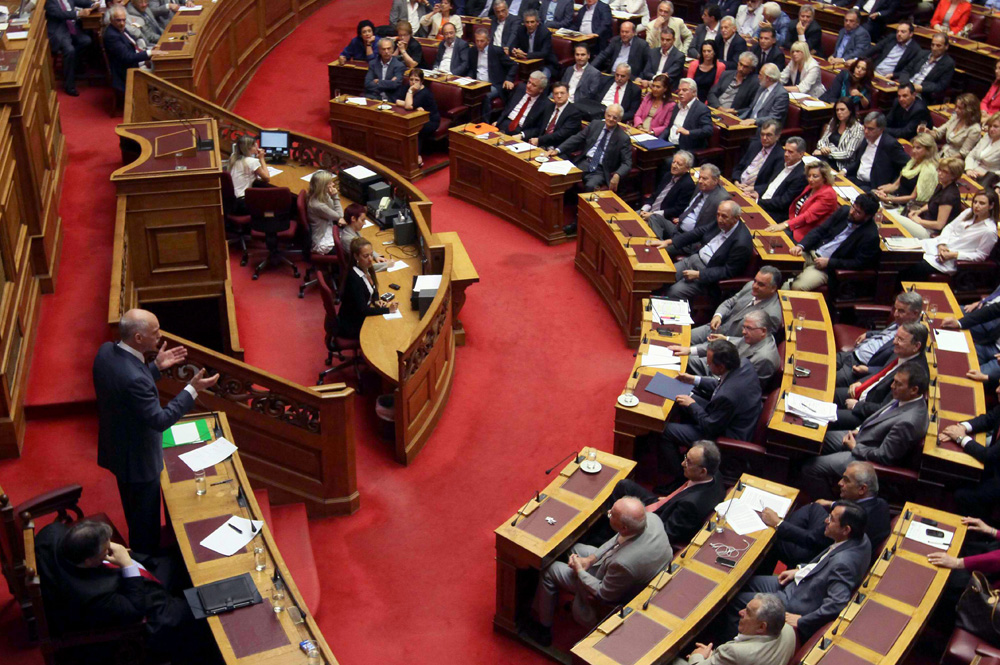
Greek prime minister George
Papandreou addresses lawmakers on June 29, 2011 after voting in parliament
passed an austerity package amid angry street protests
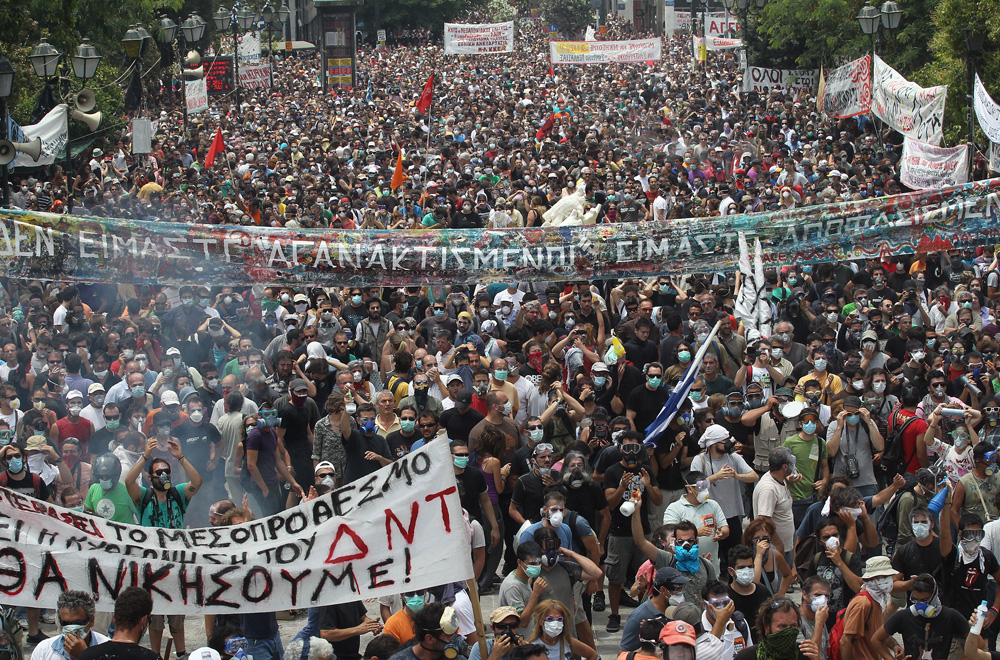
Demonstrators carrying banners
march towards the Greek parliament in Athens during mass protests on June 29, the second day
of a 48-hour general strike against proposed austerity measures
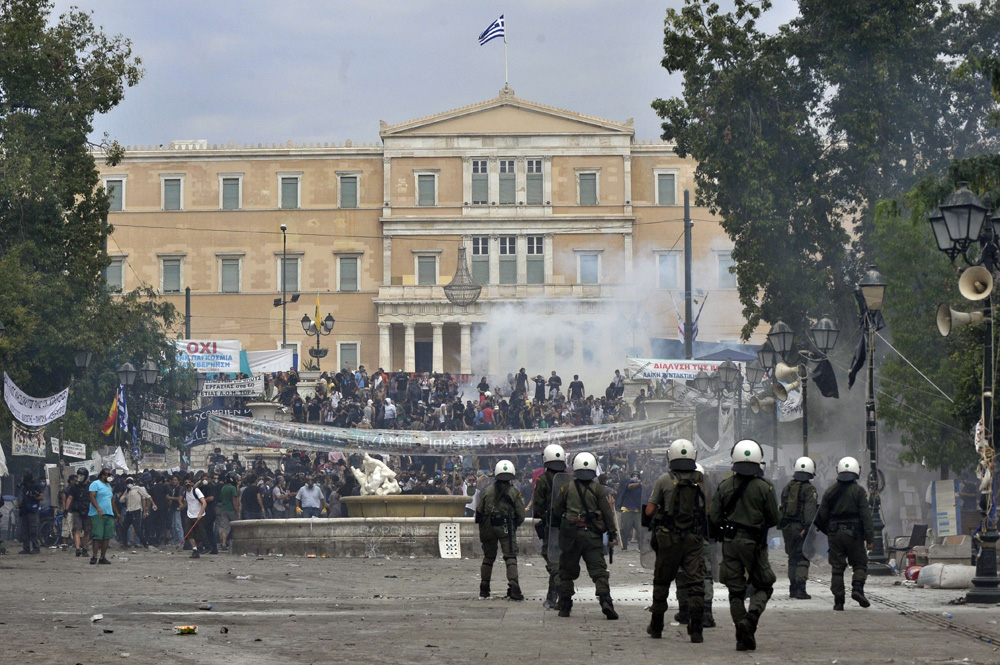
Riot police enter Syntagma
square during the 48-hour general strike
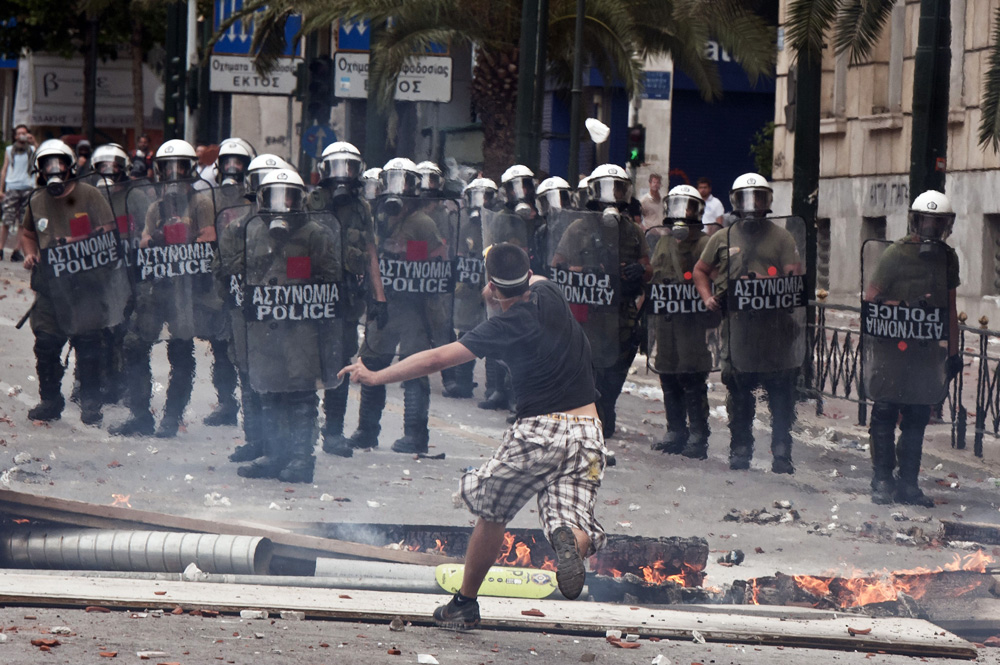
Protests quickly turn very violent
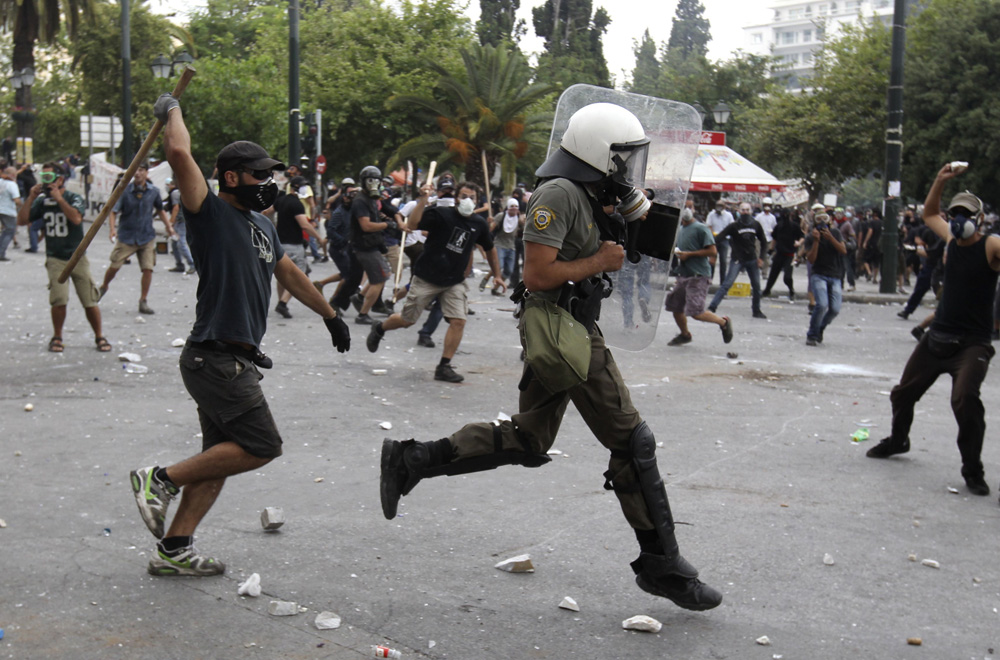
Protesters attack a policeman
during protests around Syntagma square in Athens on June 29
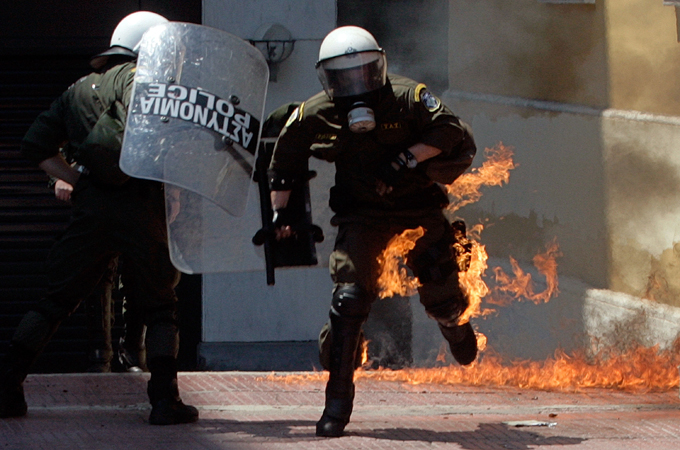 A policeman in trouble
A policeman in trouble
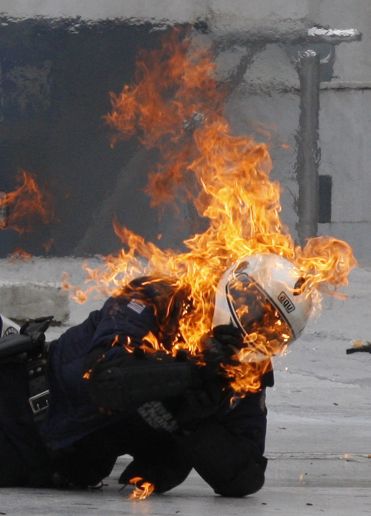
A motorcycle policeman tries
to remove his helmet as he burns after protesters
throw a petrol bomb in
Athens
This spirit is quickly picked up the youth of Britain's huge ethnic "minority" population
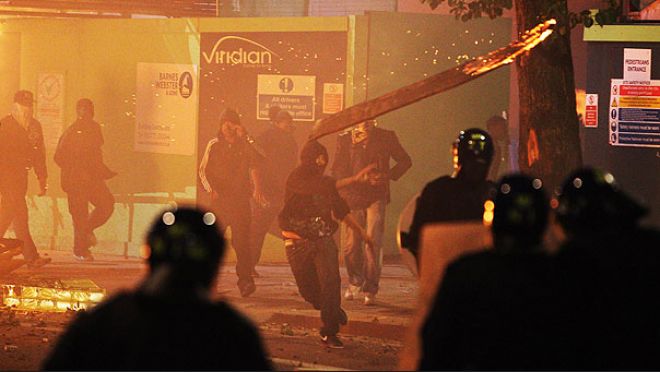
In Pictures: London's burning,
day 3 – August 9, 2011
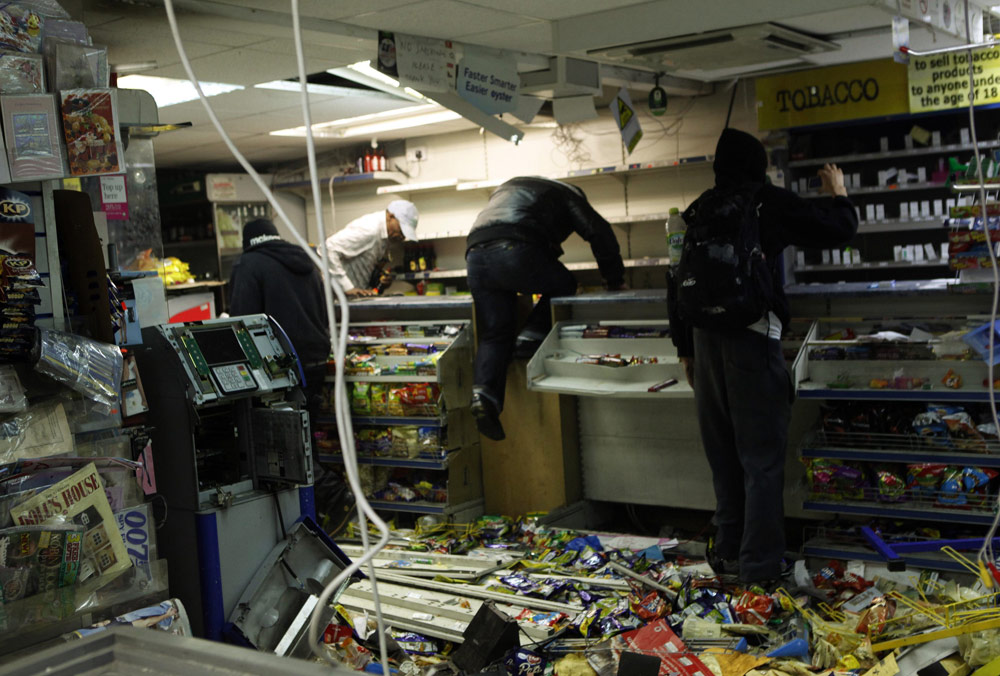
Hackney, East
London
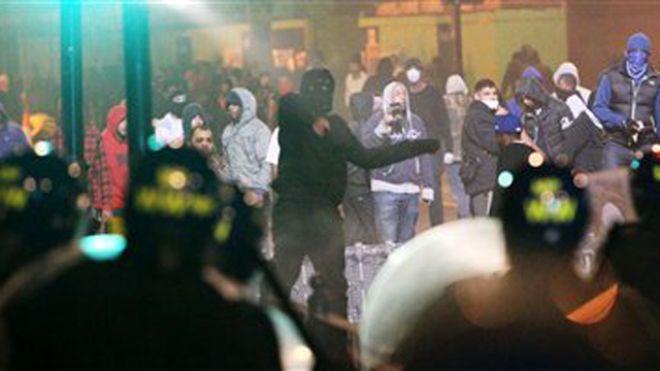
Peckham, South
London
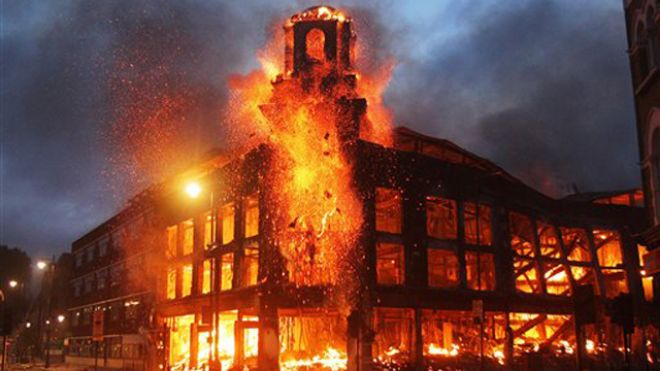
Croydon, South
London
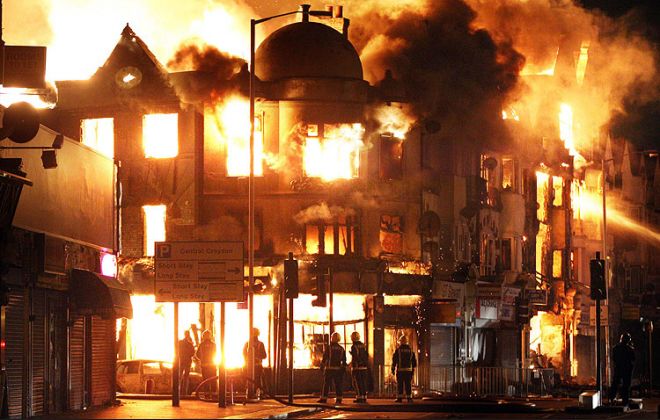
Sporadic violence continued
for a third day in parts of London and spread to other cities
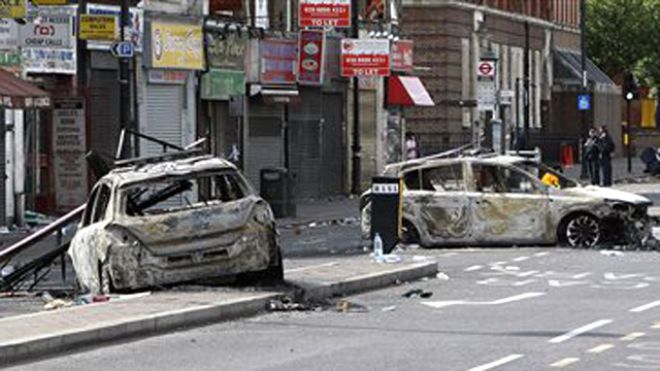
Even the "Occupy Wall Street" movement in America
seems somehow connected to this 2011 spirit of protest sweeping the world

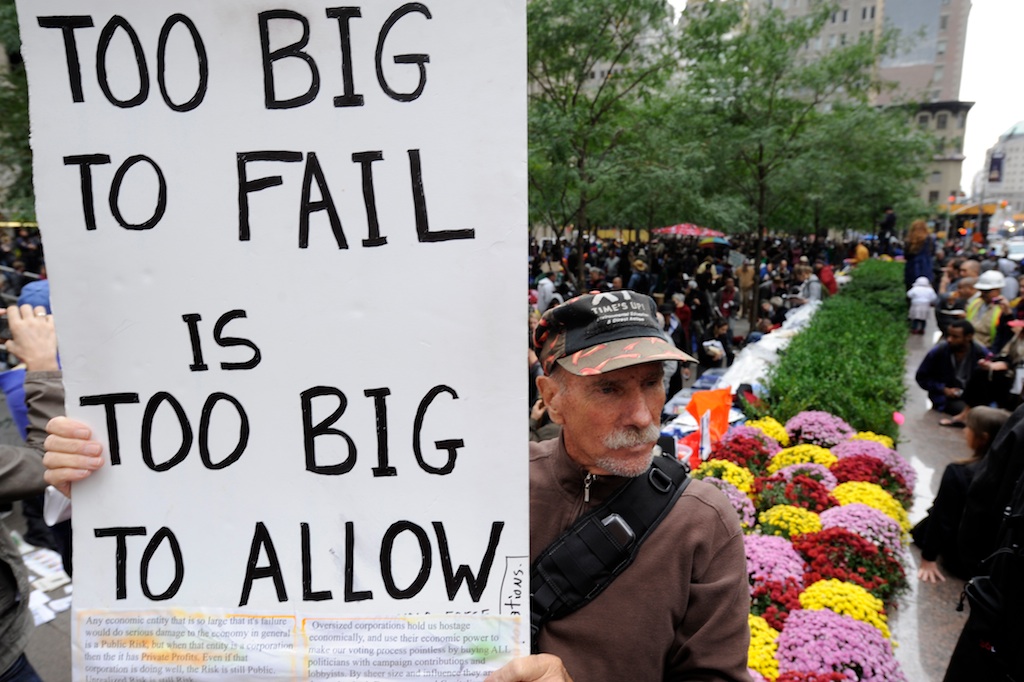


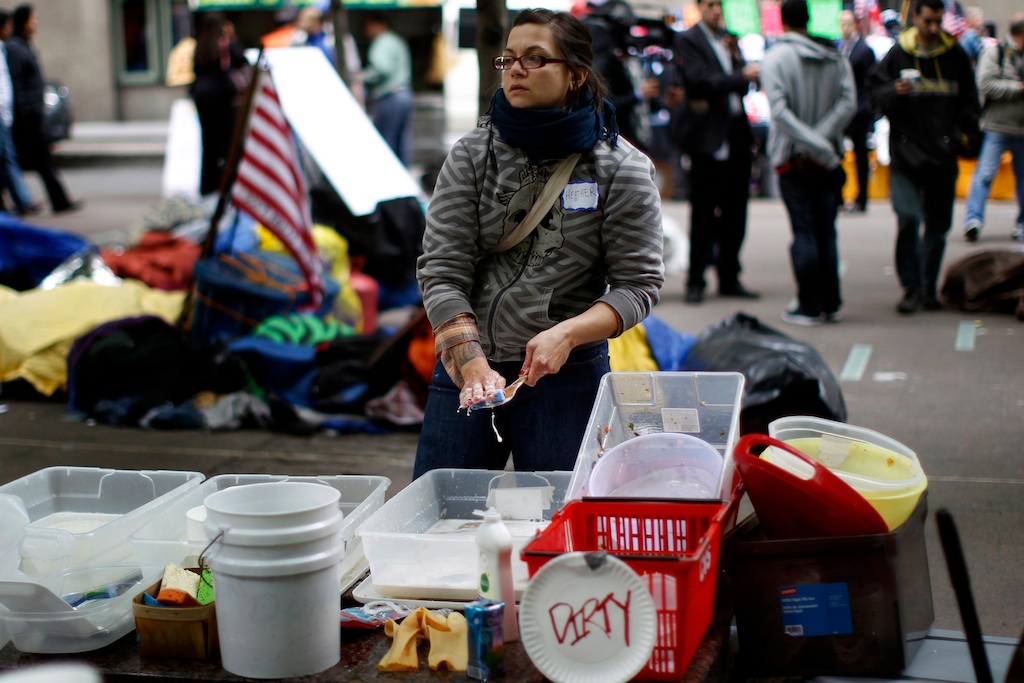

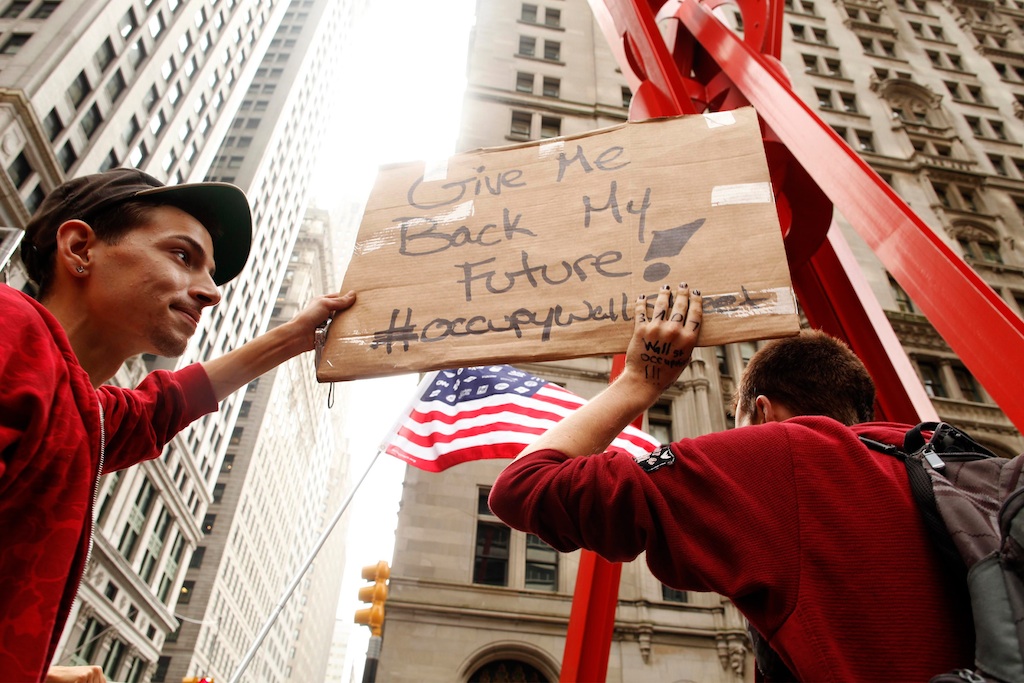

And
Italian youth … not wanting to be left out of the fun … gather in
Rome in October (2011) >to protest against economic injustice. As
in Athens and London, things turn violent.
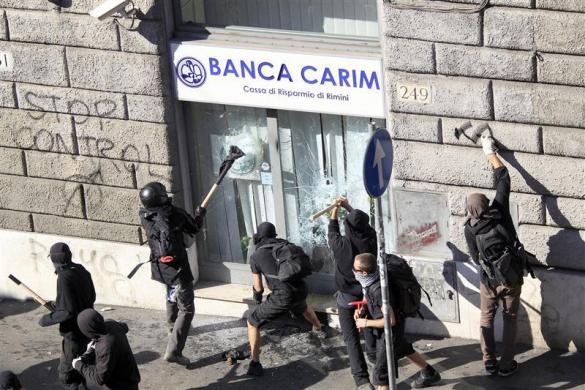 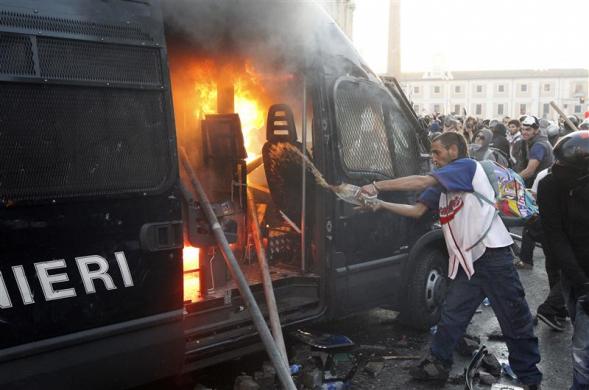
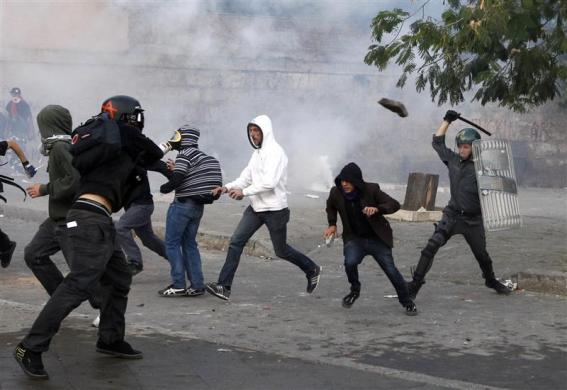
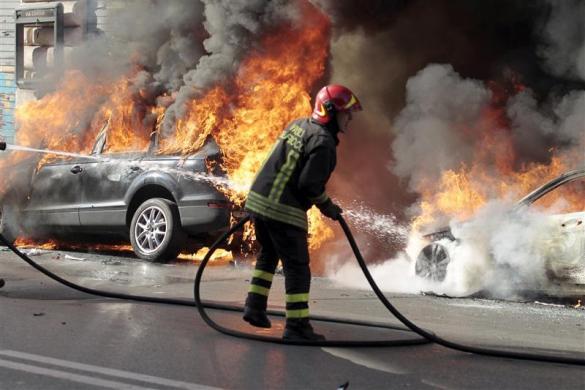
|
The truly tragic part of all this – of the Arab Spring – however, is
what it did to Syria (and parts of Iraq). The decision of the larger
world to get involved in the Syrian social breakdown turned matters
there much worse – far, far worse. As a result of the civil war – and
of the takeover by ISIS – huge parts of Syria became totally devastated
(its cities in deep ruin) and humanly uninhabitable. As a result,
millions of Syrians found it necessary to flee the violence and
economic collapse hitting them. But where were they to go? But by early
2018, some 5½ million Syrians had escaped to very dismal refugee camps
in Lebanon, Jordan, Turkey and Iraq. But others were able to get to
Europe, where Greece, Italy, France, Germany and others took them in.
Indeed, Germany alone took in over a million refugees … including some
from Iraq and Afghanistan.
|
A Syrian refugee camp – part of the 1.4 million Syrians driven from
their homes as of April 2013. By 2017 that number will reach 7
million.
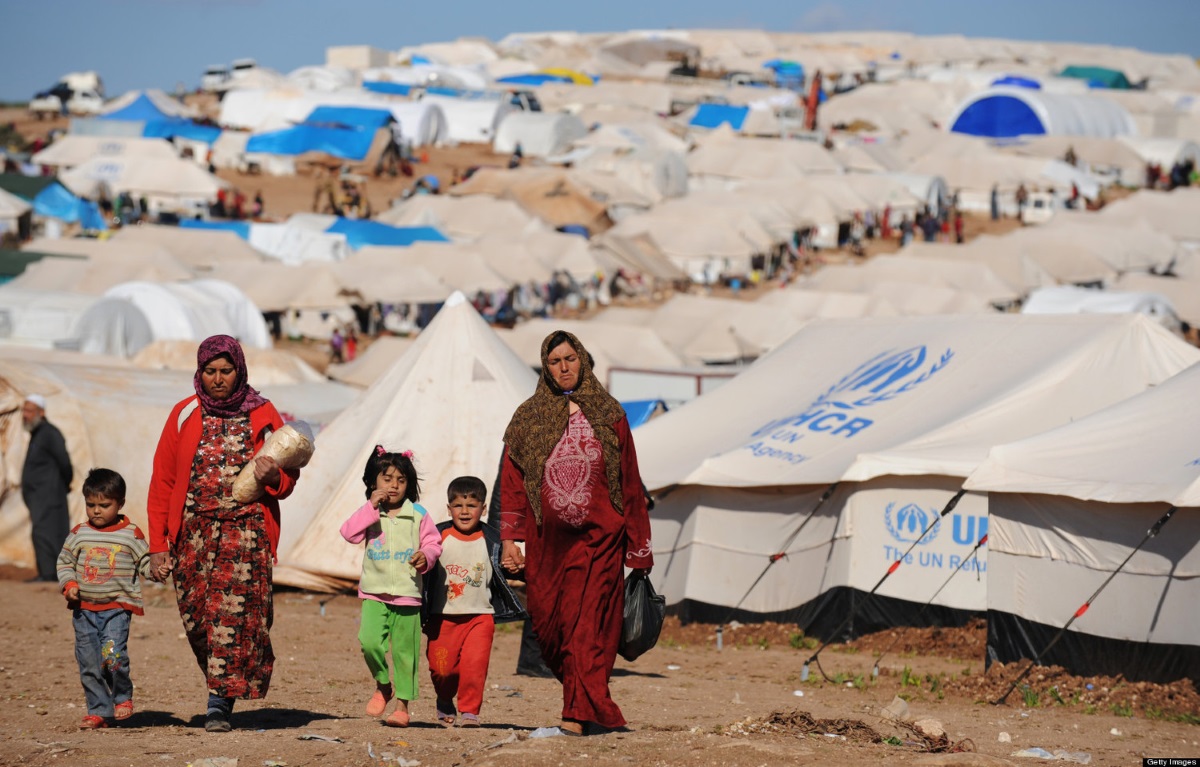
A UN-run refugee camp in Lebanon – 2013.
All
of this merely increased the desperate flow of refugees … particularly
out of Syria where
ISIS was extremely cruel to non-Sunni Arabs
(including many Christians). This of course
presented a
major problem to the surrounding countries … which did not want to take
on the burden of a massive number of impoverished
refugees.

August 2013 – Refugees heading toward Iraqi
Kurdistan
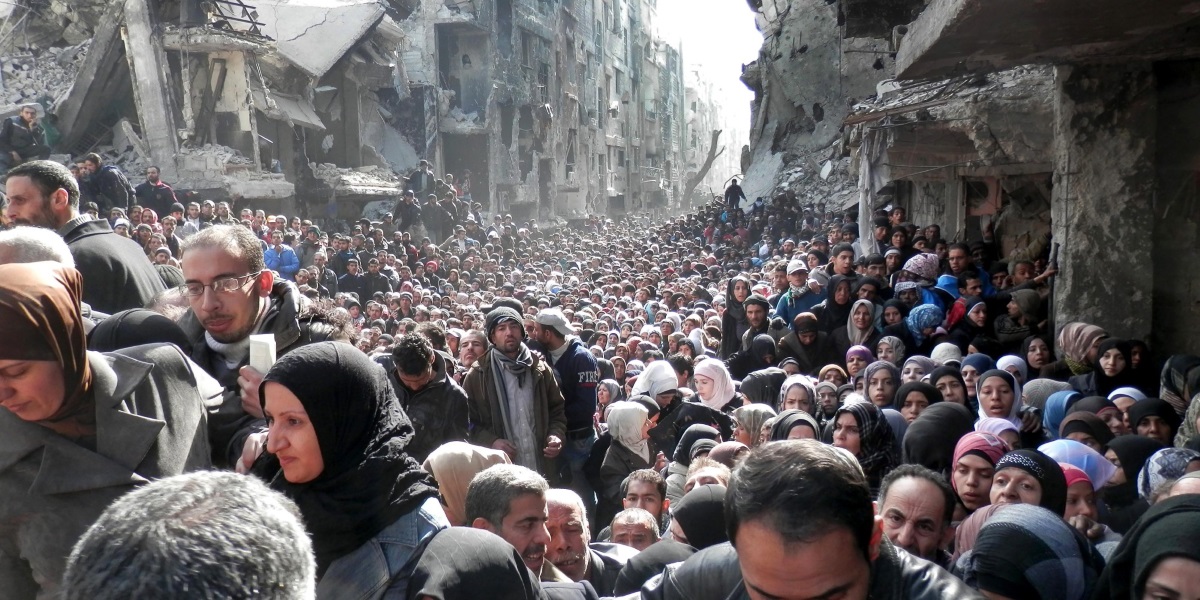
February 2014 – more Syrian refugees moving out of their destroyed
cities
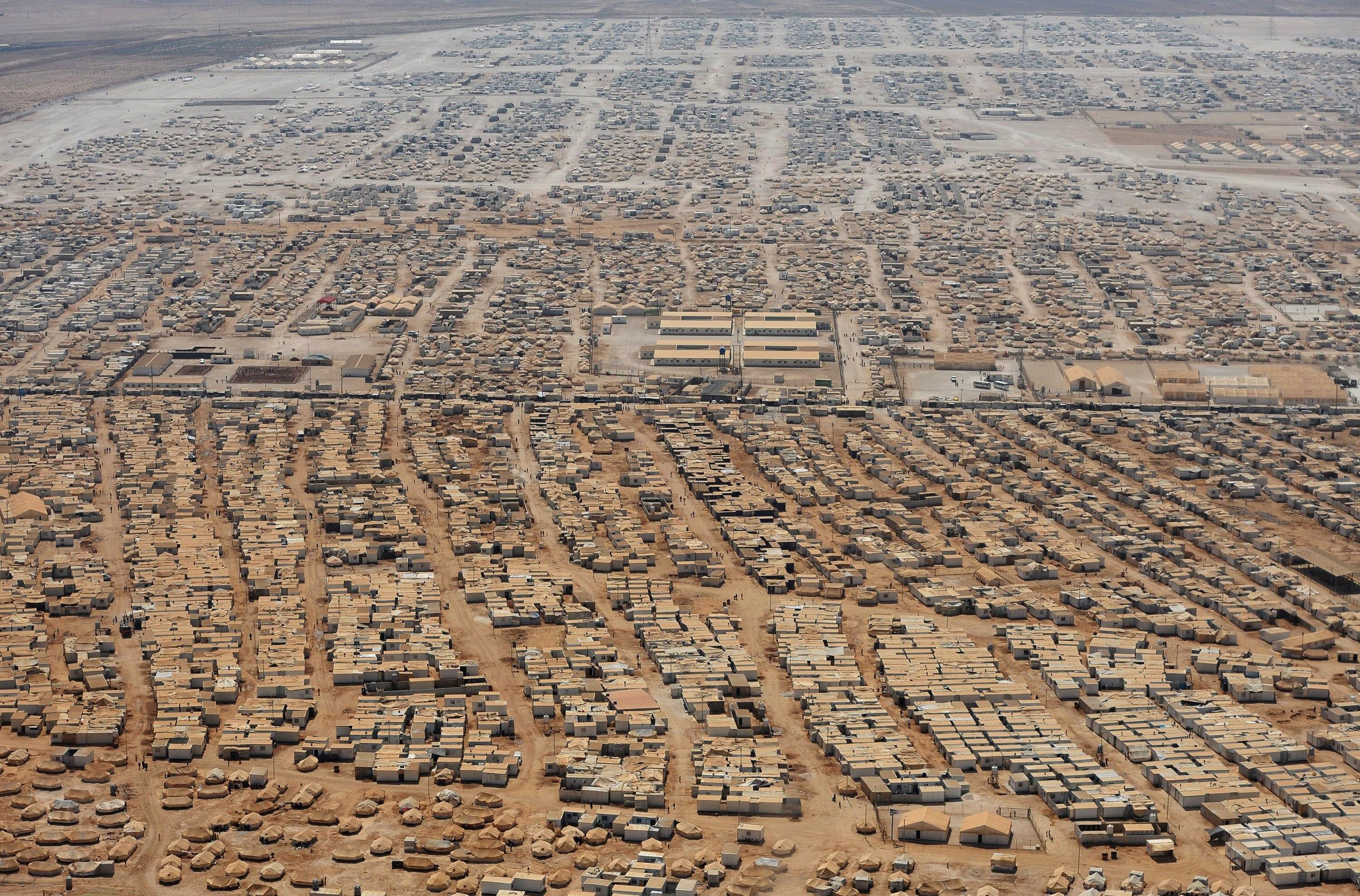
A Syrian refugee camp in Jordan with
115,000 residents. By 2015
fully 25% of the population of Lebanon was made up of Syrian refugees and 20% of the
Jordanian population ... with huge numbers of Syrians scattered all around the
countries bordering on Syria ... and even beyond.
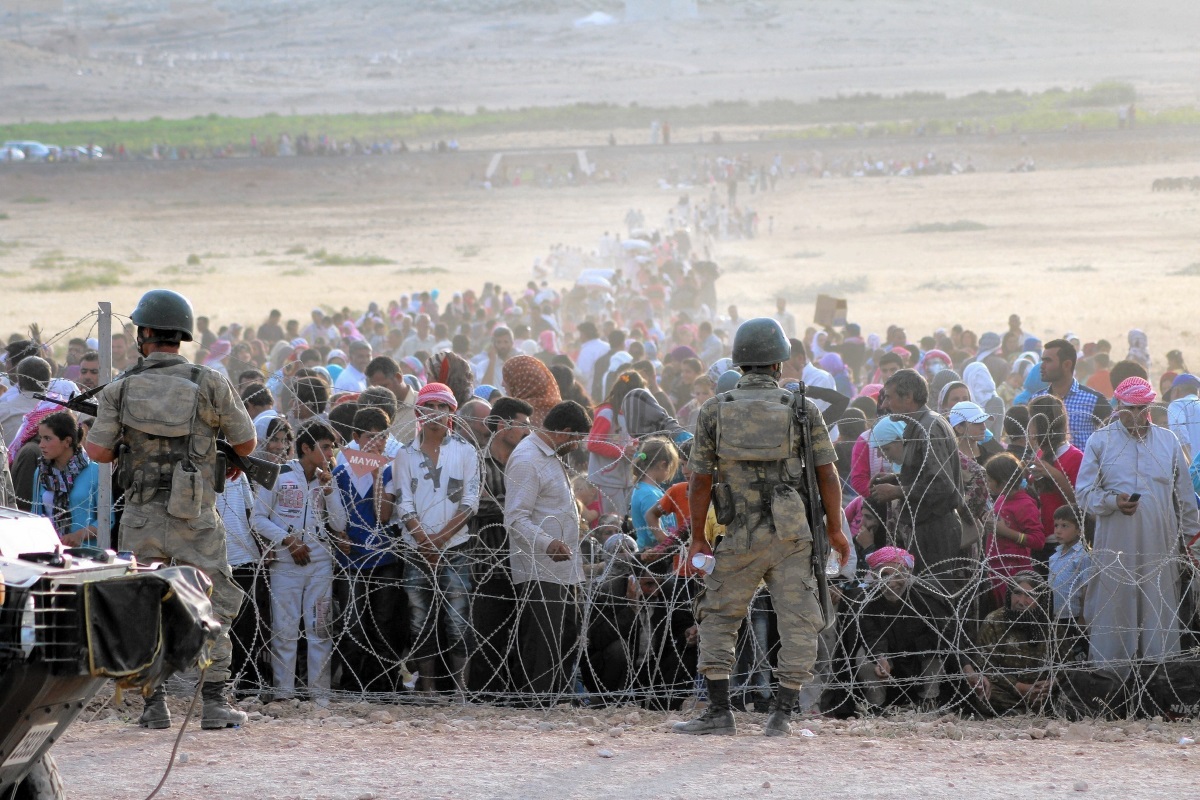
Many other Syrians have simply taken to the road
... trying to reach well
beyond the Syrian borders ... even to Europe
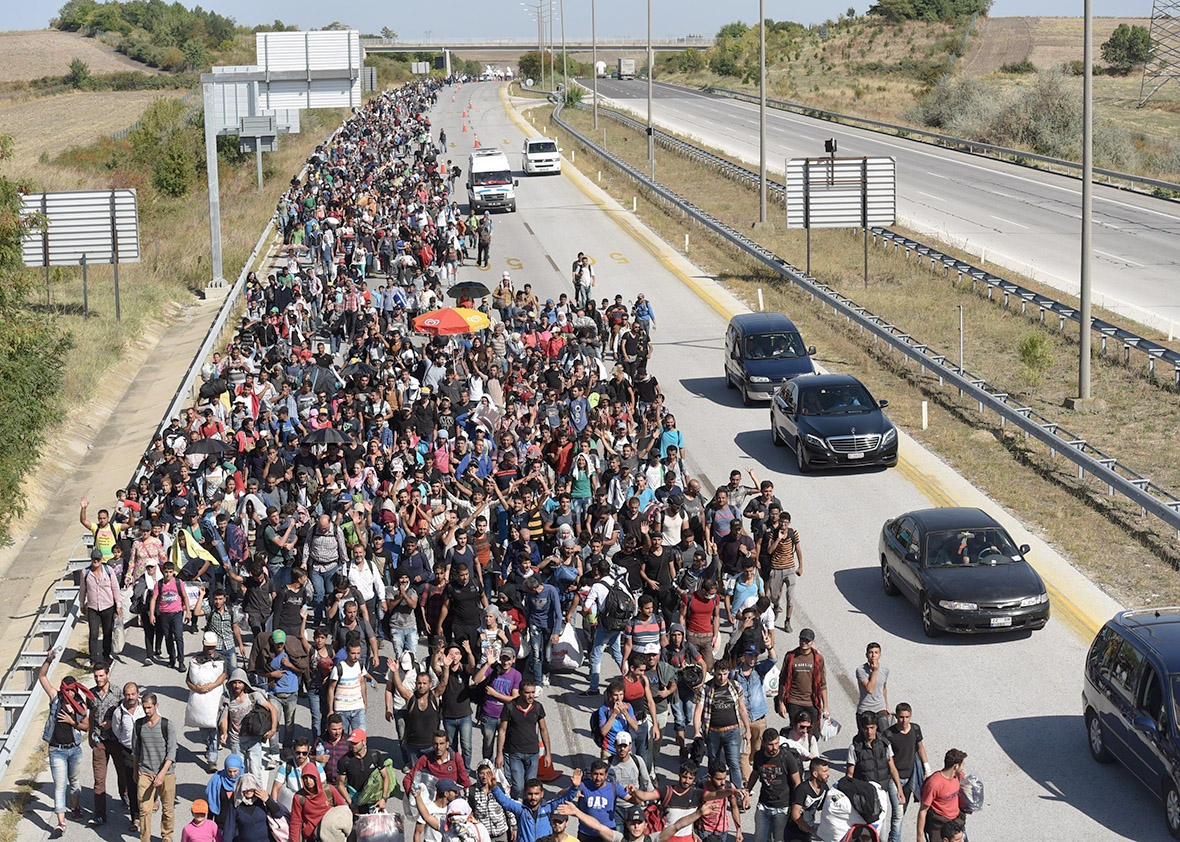
September 2015 -
Syrian refugees heading across Turkey to Greece
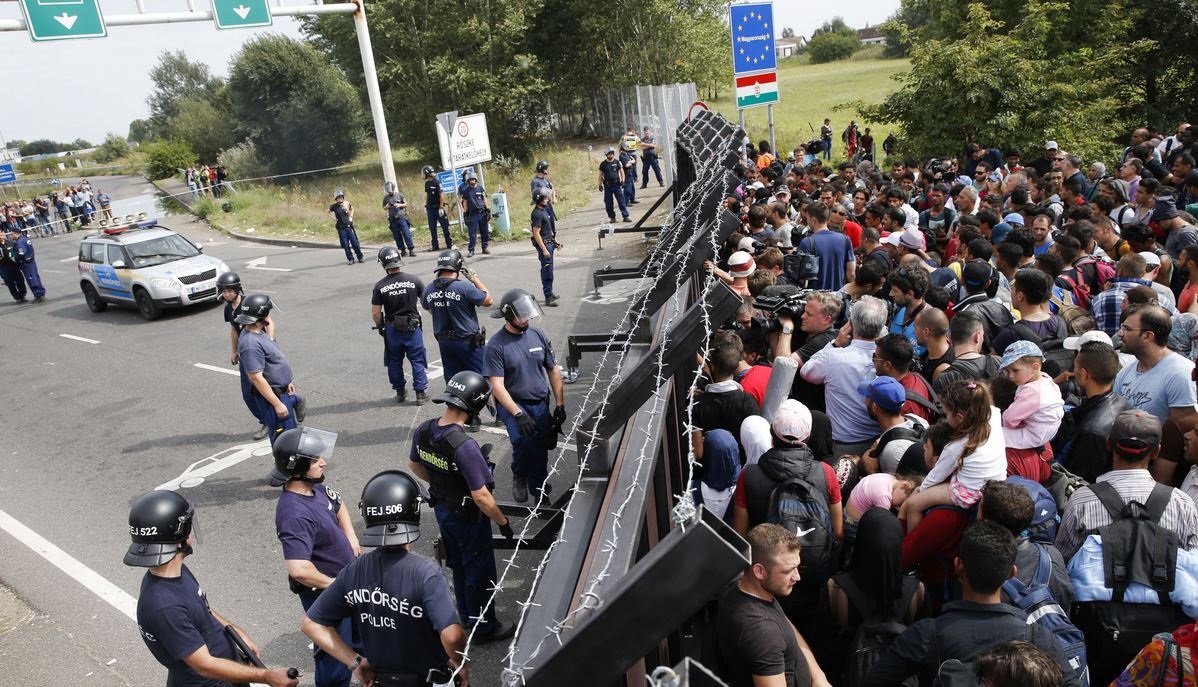
Others
passed on through the Balkans … but got stopped at the Hungarian border
…
which had put up barriers to stop the flow of refugees into Hungary
(2015)
|
Lessons not learned
Once again, the West's (particularly America's) devotion to the crusade
to spread democracy to the rest of the world (by force if necessary)
succeeded only in making a social crisis far, far worse than it should
have been. Rather than helping a leader of a country maintain some
degree of control over the instinctive love of youth to take to the
streets to improve a world they are just getting to know (and thus know
very little about it at that point), the West chose the side of the
protesters … seeing in such fired-up behavior the roots of the personal
freedom that they have long supposed – since the time of Rousseau back
in the French world of the 1700s – is the underlying foundation of
democracy. The failure of the French Revolution in the late 1700s
should have made it quite clear to these dreaming Idealists why it is
that this type of thinking is virtually guaranteed to produce nothing
but social disaster.
It is easy to wonder what the International Criminal Court – had it
existed at the time – would have tried to do about Lincoln committing
"crimes" against his people – which they accused Gaddafi of doing –
when in 1861 Lincoln sent his troops against American Southerners
intent on preserving slavery by breaking from the American Union. Thus
too, under these "higher" moral terms of the ICC – and Western
Liberalism in general – Washington should never have been allowed to
put down either Shay's Rebellion in 1786 or the Whiskey Rebellion in
1791. Instead, the new American union should have been allowed to go
down the "natural" democratic route … one guaranteed to collapse into
social chaos an otherwise long-standing (since the early 1600s),
self-created and self-disciplining America – an amazing society that so
many Americans had just died in the recent war with England to preserve
and protect.
Apparently, under democracy, a society has no right to use its
disciplining forces to stop a bloody rebellion from destroying it.
But this is exactly the reason that America's Founding Fathers, in
putting together an American Constitution in 1787, were dedicated to
founding a Republic … not a Democracy. They were very clear on this
matter because unlike today, they knew their own Western history very
well … and they understood completely the verdict of Aristotle about
good and bad government. They understood that a good society is built
not on the particular form of government, whether by one, a few, or the
many – but instead on the strength of the moral foundations holding
that society together … and guiding its government in keeping it moving
ahead on exactly those foundations. They knew from the Roman
philosopher-politician Cicero what happens to a society when it decides
to "upgrade" those foundations on the basis of some new sense of higher
enlightenment on the part of supposedly well-meaning individuals or
groups, an "upgrading" that throws the whole moral-legal basis of that
society into confusion … and ultimately bloody tyranny.
In short, you don't mess with a community's structure. True, there are
issues – political, economic, and social – that constantly need to be
addressed. But you don't throw the moral-legal structure itself into
confusion with "revolutionary" changes … especially those that are
built simply on the whims of an ambitious leadership or on the fiery
impulses of a people. Political tyranny is guaranteed to be the end
product of such a dynamic … and never a new society now enjoying
greater peace and prosperity.
This is the reason that the Founding Fathers chose to bring the former
colonies, but now independent states, together in a Federal Union as a
Republic … and not as a Democracy. They understood that a Republic is a
society built on a strong foundation of Law … not on the ever-changing
(and usually very selfish) human desires of this or that group or party
of the demos (the people) … typical of a democracy. They were fully
aware of the way democracy is easily led by ambitious people-charmers
or "Sophists" to do very short-sighted, solely self-interested, and
thus socially self-destructive things.
True, they would give voice to the people themselves in the House of
Representatives. But the rest of the Federation was built on much
narrower political entitlements expected to give a necessary
conservative voice to American governance: respected members of the
Senate chosen by the governors or assemblies of each member state, the
President chosen by an Electoral College whose members were also chosen
by the officials of each member state, and Federal judges appointed by
the President and confirmed by the Senate.
Of course these limitations would irritate greatly the rising voices at
the beginning of the 20th century (Woodrow Wilson and his Democratic
Party in particular) in favor of pure democracy … who felt it
imperative to change what they could of those limitations on purely
popular government found in the Constitution.
Thus also began the grand effort to "make the world safe for democracy"
… involving an America jumping into an unprecedentedly bloody war –
done so on behalf of such "democracy," which if successful, President
Wilson assured the American nation would make this horrible war "the
war to end all wars." What blind idiocy ... but an idiocy that refused
to go away.
Thus by this time – as America and the West took up the challenges of
the newly rising 21st century – the wisdom of the Founding Fathers had
been long-forgotten in America (now clearly leading the West with its
new version of "political wisdom") … by Bush Jr., who presumed that he
was going to bring democratic freedom to both Afghanistan and Iraq –
and then by Obama, who planned to do the same in other parts of the
Muslim Middle East. Intense suffering on the part of millions would be
the only result of such cruel stupidity.
Russia
had been under the direction of Vladimir Putin since the beginning of
the 21st century … in one way or another. He was a former KGB officer
(16 years with the KGB), then a politician who eventually (1996) joined
Yeltsin's Administration as head of the new Federal Security Service
(taking up the role of the former KGB), then briefly Russian prime
minister (mid-1999 to mid-2000), and then acting Russian president when
Yeltsin resigned. That fall he was elected Russian president, then
reelected four years later.
But the Russian constitution allowed only two consecutive presidential
terms … so in 2008 Putin had one of his cabinet ministers, Dmitry
Medvedev, run as president under his own authorization – with the
understanding that Putin would then be appointed as prime minister.
From this position, the highly ambitious Putin could continue to run
Russia – in conjunction with Medvedev of course. That arrangement would
last during Medvedev's four years as president. At that point (2012),
Putin then could run again as president (he won easily) – and Medvedev
could serve as prime minister. This was thus jokingly termed a
"tandemocracy" – or government run by two officials in tandem with each
other! The actual fact was however that Putin was the new Stalin,
Khrushchev, Brezhnev – possessing full authority to run Russia
personally. That was, after all, the Russian political tradition since
the time of the tsars.
Meanwhile, next door in Ukraine, the situation was quite confusing. The
problem was that Ukraine is not wholly Ukrainian in language but a mix,
with Russian-speaking Ukrainians becoming a greater portion of the
population in eastern Ukraine … with the easternmost provinces (or
oblasts) of Luhansk and Donetsk being fully Russian-speaking. Likewise,
the Crimean Peninsula, complements of the expulsion by Stalin of the
Turkic peoples previously living there, was now completely Russian
ethnically. Originally part of Soviet Russia, Crimea was attached to
Ukraine in 1954 as some kind of Ukrainian gift by the post-Stalinist
leadership.
Then with the process of trying to get all the various ethnic
communities of the Soviet Union to become one Soviet-wise – meaning all
Russian speaking - considerable efforts were made not only in the
Stalinist era but also in the one that followed to make Ukraine (and
others) fully Russian-speaking. Thus education of the rising
generations was supposed to be only in Russian. Likewise business and
every other public activity. But of course many of the Ukrainians
fought back to keep their Ukrainian language and culture. So these
dynamics - and tensions - were still there when the Soviet Union
dissolved in 1991 and Ukraine found itself fully independent as a
presidential republic.
Independent Ukraine's prime minister, Leonid Kuchma, was able to defeat
Ukraine's first president, Leonid Kravchuk in 1994, … on the basis of a
promise to promote the further industrialization of Ukraine in very
pro-market ways. Actually, his way turned out to be quite corrupt …
leading the press to attack him … which he answered by shutting down
any opposing voices. Despite all that, he was reelected in 1999 and
served until 2005.
During Kuchma's second term, his prime minister Viktor Yuschenko and
deputy prime minister Yulia Tymoshenko took on the leaders (Ukrainian
"oligarchs") of the coal mining and natural gas industries (although
Tymoshenko herself was majorly wealthy as a gas industry executive!) …
causing the Ukrainian Communist Party (still in full operation) to join
with groups representing the oligarchs to have Yuschenko voted out of
office in 2001. Kuchma then replaced him with the very pro-Russian –
and Russian-speaking - Viktor Yanukovych. But Yuschenko, joined by
Tymoshenko, worked to rebuild their own support team.
As the 2004 election campaign got underway, Yanukovych accused
Yuschenko of being a Nazi (a favorite piece of slander to throw at a
political opponent) – which was far from true. Further, Yuschenko was
poisoned and badly disfigured – but survived.
But even more significantly occurred the "Orange Revolution" …
(November 2004 to the final round of the elections in January of 2005).
The first round in the voting in November was reported to have been
conducted so corruptly – in favor of Yanukovych – that masses of
protesters, inspired by Orange leader Tymoshenko, took to the streets
in anger … wearing orange-clothing symbolic of their stand. Actually, a
lot of what inspired the matter was that Yuschenko came across as "one
of the people" – the Ukrainian-speaking people. Yanukovich was viewed
as simply the tool of the corrupt Kuchma – and way too Russian to the
tastes of fervent Ukrainian nationalists.
In any case, as a result of the runoff elections (January 2005),
Yuschenko became Ukrainian president and Tymoshenko became Ukraine's
prime minister. But her position at the top of the energy issue made
her an easy political target – in Russia as well as Ukraine, as it
turned out. Charges of corruption both in Russia and Ukraine were
brought against her. And then Yuschenko turned against her … and forced
her to resign (that same December). But she was able to rally
sufficient political support for her bloc to take a huge number of
seats in the 2006 parliamentary elections … and thus Yuschenko called
her back to power as prime minister in 2007 – serving in that position
until 2010.
She ran (and barely lost) the presidential race against a returned
Yanukovych in 2010 … and then was imprisoned because of a criminal case
brought against her (likely inspired by Yanukovych) … although another
massive uprising of the Ukrainian people in 2014 would result in her
release from three years of imprisonment … and the downfall of the
Yanukovych government.
This February 2014 uprising, termed the "Revolution of Dignity," was
again mostly about Ukrainian nationalism versus Russian cultural
"intrusion" into Ukrainian society. In this, both Tymoshenko and
Yanukovych served symbolically the Ukrainian and Russian sides. The
event actually got going in November of 2013 when Yanukovych decided
not to sign a trade agreement with the European Union – as directed by
the Ukrainian Rada (Parliament) – but instead to enter into a closer
economic relationship with Russia. This is what started the calls for
Yanukovych's resignation. By the following February, a huge encampment
of youthful protesters had gathered at a square (maidan) in central
Kyiv (thus the Maidan or Euromaidan Uprising). When police were sent to
clear the square, over a hundred protesters and 13 police officers were
killed in the 5-day confrontation.
The end result (21 February) was that Yanukovych agreed to set up an
interim unity government, undertake constitutional reforms, and hold
early elections. But when police retreated from the scene, Yanukovych
chose to take himself to Moscow. And the next day the Rada voted
overwhelmingly to remove Yanukovych from office.
But this was not the only result. Yanukovych claimed that the Rada had
conducted an illegal coup … and called on Russia for help. This was
then the signal for pro-Russian groups in the eastern provinces to take
local control – even declaring full independence (such as in Donetsk
and Luhansk) … which they would then hold from that point on. Thus,
Ukrainian sovereignty in its eastern oblasts was mostly a fiction from
that point on … despite how the international community chose to view
matters.
Even more brazenly, this gave Putin (with enthusiastic support from the
Russian Diet) the opportunity to march masked and unmarked soldiers
(the "little green men") into Crimea (February and March of 2014) and
grab the Russian-Ukrainian joint naval base – and end the Ukrainian
part of the naval partnership. Crimea was now fully a Russian oblast …
though it still had to be reached by land via sections of territory
still held by Ukraine. Solving that deeply annoying problem for Russia
would come later.
And what did the Western world's American leader do in response to this
bold power grab by Putin? Actually Obama had already sensed that Putin
was about to do something to take advantage of Ukraine's problems … and
in a 90-minute phone call to Putin, warned him not to make a move on
Ukraine, or "serious consequences" would result. Obviously, Putin was
not impressed – seeing Obama as a man of high principle … and weak
action (the two often go together!) and thus made his move on Ukraine
anyway.
Ultimately, Obama's "serious consequences" were for Obama to work out
with the European Union arrangements to place degrees of energy-trade
reductions against Russia – Russia's chief international income earner.
Ultimately, all this achieved was to put Obama on high moral ground …
at considerable expense to America's European allies - who were (and
still are) deeply dependent on Russian gas and oil supplies. As
was clear to all, America, still being energy-independent at the time,
put these "consequences" into effect at no cost to America
itself. In fact, feelings of irritation were easily aroused
because the cutback in Russian energy clearly increased prices and thus
the profitability of the American energy export sector!
|
Like
Carter, Obama wanted to impress the world that with him in the White
House the world could expect a friendlier, "less imperialistic" America in foreign
affairs.

Thus Secretary of State Hillary Clinton
presented Russian Foreign Minister Sergei Lavrov with a "reset" button,
signifying the new Obama approach to Russian-American relations actually the Russian word used was "overload," startling Lavrov …
until the confusion could be cleared up!) – March 6th 2009
The Ukrainian crisis of 2014
In the former Russian or Soviet Empire,
multi-ethnic Ukraine is having problems of its own (Russian-speaking
versus Ukrainian-speaking Ukrainians).
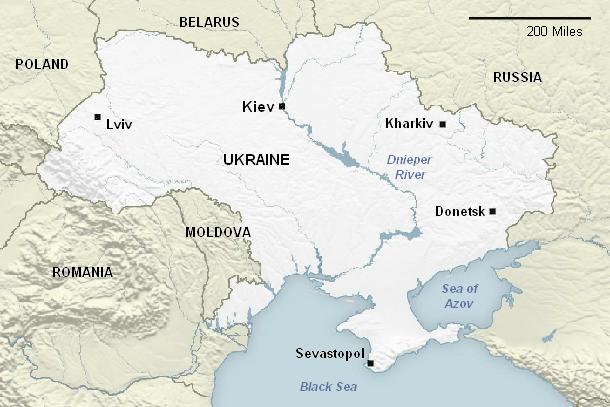
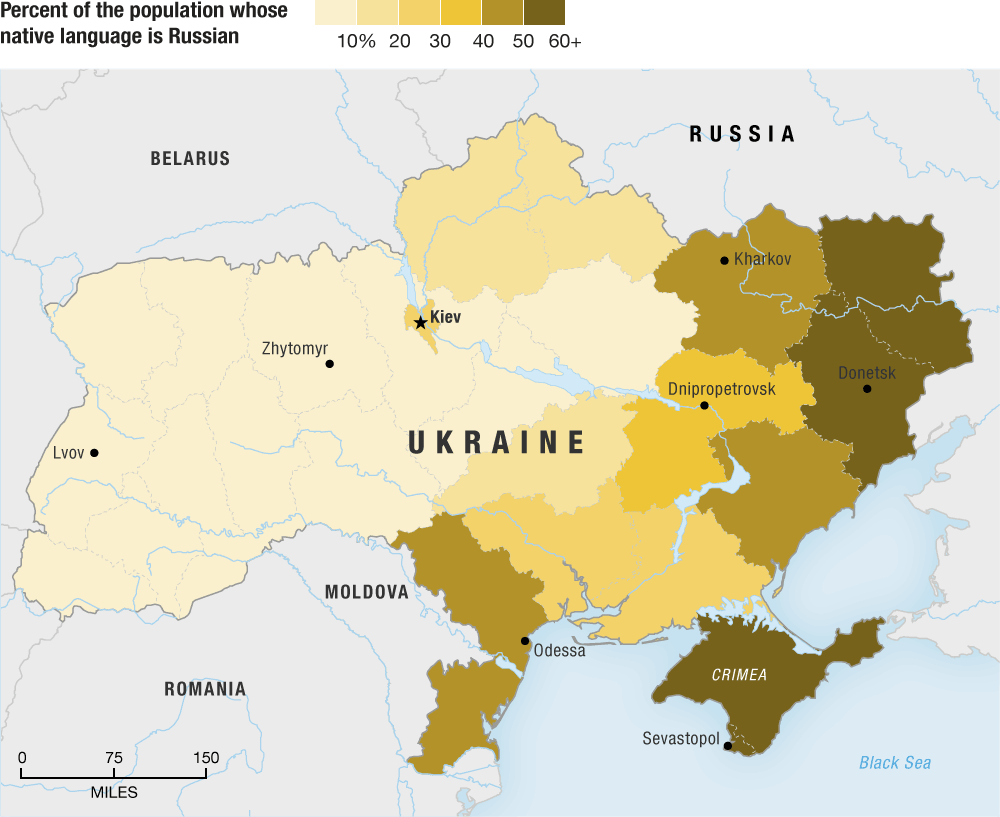
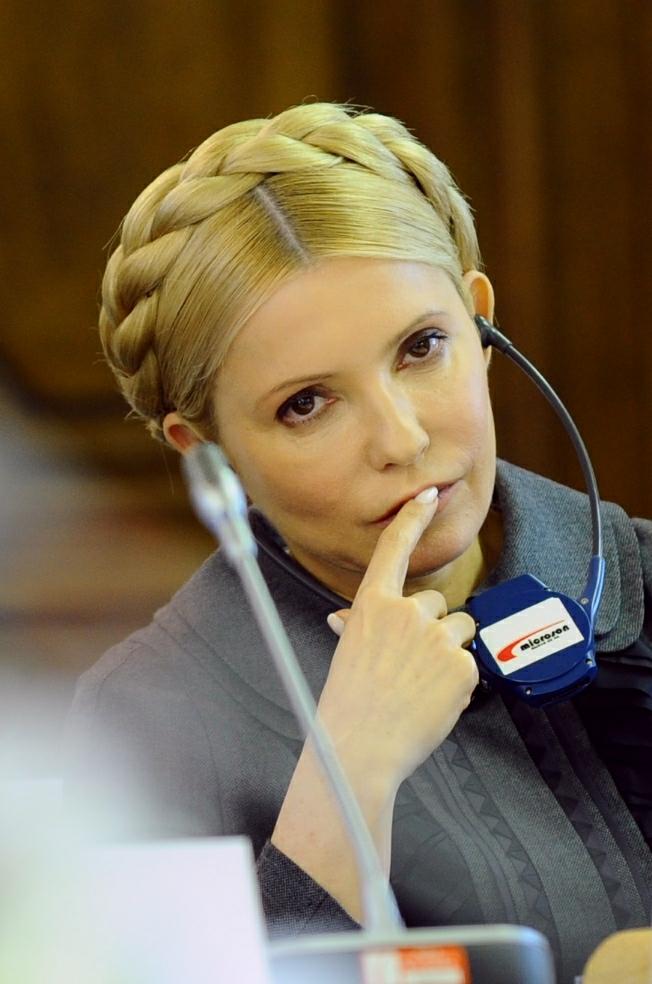
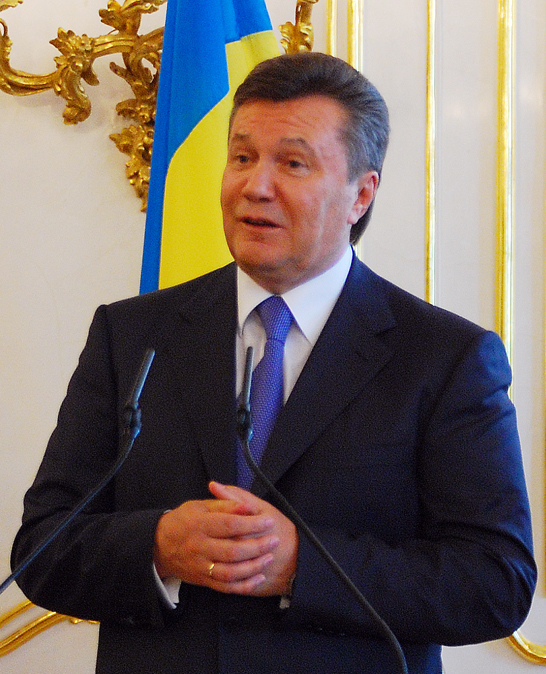
|
This
ethnic struggle is symbolized in the rivalry between
Ukrainian-speaking Yulia Tymoshenko who was Ukrainian Prime Minister
from 2007 to 2010 … and who in 2010 ran for the Ukrainian Presidency but lost to Russian-speaking Viktor Yanukovych.
Yanukovych then had her arrested and imprisoned for "corruption."
Ukrainians grow outraged at this blatantly political move.
|
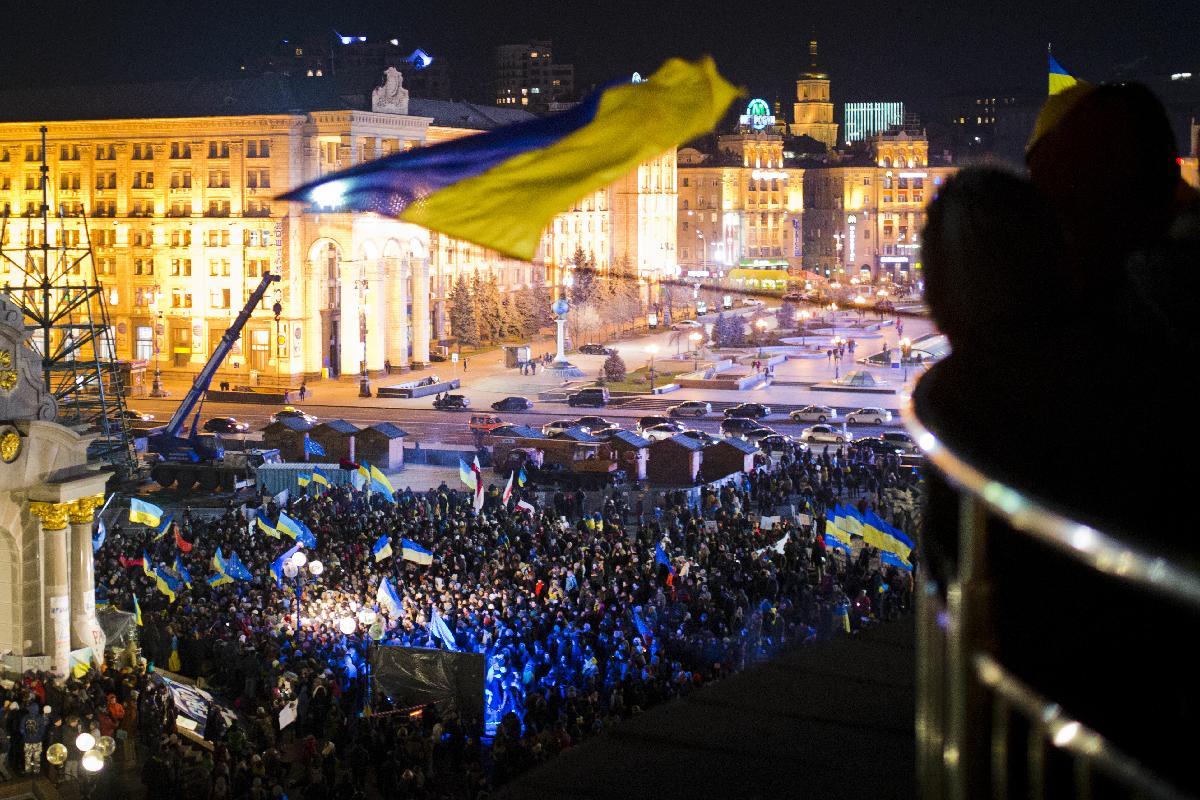
Protests begun in 2011 continue to occur sporadically
… turning violent by the beginning of 2014.
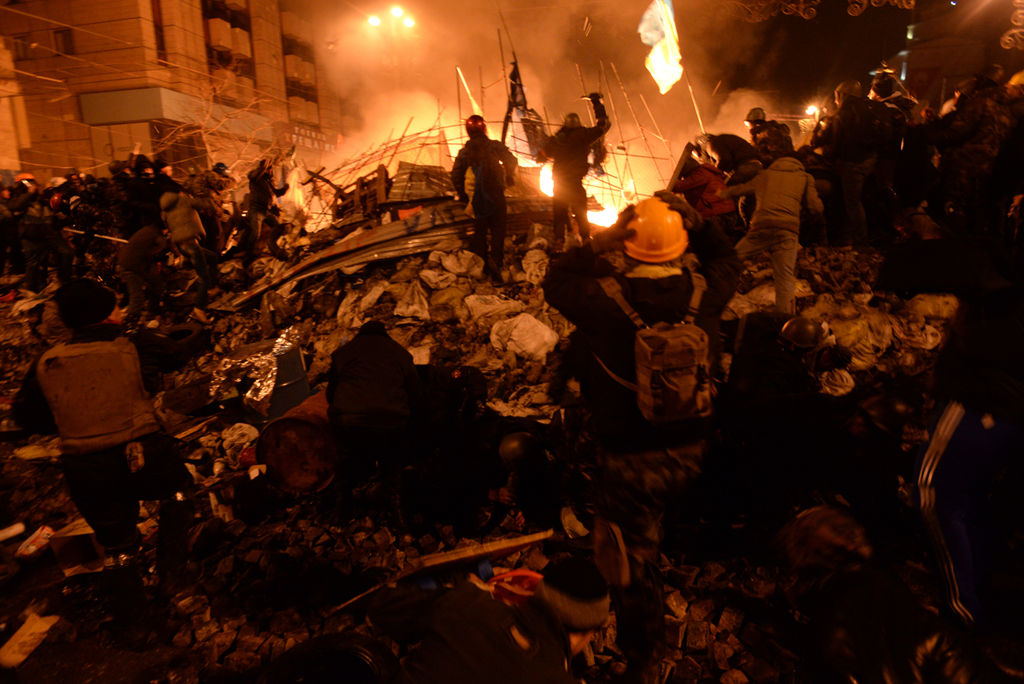
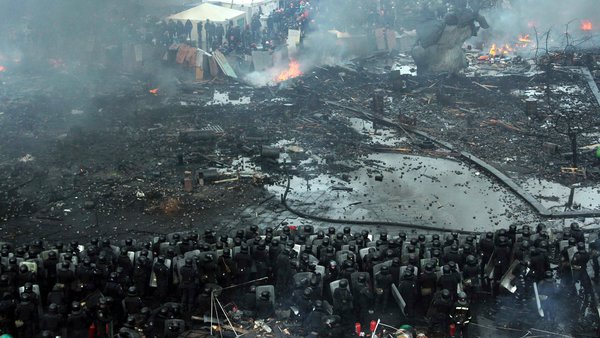
Putin's Russia invades Ukraine – February 2014
Tymoshenko is finally released from prison in February … and Yanukovich takes that as
the signal to abandon the Ukrainian presidency and head to the Russian-
speaking East … calling on Russian President Putin to come to his
aid.
At
this point (also February 2014) Putin decides that the
Russian-Ukrainian rivalry in Ukraine necessitates his intervention
(besides he has expansionist interests of his own, especially in the
joint Ukrainian-Russian naval base located at Sevastopol in Ukraine).
Obama
is quite upset and in a 90-minute phone call to Putin, urges him not to
invade Ukraine … or serious consequences would result.
|

Putin
ignores him … and sends masked and unmarked (no military insignias)
soldiers (termed "little green men" by the international press corps)
into the Russian-speaking Eastern provinces of Ukraine to "help his
neighbors suffering from Ukrainian persecution."
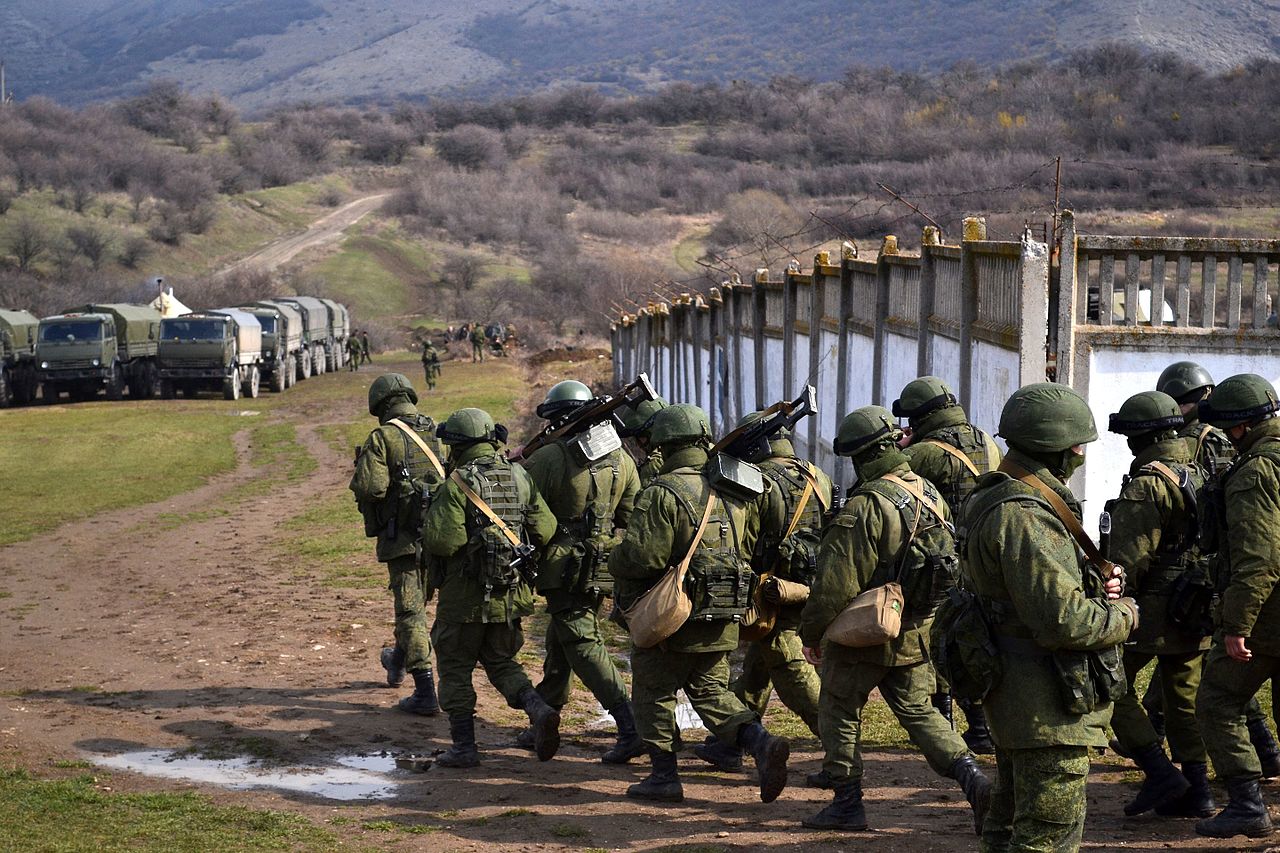
On
March 1st (2014) the Russian Parliament voted to send Russian troops
into Ukraine to "restore the rule of law and protect the population of
Ukraine" (although thousands of Russian soldiers were already in Ukraine
and had just seized key military bases in the east, including the
vital naval station at Sevastopol.
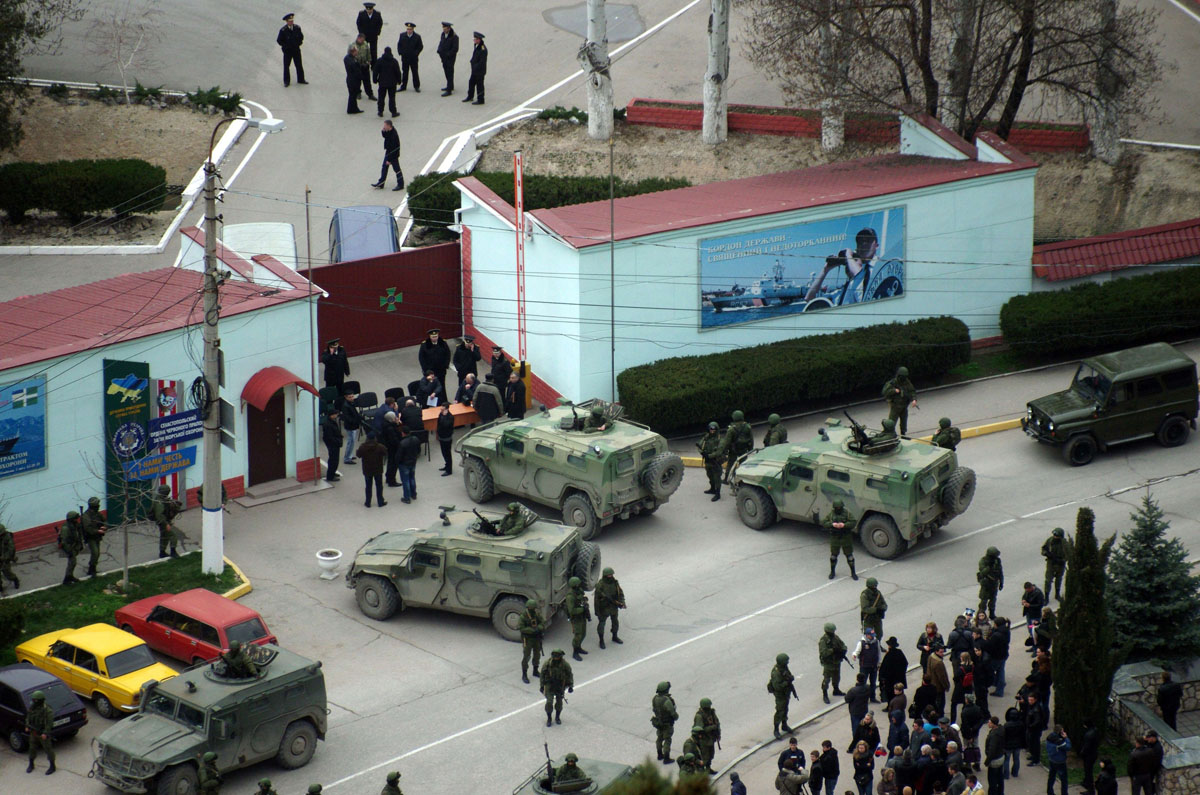
Pro-Russians were happy to greet their "liberators."
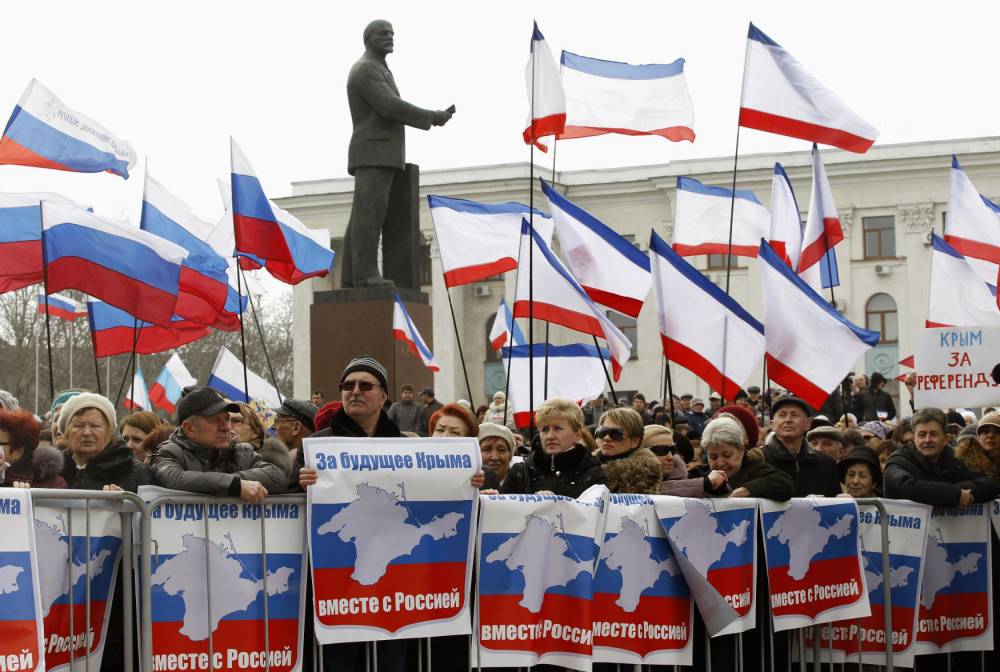
But
this was just the beginning of troubles in the Eastern areas around
Donetsk and Luhansk when the Ukrainian government fought to retake
the rebel provinces which in mid-March had voted to join Russia ...
though only Crimea was annexed formally.
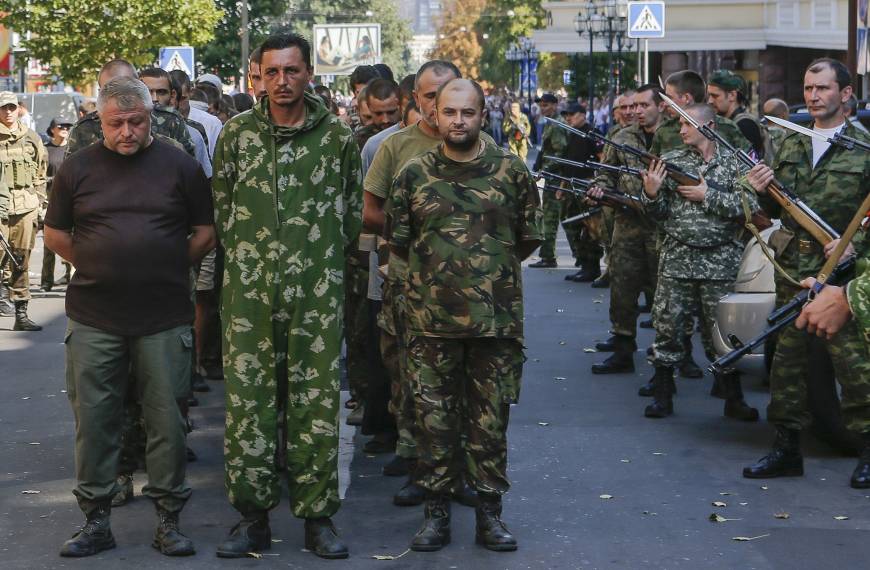
By August a stalemate had developed … and a small prisoner exchange was arranged. But the conflict would wear on … and on.
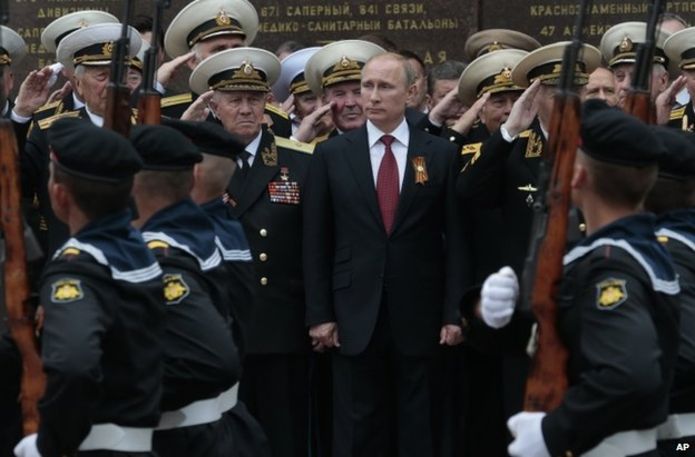 Putin arriving in the newly-seized Crimean naval base at Sevastopol … saluted by Russian naval officers for his bold action.
Putin arriving in the newly-seized Crimean naval base at Sevastopol … saluted by Russian naval officers for his bold action.
|
BRICS
BRICS is a grouping of Brazil, Russia, India and China formed in 2009 –
to which South Africa was joined in 2010 to make this grouping come to
be termed BRICS. Together, these five countries contain 42% of the
world's population … seeking a similar figure in terms of the world's
wealth – basically in competition with the G7 bloc of Canada, France,
Germany, Italy, Japan, Great Britain and America – this latter group
containing only 10% of the world's population but over half of the
world's wealth. The European Union (EU) serves also as something of an
associate G7 member … making the group essentially the economic (and
somewhat political) voice of the "West."
It is the understood goal of BRICS to replace the West as the
dominating force in world affairs, politically, economically, socially
and culturally. It is a curious matter for them to hold the goal of
mutual global dominance by 2050 – given the often-bitter rivalry
between India and China … and occasionally China and Russia. But having
the West as a mutual opponent serves to keep such unity in place ... at
least to some extent.
One of the items they wanted to put in place was a New Development Bank
– to rival the West-dominated and long-standing International Monetary
Fund (IMF). The purpose was to steady their own fluctuating currency
markets and create reserves for their own economic development.
However, China already takes care of itself in this matter – but
offered to take the lead in funding the bank … in order to take the
lead in BRICS itself. The goal was also to attract more countries to
their side of the East-West competition … by being able to extend
development monies to these other countries – something that China was
already very busy doing.
Indeed, as of the beginning of 2024, Iran, Ethiopia, Saudi Arabia,
Egypt, Argentina and the United Arab Emirates joined BRICS – making it
what … BRICSIESEAU? Some 35 other countries have also indicated a
desire to join the organization. This does not bode well for the
dollar-dependent Western industrial world … which is of course the
purpose of the BRICS venture in the first place.
From Deng to Xi
All of this is in keeping with China's express goal of making itself
the sole global superpower by the middle of the 21st century.
Tragically, Deng Xiaoping's effort to shape Chinese leadership into a
collective matter in order to prevent any further Mao-like
concentration of power in a single hand did not outlast Deng's stepping
down from Chinese leadership at the end of the 1980s.
Behind him came Jiang Zemin, who began the process of acquiring full
power as China's leader. He began his move to power in 1989 by taking
position as the General Secretary of the Chinese Communist Party … as
well as the vital Central Military Commission – Deng's only formal
office. Then in 1993, he took office as the country's president as well
– thus holding personally the reins to both party and civil government.
Thus when he stepped down from his various offices in 2002-2005 (the
last to leave being the Central Military Commission) such autocratic
power had once again become the style of Chinese leadership.
This understanding of the Chinese leader's role was then passed on to
the younger Hu Jintao, who also came to soon hold all three positions –
until he stepped down from those various offices in 2012 and 2013. And
he would be followed – in all three vital offices – by the very
ambitious Xi Jinping. Xi was actually groomed for that position all the
way back in 2007-2008, when Hu made him China's second in command in
both the party and civil governments.
Xi’s social-economic policy
Once in full power in 2013, Xi tightened his grip over Chinese life
even more than his predecessors. He interned into rather Mao-like
"reeducation" (concentration) camps some one million Turkic-Muslim
Uyghurs in the Xinjiang province … in order to make way for the
takeover of the region by Han ("true") Chinese. He tightened censorship
of the Chinese" wired" (internet) generation – and took up much of
Mao's style to develop a "cult of personality" … the usual way of
gaining popularity as the people's "tyrant" (the leader who does the
thinking for the people). Thus he also made himself the leader of the
National Security Commission … responsible for maintaining Chinese "law
and order" – thus full control of Chinese society at all levels of its
existence.
But his ambition was not only to lock down China under his grip … but
to bring the world under that same grip. And he would first use the
growing power of the Chinese economy and its highly disciplined (and
obedient) workforce to begin the process … before moving to more
ambitious diplomatic and then military means.
Actually, the economic move was made well before Xi arrived on the
scene … starting out with the West's encouragement of China to go down
the international corporate trade route … but allowing the Chinese
exemptions to the IMF's currency regulation requirements. In other
words, the Chinese were able to print enough currency (renminbi or
yuan) that it would make Chinese products incredibly cheaper than goods
produced in the West. The government was even allowed to subsidize
Chinese industry in its covering production costs to ensure that
Chinese products not only sold well abroad, but would be able to corner
the market for a number of goods. As a consequence, the Chinese economy
began to show such growth since 1990, that it doubled the value of the
Chinese economy every seven years!
Chinese profitability became so great that the Chinese government made
itself available to America to help cover its rapidly mounting national
debt – considered at first to be a very generous act … until it began
to dawn on Americans that China was actually purchasing economic
leverage on American government operations in a very subtle way.
In fact, everything that China did was very subtle … sort of like the
ancient Chinese board game of "Go" – the object of which is to be able
to place stones on the 19x19-block checkerboard so as to surround and
confine the opponent. This is why the Chinese agreed to form the close
economic relationship of BRICS in 2009-2010.
Thus the Chinese not only put themselves in a position at home to
dominate the market, under Xi's new leadership, they then also began to
"assist" other countries here and there – with their 2013 Belt and Road
initiative (also known as China's "New Silk Road" Initiative) – by
using their huge dollar reserves to invest and take leadership in
various sectors of the economies of these largely Third World countries
(but also most of the countries of East Europe) … especially in the
realm of the mining and production of very strategic raw materials.2 And they were playing the same games with not only America's position abroad but also with that of America's European allies.
Of course complaints were made to China at the point that it was clear
that Chinese benefits first extended to China – when it was struggling
to get moving down the industrial road – no longer were fair now that
China was the world's second largest national economy (after America).
And the American and European economies and rising unemployment in
their workforces were clearly taking a hit from the Chinese economic
policy.3 But Obama
quickly learned that the Chinese would not budge from their pivotal
position – when Obama's negotiators came back empty-handed from talks
with the Chinese. Why should China give up anything … when America and
the West had nothing to offer in exchange?
Xi takes charge of the South China Sea
Actually, Chinese ambitions in the South China Sea – which extends
south from China, passing the Philippines in the East and Vietnam in
the West and reaching all the way south to Malaysia and Indonesia – had
already begun (cautiously) even before Xi arrived on the scene. Even
Jiang, back in 2000, commented about the necessity of a great power to
possess a strong maritime presence … and by 2006 was using "law
enforcement ships" to police the South China Sea. Then Hu's 2008
comment about the country's need for self-defense was followed up the
next year with the publication of the nine-dash lines map, claiming
historic rights to the Exclusive Economic Zone (EEZ) which reached down
and across the South China Sea … to just a few miles off the shores of
the other countries surrounding that sea.
The Philippines and Japan had already come to strong disagreement with
China over China's territorial claims – and the way they were handled
in the matter of oil exploration and fishing rights in those waters –
when in 2009 Malaysia and Vietnam submitted to the U.N. their own
claims to those waters. And in 2010, Obama stated (via his Secretary of
State Hillary Clinton) that America had a very strong interest in
seeing the "open access to Asia's maritime commons" (the open high
seas) maintained – at a time at which Chinese-Americans relations were
reaching a very low point.
Then in 2011, the Spratly Islands to the West of the Philippines became
a hot issue when Chinese naval ships forced a Philippine ship to leave
the area … at a time when the Vietnamese were growing increasingly
irate at the harassment by Chinese ships of Vietnamese ships doing
exploratory work in what it claimed were Vietnam's offshore oil fields.
The following year (2012), Obama announced a "Pivot to Asia" strategy,
attempting to shift American foreign policy away from the Middle East
(a disaster at that point) and direct it more to East Asia. This
pleased Australia, Vietnam, Japan, Korea, etc. It upset even more Xi –
who read this as an American effort to impose itself into what China
considered the region that it was supposed to "lead" (willingly or not
on the part of its neighbors). However, Obama indicated that this new
policy was as much directed to the bettering of American-Chinese
relations as it was with the relations with its other Asian "partners."
Xi did not buy this explanation at all.
That was also the year that China launched its first aircraft carrier.
In 2013, the Philippines challenged China before the U.N. Permanent
Court of Arbitration for violating the U.N. Convention on the Law of
the Sea (UNCLOS). But China simply refused to submit itself to
arbitration – claiming that the U.N.-appointed tribunal lacked
jurisdiction in the matter. Thus a 2016 verdict in favor of the
Philippines was simply ignored by China.
While all this was going on, China began to dredge some reefs in the
Spratly Islands, creating an island – on which they could then build an
airstrip and naval and military facilities … clearly to put muscle
behind their territorial claim to the entire South China Sea. By 2016,
work there was completed.
And what was Obama's response in his Pivot to Asia? As Xi expected,
Obama was a man of words – and little else. Why hadn't Obama ordered
the dredging of his own island … to put some kind of muscle behind the
rightful claim that this was "high seas" – vital to the economies of
all surrounding nations – and not the exclusive territorial possession
of China? Thus like the game of Go, this was a big China win –
and an equally big loss by America and the West … from which there
would be no opportunity for a comeback.
2The
number of countries brought into this Chinese game would come soon to
be more than 150 countries … with 75 percent of the world's population
and over half of the world's production capacity.
3Obama's
Democratic Party would also be hit hard by these sad economic
developments in the 2010 Congressional elections – which led to a
Republican takeover of the House – and a gain of seven seats in the
Senate (though not yet a Republican majority) … as well as large
Republican gains in the states' and cities' elections.
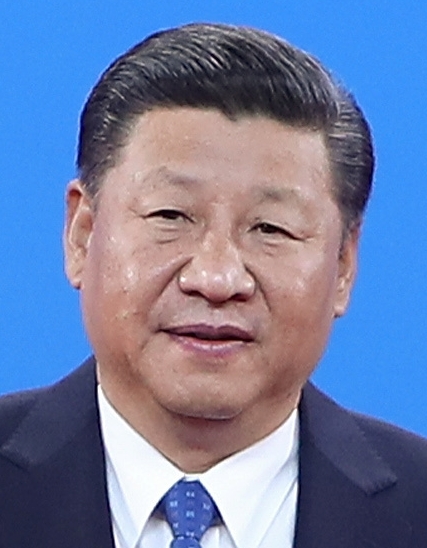
The world stood in shock as Xi Jinping’s China begins to press
forward most forcefully its territorial claim to the waters (and
islands) of the South China Sea … ignoring all current standards concerning the neutrality of the high seas.
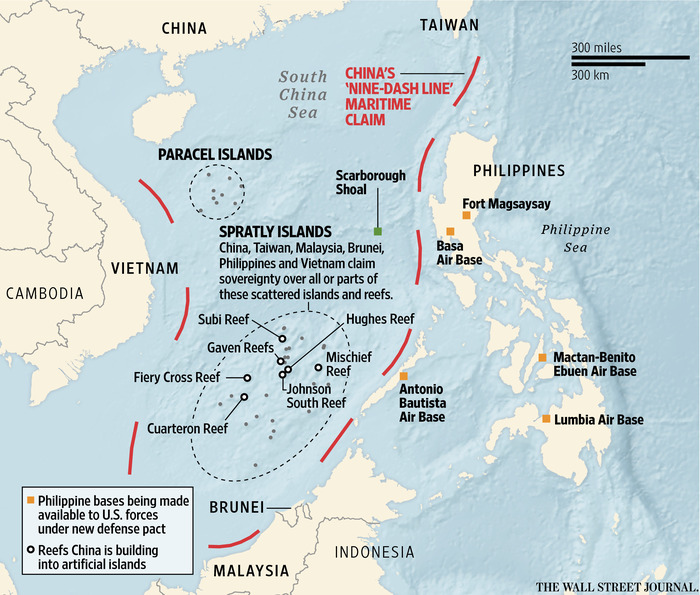
The area is of vital importance to the commerce and economy of many nations
that surround the South China Sea.
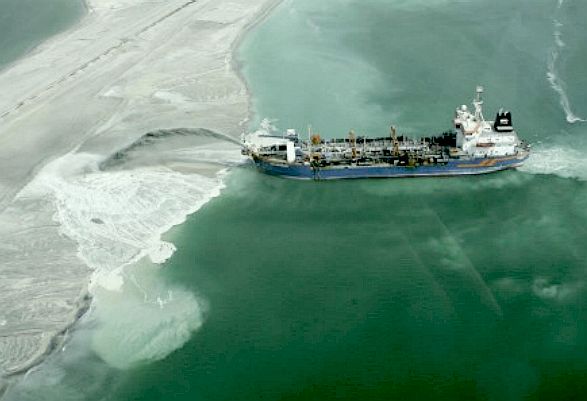
To
enforce these territorial claims, the Chinese in 2015 begin to dredge
the waters surrounding a number of coral reefs located in the South
China Sea
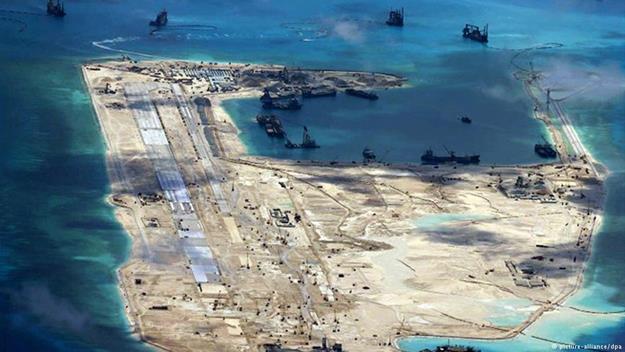
… to fill them in with land so as to construct airfield and
naval bases on these newly man-made
islands.
The world watches in horror ... but does nothing. This includes the world's major
superpower, America – or its President Obama – to stop this territorial grab.
Although
very conservative Muslims had taken control of Iran with the fall of
the Shah in 1979, there remained in Iran a large portion of the
population that was quite "modern" and pro-West … even though
supportive of the country's new Islamic Republic. Tragically, during
the first years of the new Islamic Republic under presidency of the
Muslim cleric Ayatollah Ali Khamenei (1981-1989) – and the overall
direction of the country by the Supreme Leader Ayatollah Ruhollah
Khomeini – the treatment of such pro-Westerners was quite harsh … with
thousands (the actual figure unknown) of Iranians being killed by the
decisions of the revolutionary courts, controlled by the Revolutionary
Guards.
When Khomeini died in 1989, Khamenei took his position as Supreme
Leader – although the country actually moved to a more "modernist"
position with Akbar Hashemi Rafsanjani becoming Iran's president. Then
in 1997 Rafsanjani was followed in office by the cleric Mohammad
Khatami – who basically continued Iran's democratic reforms …
irritating the Islamic conservatives in the process. And in 2005, with
Rafsanjani eligible to run again as president, he found himself up
against the arch-conservative Tehran mayor Mahmoud Ahmadinejad. The
elections that year went strongly in favor of Ahmadinejad – 61.7
percent to Rafsanjani's 35.9 percent. Thus it was that Iran turned back
to being again a very militant Shi'ite Muslim Republic ... very hostile
to the West – and America in particular.
When elections took place then in 2009, Iran exploded into violence
when Ayatollah Khamenei came out strongly for Ahmadinejad – who again
won with a resounding 62.6 percent of the vote against the centrist Mir
Hossein Mousavi with 33.7 percent – and some 14 million unused ballots
were discovered (along with other voting irregularities).
Anti-Ahmadinejad protesters took to the streets (the Green Movement),
only to be opposed by Ahmadinejad supporters – and the situation turned
very ugly. Interestingly, America and the West stood with the
protesters in their view of the integrity of the election, whereas
Asian (including China), African, and Latin American countries
supported Ahmadinejad. In any case, Ahmadinejad was soon able to bring
things back under control … and continue to move the country down the
very conservative Shi'ite Muslim road.
But there was another issue that drew the West into great concern about
developments in Iran. Ahmadinejad had been pressing forward the matter
of nuclear development in Iran – finding the U.N. in opposition because
this development violated a number of international agreements.
Ahmadinejad protested that Iran's nuclear development was strictly for
low-level atomic energy production … not for military purposes. But
with Iran sitting on top of one of the world's largest oil and gas
reserves, the need for nuclear energy made little economic sense.
Furthermore, it was known that Iran was working hard to develop its
missile technology. America and the West were very unhappy. But there
was little they could do.
Then with the election in 2013 of the cleric – but a modernist reformer
– Hassan Rouhani as Iranian president, Iran moved to improve relations
with the West. The huge issue that had to be dealt with was Iran's
nuclear program. Negotiations between Iran and the U.N. Security
Council members, plus Germany, thus got underway over this matter …
resulting in the 2015 Joint Comprehensive Plan of Action (JCPOA). Under
this plan, Iran agreed to undo much of its nuclear program and allow
inspectors to inspect its nuclear sites to confirm that they were in
conformity with the agreement – Iran in return having its oil markets
again open to the West and having banking assets abroad that had been
previously seized now released in stages.
Obama and his secretary of state Kerry assured America that this was
the best way to keep Iran (at least for the foreseeable future) from
developing nuclear weapons. Others however, and most notably Israel,
were very unconvinced that Iran would not find some way to continue
weapons development out of sight of the inspectors. And the Iranian
further development of its missile technology was of enormous concern
to Israel – especially given the many statements that Iran liked to
make about bringing the West to its knees. But JCPOA would be accepted
by Washington – at least as long as Obama remained as America's
president.
|
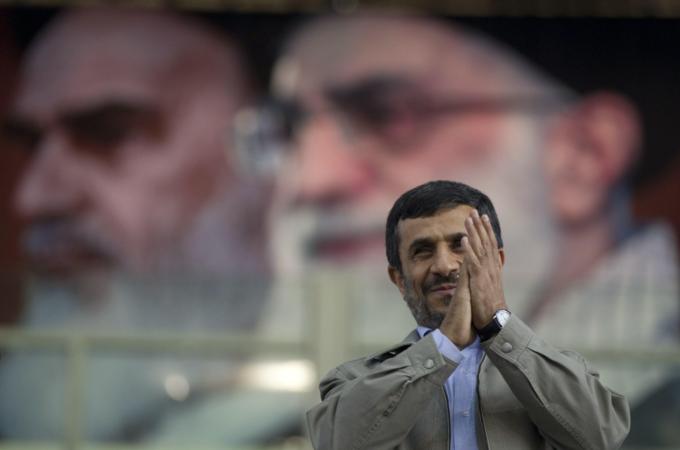 Mahmoud Ahmadinejad
Mahmoud Ahmadinejad
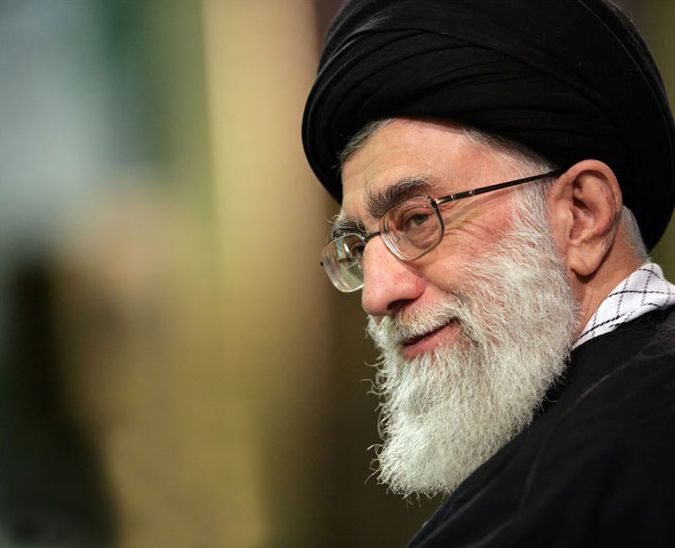 Ayatollah Seyed Ali Khamenei,
Superme Leader of Iran
Ayatollah Seyed Ali Khamenei,
Superme Leader of Iran
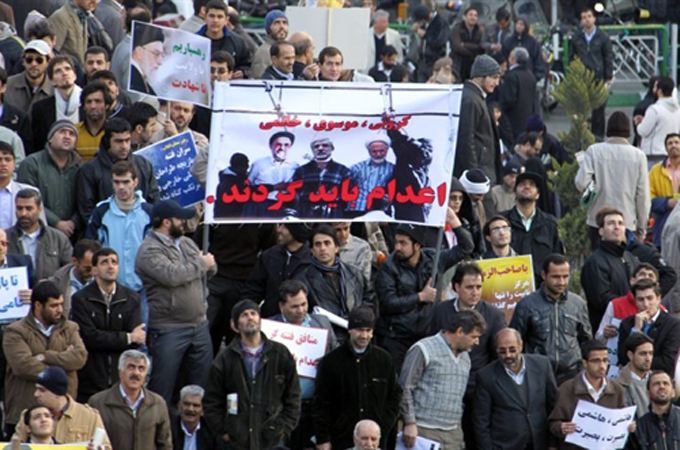
Iranian government supporters
calling for the execution of Mousavi and Karroubi - February
2011
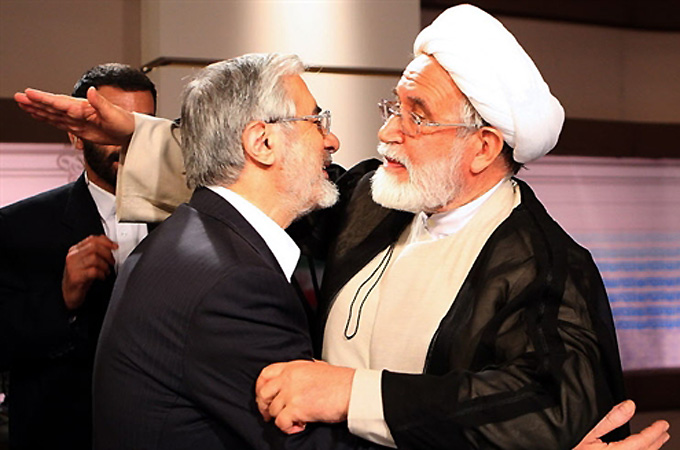
Iran will not respond to
international questions about the whereabouts of Mousavi, left,
and
Karroubi

Mohammad Khatami
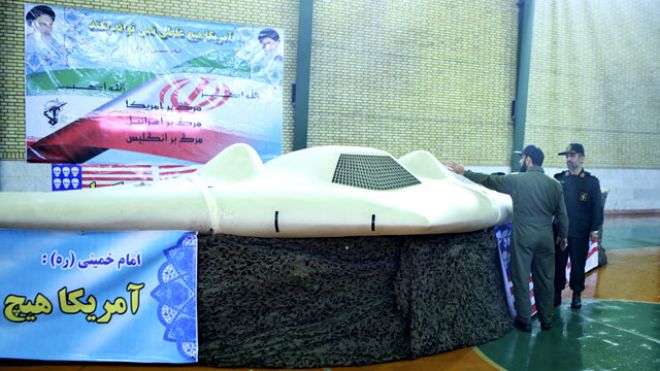 A photo (Dec. 8, 2011) by
the Iranian Revolutionary Guards showing a U.S. RQ-170
A photo (Dec. 8, 2011) by
the Iranian Revolutionary Guards showing a U.S. RQ-170
Sentinel drone that Tehran says its forces
downed
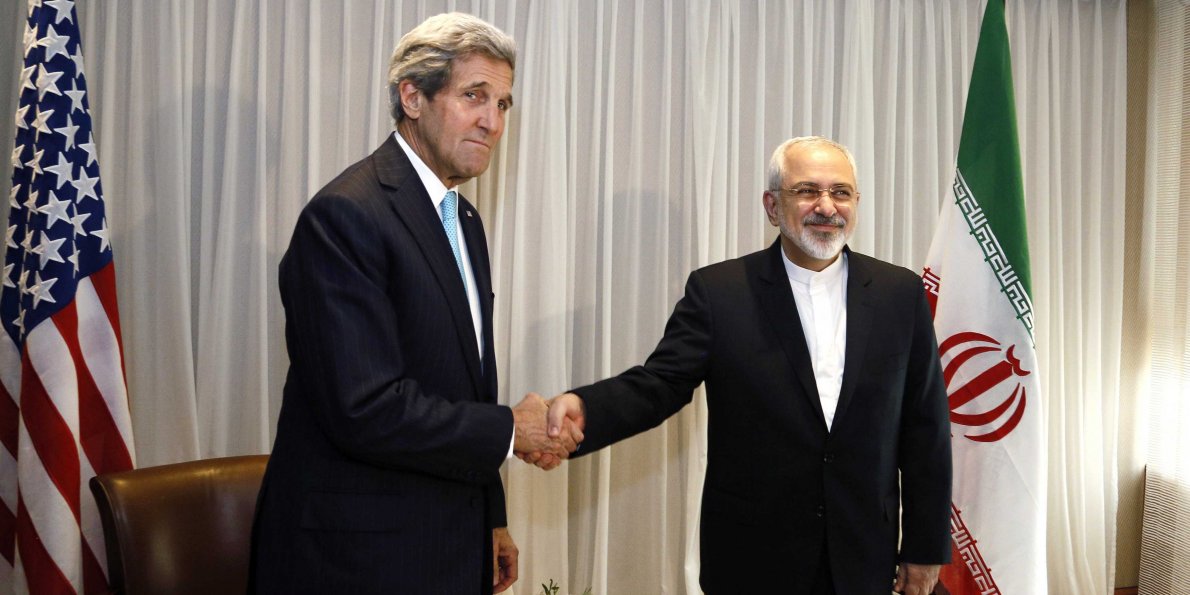
US Secretary of State John Kerry shaking hands with Iranian Foreign Minister Mohammad Javad Zarif, agreeing to begin talks concerning an Iran nuclear deal – Geneva, January 14, 2015
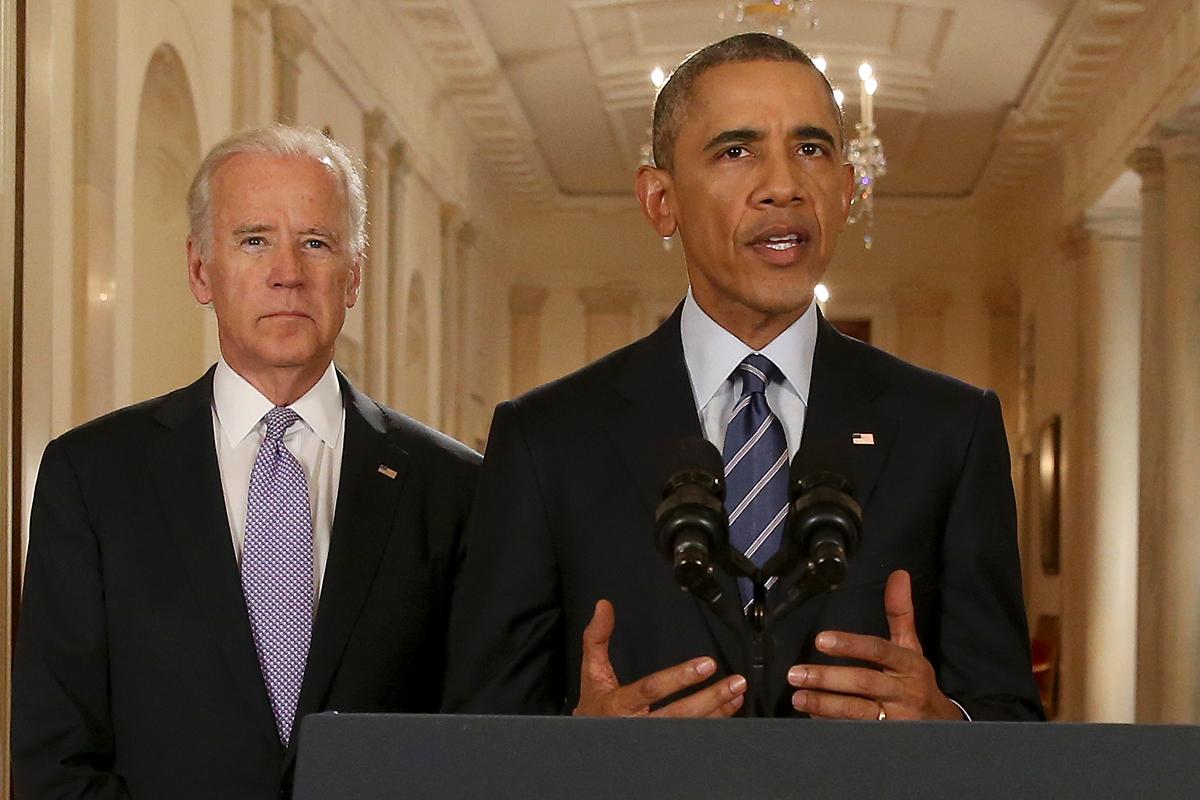
Obama announces agreement on the deal – July 14, 2015

Go on to the next section: Issues Elsewhere
 Miles
H. Hodges Miles
H. Hodges
| | | |


 Obama and the Arab world
Obama and the Arab world
 The takedown of bin Laden (2011)
The takedown of bin Laden (2011)
 Action in Libya against Gaddafi
Action in Libya against Gaddafi











 President Obama announces the death
of Osama bin Laden
– 11:00 p.m. that same night
President Obama announces the death
of Osama bin Laden
– 11:00 p.m. that same night
















 An image captured by cellphone showing a battered Qaddafi just before his on-the-spot execution
An image captured by cellphone showing a battered Qaddafi just before his on-the-spot execution






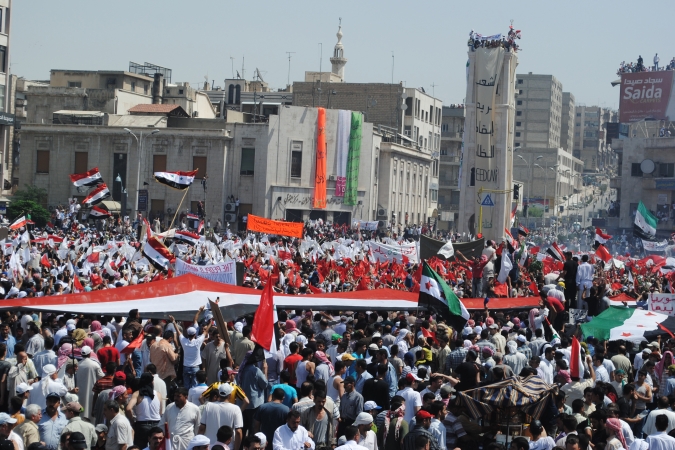
 Obama took a lot of flack for his "Red Line"
threat!
Obama took a lot of flack for his "Red Line"
threat!



















































































 Putin arriving in the newly-seized Crimean naval base at Sevastopol … saluted by Russian naval officers for his bold action.
Putin arriving in the newly-seized Crimean naval base at Sevastopol … saluted by Russian naval officers for his bold action.




 Ayatollah Seyed Ali Khamenei,
Superme Leader of Iran
Ayatollah Seyed Ali Khamenei,
Superme Leader of Iran


 A photo (Dec. 8, 2011) by
the Iranian Revolutionary Guards showing a U.S. RQ-170
A photo (Dec. 8, 2011) by
the Iranian Revolutionary Guards showing a U.S. RQ-170


